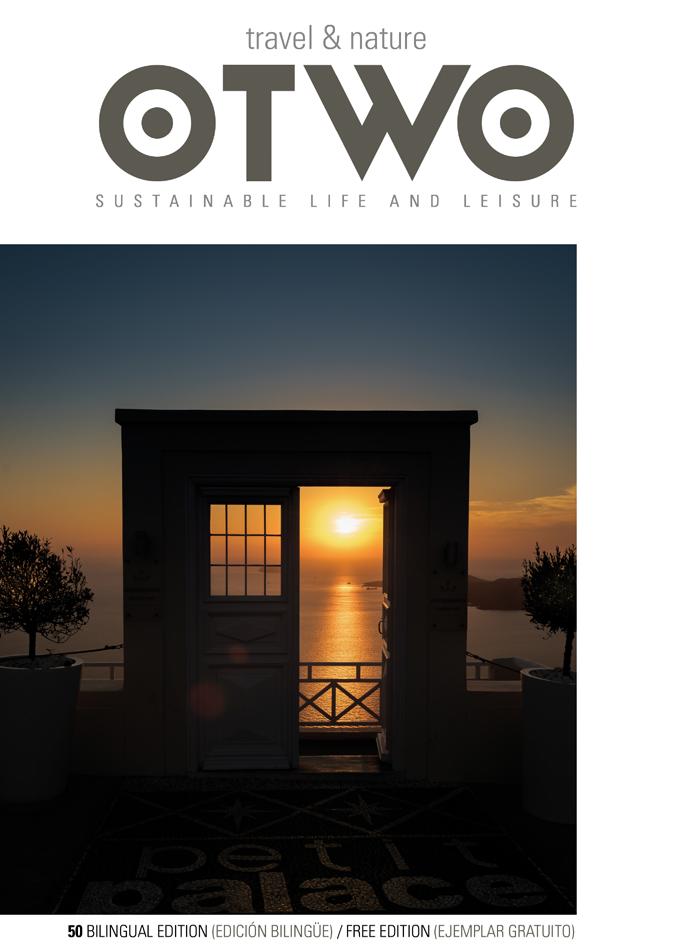
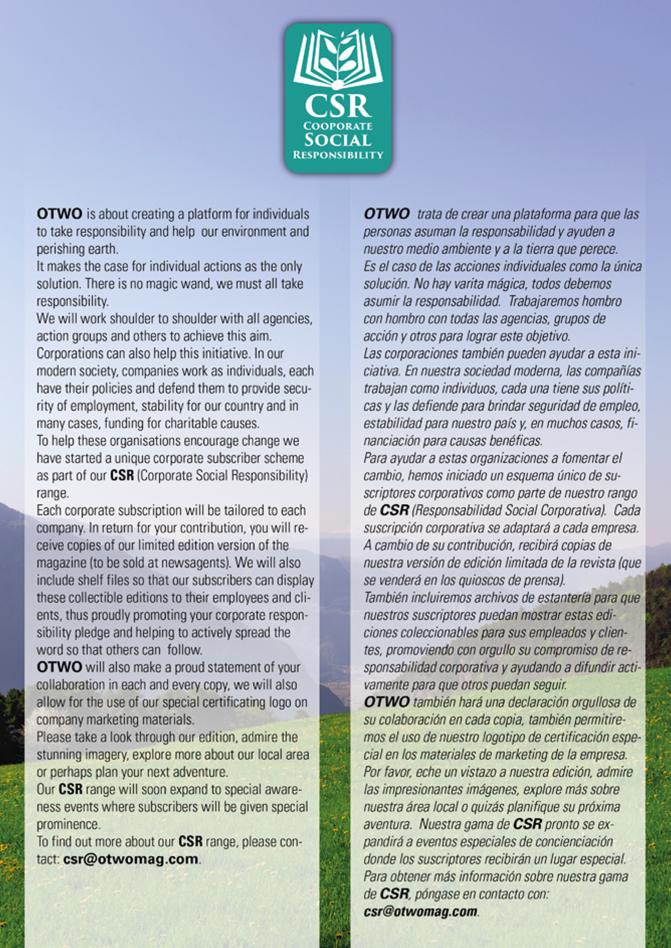
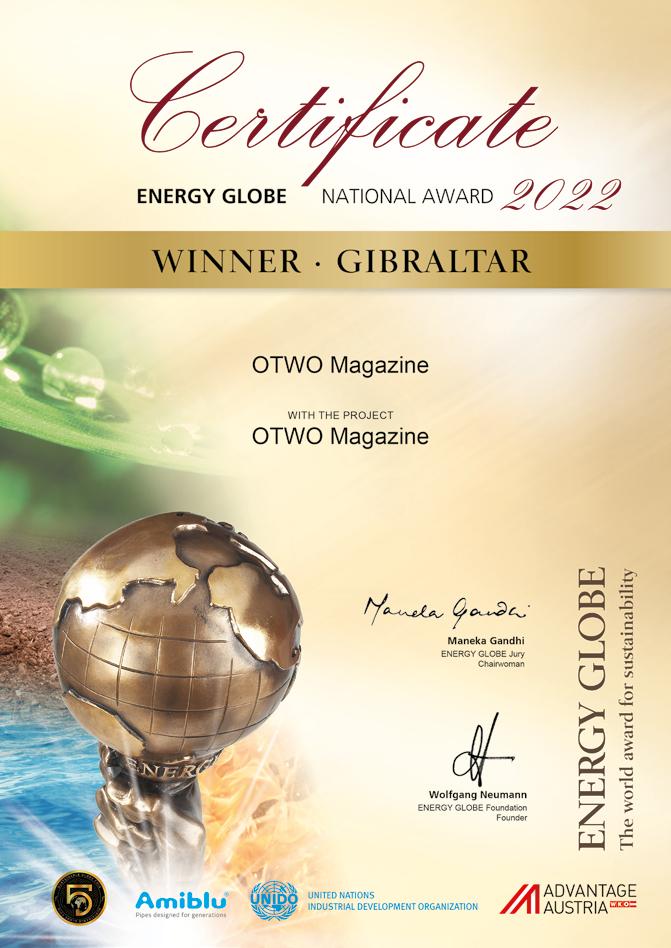
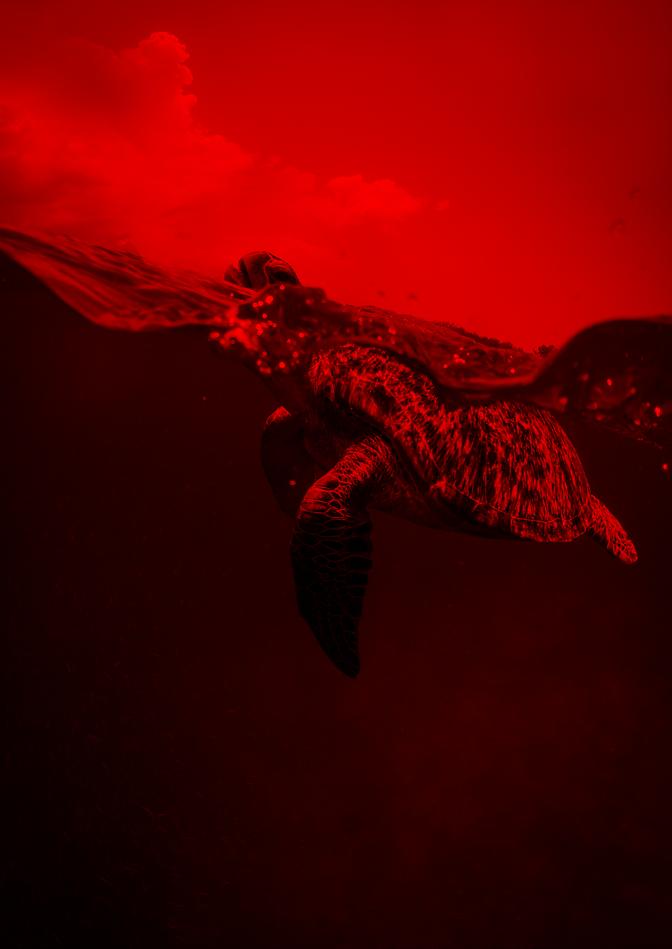
www.otwomag.com
You don't have to choose between light and dark.





www.otwomag.com
You don't have to choose between light and dark.
This volume was published in September 2023 by Oxygene Ltd. OTWO Issue 50
Oxygene Ltd.Business Centre.
19 George´s Lane.
GX11 1AA, Gibraltar Tel. +00350 54001271
www.oxygenecommunications.com
© Publishing: Oxygene Ltd.
Vanessa Byrne
Managing & Commercial Director
Juanjo Trujillo
Creative Director & Chief Designer
Margaryta Haiduk
Marketing and Sales Manager
Paula Mateos Social Media Manager
Photographer: P4K1T0, Juanjo Trujillo, Eco Deco, María José Romero, Pexels, Enrique Freire, Daniel Capilla,Holger Krisp,Algaebase. org / María Altamirano Jeschke, Anthony Pitaluga, Peakpx, Raquel Collante, EBikes, Mercedes Versaci-Insúa, Juan Luis González, Proema.
Cover photo: George Desipris. Back cover photo: Jill Burrow.
All rights reserved. No part of this publication may be reproduced, stored in a retrieval system or transmitted in any form or by any means, electronic, mechanical, photocopying, recording or otherwise, without the prior permission in writing from the publishers.
All rights reserved. ISSN 2633-7401
4 Editorial
10 NewShorts
20 Culture in green
24 DAhabiTAt
28 Revolutionary e-WATTS Technology Offers Sustainable Solution to Gibraltar's Wastewater Woes
36 Eco Decor
42 Schmidt Designs
54 Habitat COAMBA: Nutrient Uptake Kinetics in the macroalgae Ulva rigida and Ericaria selaginoides in the context of coastal eutrophication
72 The sound of the stone
86 The Italian Experience. Chapter 8
104 Narrowing the Strait.
118 Nature´s Way
120The flower of the month
No hace faltas que escojas entre luz y oscuridad. Apúntate al Movimiento OTWO
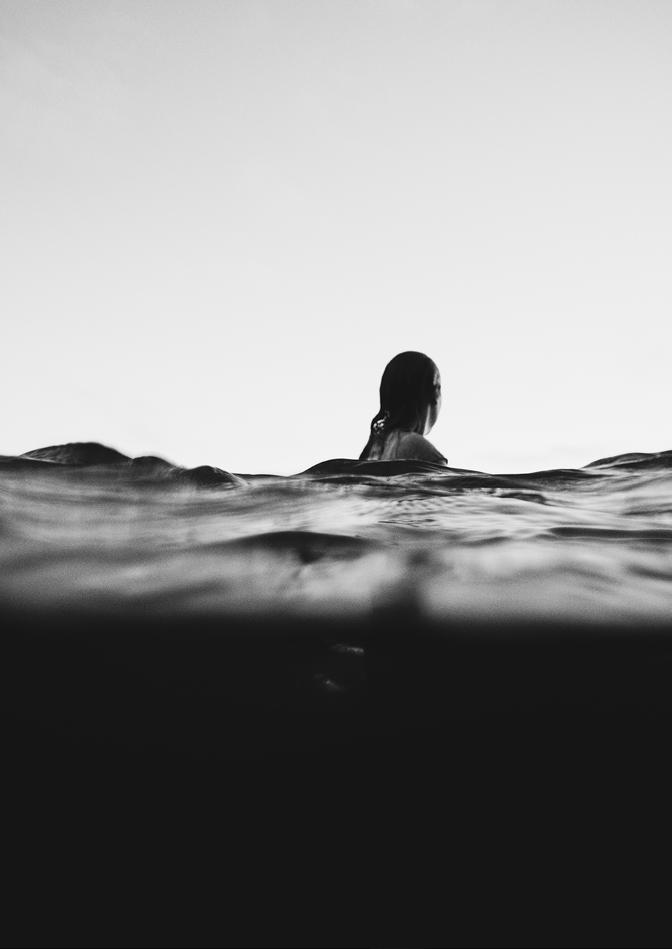
122 Clubhouse Minds
124 The Natural Swap

129 Eco Traveller
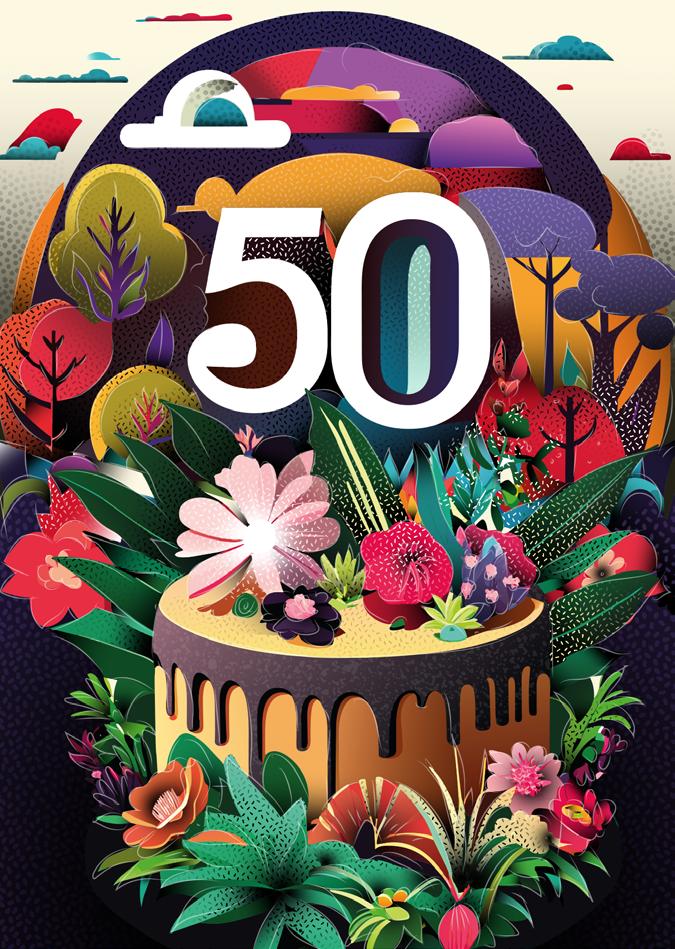
In an ever-evolving world, OTWO Magazine has stood strong for 50 months, amplifying sustainable awareness, solutions, events, and innovative ideas.
This 50th edition is a testament to the magazine's role in shaping global change and highlighting our shared responsibility for the planet.
From the outset, OTWO Magazine has served as a catalyst for sustainable transformation. Each issue has delved into vital environmental issues, equipping readers with knowledge to become drivers of positive change.
In this month’s edition we find in our "News Shorts" section diverse challenges, from oil spills to legal advancements in environmental protection, illuminating the spectrum of our planet's needs.
Page 20 merges culture and sustainability, spotlighting books, films, podcasts, and events that deepen our understanding of the environment. This fusion underscores that sustainability isn't just about nature but encompasses art, culture, and mindful living.
The exclusive feature on e-WATTS technology (Page 28) presents a revolutionary solution for Gibraltar's wastewater concerns. It highlights how technology and sustainability intersect to address pressing environmental issues.
Aligned with National Financial Awareness Day, Trusted Novus Bank's article on budgeting (Page 32) underscores the symbiosis of financial well-being. It's a reminder that our financial choices impact the environment and our well being, promoting a holistic approach to conscious living.
Page 36 introduces Ireana Schwock, an upcycling advocate and sustainable decorator. Her story mirrors the innovative solutions individuals bring. The upcoming Eco Festival promises a celebration of creativity and eco-consciousness, inviting all to participate.
Page 42 spotlights Schmidt's sustainable kitchen designs, showcasing innovation's power to reshape industries sustainably.
Page 54's scientific article by Maria Jose Romero Perez (COAMBA) dives into nutrient uptake kinetics in macroalgae, bridging science and environmental
protection. It showcases how research informs sustainable decisions in combatting coastal eutrophication.
Page 72 narrates "The Sound of the Stone," a poignant tale reminding us that sustainability preserves not just nature but our heritage too, revealing the stories embedded in our landscapes.
Page 86's Italian journey and Page 104's explorations demonstrate that sustainability enriches our experiences. These narratives celebrate the harmony of discovering our world responsibly.
Owen Wiseman's exploration of nature's healing properties (Page 118) emphasizes how integrating nature into healthcare settings reduces stress and fosters community, illuminating the potential of sustainable solutions.
Page 120's "Flower of the Month" and other features underline the deep connection between humanity and nature. Keith Bensusan's spotlight on the Southern or Autumn Colchicum encapsulates the delicate equilibrium we share.
Page 122 introduces "Clubhouse Minds," linking mental health and sustainability. These personal narratives reinforce the intrinsic link between our well-being and the planet's health.
Page 124's "The Natural Swap" offers actionable tips for everyday eco-consciousness, encouraging small changes with significant impact.
Page 129's "EcoTraveller" beckons readers to relish nature's wonders close to home, inspiring appreciation for our environment.
As we celebrate 50 months of OTWO Magazine, this anniversary edition affirms its role as a beacon for sustainable transformation. It emphasizes that sustainable progress encompasses science, culture, technology, and personal commitment. With each turn of the page, readers don't just observe change; they actively participate in the narrative of global betterment.
I hope you all enjoy reading this as much as we enjoy creating every edition.
Peace and love to all.
En un mundo en constante evolución, OTWO Magazine se ha mantenido firme durante 50 meses, amplificando la conciencia sostenible, soluciones, eventos e ideas innovadoras. Esta 50ª edición es un testimonio del papel de la revista en la configuración del cambio global y en la puesta de relieve de nuestra responsabilidad compartida para con el planeta.
Desde sus inicios, OTWO Magazine ha servido de catalizador para la transformación sostenible. Cada número ha profundizado en cuestiones medioambientales vitales, dotando a los lectores de conocimientos para convertirse en impulsores de un cambio positivo.
En la edición de este mes encontramos en nuestra sección «News Shorts» diversos retos, desde vertidos de petróleo hasta avances legales en la protección del medio ambiente, que iluminan el espectro de las necesidades de nuestro planeta.
La página 20 fusiona cultura y sostenibilidad, destacando libros, películas, podcasts y eventos que profundizan en nuestra comprensión del medio ambiente. Esta fusión subraya que la sostenibilidad no se limita a la naturaleza, sino que abarca el arte, la cultura y la vida consciente.
El artículo exclusivo sobre la tecnología e-WATTS (página 28) presenta una solución revolucionaria para los problemas de aguas residuales de Gibraltar. Destaca cómo la tecnología y la sostenibilidad se entrecruzan para abordar problemas medioambientales acuciantes.
En consonancia con el Día Nacional de la Concienciación Financiera, el artículo de Trusted Novus Bank sobre la elaboración de presupuestos (página 32) subraya la simbiosis del bienestar financiero. Es un recordatorio de que nuestras decisiones financieras afectan al medio ambiente y a nuestro bienestar, promoviendo un enfoque holístico de la vida consciente.
La página 36 presenta a Ireana Schwock, defensora del upcycling y decoradora sostenible. Su historia refleja las soluciones innovadoras que aportan las personas. El próximo Festival Ecológico promete una celebración de la creatividad y la conciencia ecológica, invitando a todos a participar.
En la página 42, los diseños de cocinas sostenibles de Schmidt ponen de manifiesto el poder de la innovación para reconfigurar industrias de forma sostenible.
En la página 54, un artículo científico de María José
Romero Pérez (COAMBA) se adentra en la cinética de absorción de nutrientes por las macroalgas, tendiendo un puente entre la ciencia y la protección del medio ambiente. El artículo muestra cómo la investigación contribuye a la toma de decisiones sostenibles en la lucha contra la eutrofización costera.
La página 72 narra «El sonido de la piedra», una conmovedora historia que nos recuerda que la sostenibilidad no sólo preserva la naturaleza, sino también nuestro patrimonio, revelando las historias que encierran nuestros paisajes.
El viaje italiano de la página 86 y las exploraciones de la página 104 demuestran que la sostenibilidad enriquece nuestras experiencias. Estas narraciones celebran la armonía de descubrir nuestro mundo de forma responsable.
La exploración de Owen Wiseman de las propiedades curativas de la naturaleza (página 118) subraya cómo la integración de la naturaleza en los entornos sanitarios reduce el estrés y fomenta la comunidad, iluminando el potencial de las soluciones sostenibles.
La «Flor del mes» de la página 120 y otros artículos subrayan la profunda conexión entre la humanidad y la naturaleza. El artículo de Keith Bensusan sobre el Colchicum meridional u otoñal resume el delicado equilibrio que compartimos.
La página 122 presenta "Clubhouse Minds", que vincula salud mental y sostenibilidad. Estos relatos personales refuerzan el vínculo intrínseco entre nuestro bienestar y la salud del planeta.
En la página 124, "El intercambio natural" ofrece consejos prácticos para una conciencia ecológica cotidiana, fomentando pequeños cambios con un impacto significativo.
En la página 129, "EcoViajero" invita a los lectores a disfrutar de las maravillas de la naturaleza cerca de casa, inspirando el aprecio por nuestro medio ambiente.
Al celebrar los 50 meses de la revista OTWO, esta edición de aniversario reafirma su papel de faro de la transformación sostenible. Subraya que el progreso sostenible abarca la ciencia, la cultura, la tecnología y el compromiso personal. Con cada vuelta de página, los lectores no se limitan a observar el cambio, sino que participan activamente en la narrativa de la mejora global.
Espero que todos disfruten de su lectura tanto como nosotros disfrutamos creando cada edición.
Paz y amor para todos.
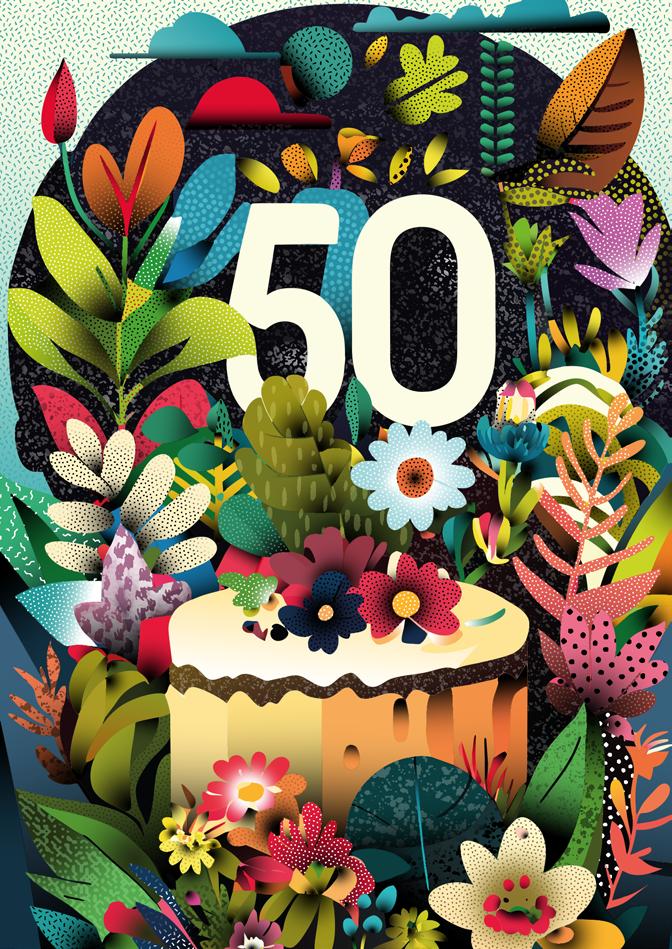
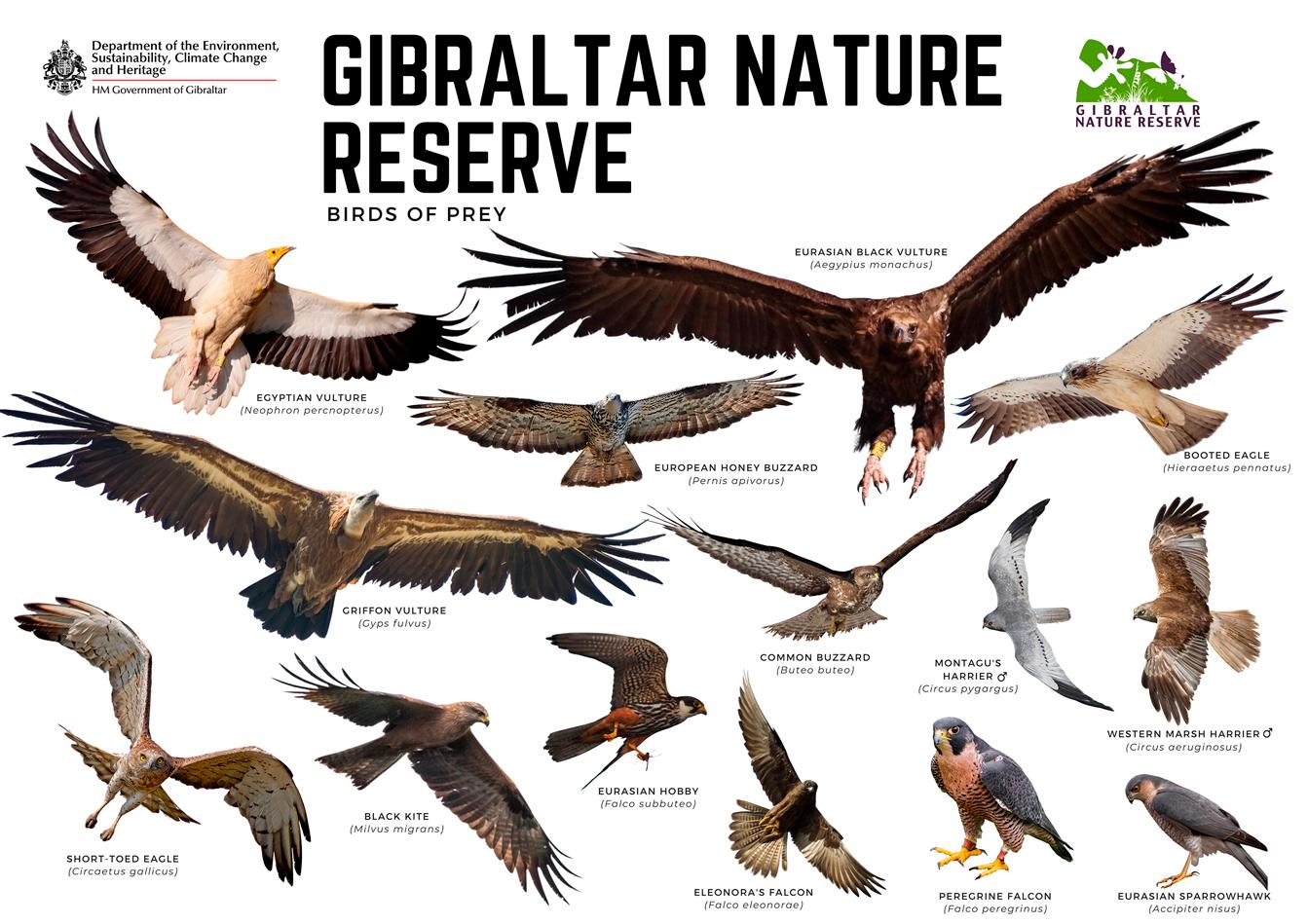
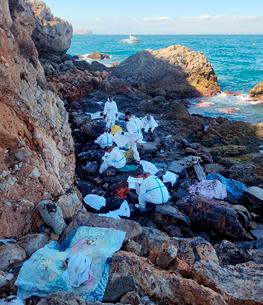
On the 1st August at 8:22am an incident occurred in our Gibraltar shores, a vessel taking bunkers experienced an overflow of its tanks and an emergency was quickly raised by the Gibraltar Port Authority. A strategic coordinating group was established by His Majesty’s Government of Gibraltar, chaired by the Minister for Civil Contingencies Samantha Sacramento, attended by the Minister for the Port Vijay Daryanani and the Minister for Environment John Cortes, the group convened and assessed the situation.
It was confirmed that the oil spilled from the Gas
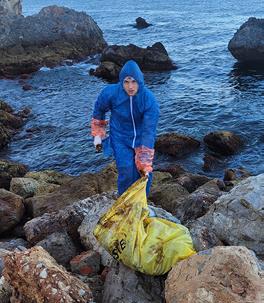
Venus was very low sulphur fuel oil with a rough estimate of between 1000 and 2000 litres spilt to sea. Developments were closely monitored as beaches were immediately closed off as oil was expected to reach the shores, the public urged to report any oiled wildlife or seabirds to the relevant departments. Early indications showed that the impact of the oil spill was limited to the area of Camp Bay and Rosia Bay and its immediate vicinity. There were no early sightings of free-floating streaks of oil moving away from this area however, this was continuously monitored during the hours and days after the incident.
The Director of Public Health also advised that whilst the general risk to the population was low, the public should avoid eating locally caught fish and seafood due to the possibility of contamination.
On the day of the spillage the Port Authority called off all operations to ensure every asset was available to help combat the spillage and tackle the incident as quickly and efficiently as possible. Vessels with sorbet booms were deployed to tackle the oil released and launches were deployed to tackle free-floating sheen that emanated from the heavy oil collected on the coastline. The Captain of the Port provided a situational update a few days after confirming that most of the released oil was indeed concentrated in the areas of Camp Bay, Rosia Bay and Little Bay, with a portion of the area known as Seven Sisters also affected.
Incredible work was done to clean up the coastline by Government departments and local charities. The Nautilus Project team responded to the clean up operations with their young Nautilus Summer Youth Monitors taking on the responsibility of this most gruesome, tedious, soul wrenching work. Sinking endless hours in cleaning up thick, black sludge and gloop by manually cleaning up rock by rock with old towels. TNP is a team always fully committed to the protection of our coastline. The team were fully aware of the risks posed from the heavy fuels exposure and yet they are adamant that they wanted to help. The Nautilus project added ‘This inspiring act of selfless volunteering fills us with so much hope, witnessing the next generation of Gibraltarians taking responsibility and pride in their hometown and
further understanding the historical value of the area hardest hit by the recent oil spillage, Rosia Bay.’ In a two-pronged approach, clean-up teams from the Department of Environment were deployed throughout the days after, whilst the port authority continued to tackle free-floating sheen from the sea. Although the full environmental impact from the spill will take several weeks to quantify, the Department of Environment continue to take detailed records and ecological surveys to conduct a full investigation. Contaminated rocks and rubble were individually assessed, with many being removed for cleaning off-site before being returned to their original location. Rocks containing marine life are cleaned manually on-site to minimise disruption to the coastal environment. Fortunately, there have been no reports of oiled seabirds to date.
Derrame
El 1 de agosto a las 8:22 de la mañana se produjo un incidente en nuestras costas gibraltareñas, un buque que transportaba combustible experimentó un desbordamiento de sus tanques y la Autoridad Portuaria de Gibraltar declaró rápidamente la emergencia. El Gobierno de Su Majestad de Gibraltar estableció un grupo de coordinación estratégica, presidido por la ministra de Contingencias Civiles Samantha Sacramento, al que asistieron el ministro del Puerto Vijay Daryanani y el ministro de Medio Ambiente John Cortes, el grupo se reunió y evaluó la situación.
Se confirmó que el petróleo vertido por el Gas Venus era fuel de muy bajo contenido en azufre, con
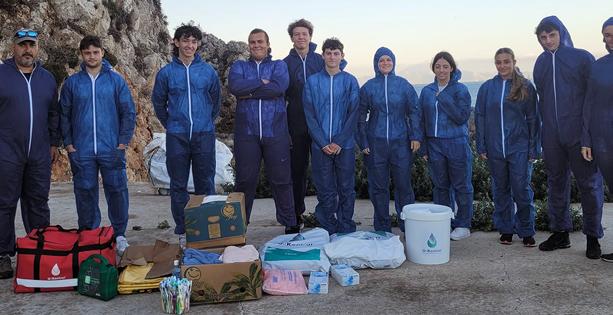
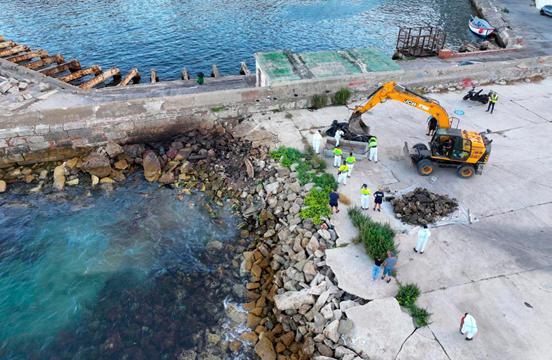
una estimación aproximada de entre 1.000 y 2.000 litros vertidos al mar.
Se siguió de cerca la evolución de la situación y se cerraron inmediatamente las playas, ya que se esperaba que el petróleo llegara a la costa. Se instó a la población a que informara a los servicios competentes de cualquier animal o ave marinos contaminados. Los primeros indicios mostraban que el impacto de la marea negra se limitaba a la zona de Camp Bay y Rosia Bay y sus inmediaciones. No se avistaron manchas de petróleo flotando libremente alejándose de esta zona, pero se realizó un seguimiento continuo durante las horas y días posteriores al incidente.
El Director de Salud Pública también advirtió que, aunque el riesgo general para la población era bajo, el público debía evitar comer pescado y marisco capturado localmente debido a la posibilidad de contaminación.
El día del vertido, la Autoridad Portuaria suspendió todas las operaciones para asegurarse de que todos los medios estuvieran disponibles para ayudar a combatir el vertido y hacer frente al incidente con la mayor rapidez y eficacia posibles. Se desplegaron embarcaciones con barreras de sorbetes para hacer frente al petróleo derramado y lanchas para hacer
frente al brillo flotante que emanaba del petróleo pesado acumulado en la costa. Pocos días después, la Capitanía Marítima facilitó información actualizada sobre la situación, confirmando que la mayor parte del petróleo vertido se concentraba en las zonas de Camp Bay, Rosia Bay y Little Bay, con una parte de la zona conocida como Seven Sisters también afectada. Los departamentos gubernamentales y las organizaciones benéficas locales realizaron un trabajo increíble para limpiar la costa. El equipo del Proyecto Nautilus respondió a las operaciones de limpieza con sus jóvenes monitores juveniles de verano, que asumieron la responsabilidad de este trabajo espantoso, tedioso y desgarrador. Dedicaron interminables horas a la limpieza de lodo negro y espeso, limpiando roca a roca con toallas viejas. El TNP es un equipo siempre comprometido con la protección de nuestro litoral. El equipo era plenamente consciente de los riesgos que entrañaba la exposición a combustibles pesados y, sin embargo, se mantuvo firme en su deseo de ayudar. El proyecto Nautilus añadió: "Este inspirador acto de voluntariado desinteresado nos llena de esperanza, al ser testigos de cómo la próxima generación de gibraltareños se responsabiliza y se enorgullece de su ciudad natal y comprende mejor
el valor histórico de la zona más afectada por el reciente vertido de petróleo, la bahía de Rosia". En un doble enfoque, los equipos de limpieza del Ministerio de Medio Ambiente se desplegaron a lo largo de los días posteriores, mientras que la autoridad portuaria siguió ocupándose de las manchas que flotaban libremente en el mar. Aunque el impacto medioambiental total del vertido tardará varias semanas en cuantificarse, el Departamento de Medio Ambiente sigue tomando registros detallados y realizando estudios ecológicos para llevar a cabo una investigación completa. Las rocas y los escombros contaminados se evaluaron individualmente, y muchos se retiraron para limpiarlos fuera del lugar antes de devolverlos a su ubicación original. Las rocas que contienen vida marina se limpian manualmente in situ para minimizar las molestias al medio ambiente costero. Afortunadamente, hasta la fecha no se han registrado aves marinas afectadas por el petróleo.
Se han emprendido acciones legales contra los infractores. La Ministra de Contingencias Civiles, Samantha Sacramento, elogió el trabajo y la rápida actuación de todos los implicados en una declaración a la prensa local.
A district judge in Montana (USA) has declared the limits states are imposing on local environmental regulators to fossil fuel companies are unconstitutional. The judge, Kathy Seeley, found that these limits do not take into account the impact that pollutant emissions have on climate change and the health of the region's residents.
The decision was made in response to a lawsuit filed by 16 young people, ages 5 to 22, who alleged that the state-imposed limits violated their right to grow up in a clean environment. The youths testified for two weeks about how smoke from wildfires, rising temperatures and drought in the West have affected their physical and mental health.
Judge Seeley's decision is a victory for environmentalists, but it is unlikely to have an immediate impact in Montana, a GOP-controlled state. However, the decision could set a precedent for other similar cases across the country.
La ley se acerca al medioambiente. Una jueza de distrito de Montana (EEUU) ha declarado que los límites que el estado ha impuesto a los reguladores ambientales locales en la concesión de permisos a las compañías de combustibles fósiles son inconstitucionales. La jueza, Kathy Seeley, consideró que estos límites no toman en cuenta el impacto que tienen las emisiones contaminantes en el cambio climático y la salud de los habitantes de la región.
La decisión fue tomada en respuesta a una demanda presentada por 16 jóvenes, de entre 5 y 22 años, que alegaban que los límites impuestos por el estado violaban su derecho a crecer en un medio ambiente limpio. Los jóvenes testificaron durante dos semanas sobre cómo el humo de los incendios forestales, el incremento de las temperaturas y la sequía en el Oeste han afectado su salud física y mental. La decisión de la jueza Seeley es una victoria para los ambientalistas, pero es poco probable que tenga un impacto inmediato en Montana, un estado controlado por el Partido Republicano. Sin embargo, la decisión podría sentar un precedente para otros casos similares en todo el país.

More than 150 groups, led by Abracemos el Mar Menor and Stop Ganadería Industrial, organized the third edition of the "Abrazo al agua" initiative on Saturday. The aim of the initiative was to draw attention to the environmental disaster caused by man in the Mar Menor. Hundreds of bathers, neighbors and supporters formed a human chain around the salt lagoon. This year, the initiative was also carried out in other places, such as the Tablas de Daimiel in Ciudad Real, the Neptune fountain in Madrid and the Nile.
The organizers argue that caring for aquatic ecosystems is not a passing fancy and that they are getting worse. In many places, people can no longer drink tap water and have to buy bottled water. They also reported that in the Region of Murcia, if the Travase or the Taibilla fail, there may be restrictions for human consumption.
The "Abrazo al agua" initiative is an example of how people can unite to fight for a cleaner environment. The success of the initiative shows that there is a great interest in protecting aquatic ecosystems. Let's hope that this initiative will continue in the future and serve as an inspiration for other people who want to fight for a cleaner environment.
Abrazo al agua
Más de 150 grupos, liderados por Abracemos el Mar Menor y Stop Ganadería Industrial, organizaron la tercera edición de la iniciativa «Abrazo al agua» el sábado. El objetivo de la iniciativa era llamar la atención sobre el desastre ambiental causado por el hombre en el Mar Menor. Cientos de bañistas, vecinos y simpatizantes formaron una cadena humana alrededor de la laguna salada. Este año, la iniciativa también se llevó a cabo en otros lugares, como las Tablas de Daimiel en Ciudad Real, la fuente de Neptuno en Madrid y el Nilo.
Los organizadores argumentan que cuidar los ecosistemas acuáticos no es un capricho pasajero y que van a peor. En muchos lugares, la gente ya no puede beber agua del grifo y tienen que comprar agua embotellada. También informaron que en la Región de Murcia, si el Travase o el Taibilla fallan, puede haber restricciones para el consumo humano.
La iniciativa «Abrazo al agua» es un ejemplo de cómo la gente puede unirse para luchar por un medio ambiente más limpio. El éxito de la iniciativa muestra que hay un gran interés en proteger los ecosistemas acuáticos. Esperemos que esta iniciativa continúe en el futuro y sirva de inspiración para otras personas que quieran luchar por un medioambiente más limpio.
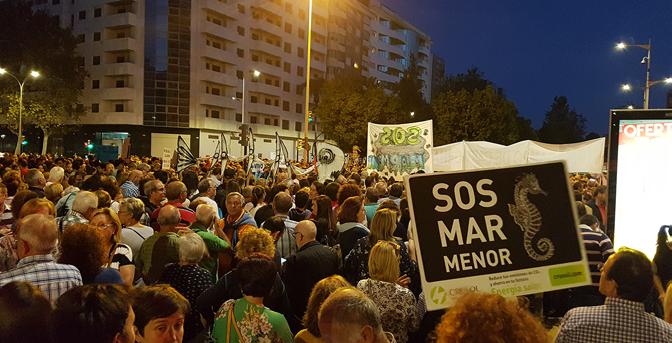

26 environmental organizations have sued Spain before the European Commission for not complying with recycling standards. European regulations state that EU countries must recycle at least half of their municipal waste, but Spain's recycling rate is 40.5%, which is well below the target.
This is the second time that environmental organizations have filed a lawsuit against Spain for the same reason. In 2020, the European Commission rejected the claim because the data used was provisional. However, official data for 2021 confirms that Spain is still not meeting the recycling standards.
If the European Commission upholds the complaint, it could impose a million-dollar fine on Spain. This would be a new defeat for Spain in environmental matters, as the country has been fined several times by the European Commission for not complying with environmental protection standards.
The demand by environmental organizations is a reminder of the importance of recycling. Recycling helps to reduce pollution, protect the environment and save natural resources. It is important that we all make an effort to recycle more. España no recicla
26 organizaciones medioambientales han demandado a España ante la Comisión Europea por no cumplir las normas de reciclaje. La normativa europea establece que los países de la Unión Europea deben
reciclar al menos la mitad de sus residuos municipales, pero la tasa de reciclaje de España es del 40,5%, lo que está muy por debajo del objetivo.
Esta es la segunda vez que las organizaciones medioambientales presentan una demanda contra España por el mismo motivo. En 2020, la Comisión Europea rechazó la demanda porque los datos utilizados eran provisionales. Sin embargo, los datos oficiales de 2021 confirman que España sigue sin cumplir las normas de reciclaje.
Si la Comisión Europea estima la demanda, podría imponer a España una multa millonaria. Esta sería una nueva derrota para España en materia medioambiental, ya que el país ha sido multado en varias ocasiones por la Comisión Europea por no cumplir las normas de protección del medio ambiente.
La demanda de las organizaciones medioambientales es un recordatorio de la importancia del reciclaje. El reciclaje ayuda a reducir la contaminación, proteger el medio ambiente y ahorrar recursos naturales. Es importante que todos hagamos un esfuerzo para reciclar más.
A recent press release from the The Ministry of Transport have shared that they will join forces with the Ayuntamiento de La Linea in celebration of European Mobility Week, from 16-22 September 2023.
‘For the first time, Gibraltarian cyclists will join the bicycle ’march’ En bici por La Linea, which follows
a 16-kilometre route across the city. The activity aims to promote good neighbourly relations, raise awareness of sustainable transport across both sides of the frontier, and promote healthy lifestyle changes for citizens of both cities. Participation is free. For more information and to register, please visit: https:// tinyurl.com/5acpz2z8 The Minister for Transport, the Hon Paul Balban, said: I‘m pleased that Gibraltarian cyclists will for the first time be participating in this important event, which promotes sustainable transport across both Gibraltar and La Linea. As neighbouring cities, it is important that we acknowledge and understand that for many of our citizens, transport is an essential part of daily life and that whilst the problems brought about by excessive vehicle use transcends frontiers, the potential benefits of sustainable, healthier alternatives knows no bounds.’
Gibraltar y La Línea unen sus fuerzas para fomentar el transporte sostenible. En un reciente comunicado de prensa, el Ministerio de Transporte ha comunicado que unirá fuerzas con el Ayuntamiento de La Línea para celebrar la Semana Europea de la Movilidad, del 16 al 22 de septiembre de 2023.
Por primera vez, los ciclistas gibraltareños se unirán a la marcha ciclista En bici por La Línea, que sigue una ruta de 16 kilómetros a través de la ciudad. La actividad pretende fomentar las buenas relaciones de vecindad, concienciar sobre el transporte sostenible a ambos lados de la frontera y promover cambios de estilo de vida saludables entre los ciudadanos de ambas ciudades. La participación es gratuita. Para más información y para inscribirse, visite: https:// tinyurl.com/5acpz2z8.
El ministro de Transportes, el Honorable Paul Balban, ha declarado: «Me complace que los ciclistas gibraltareños participen por primera vez en este importante evento, que promueve el transporte sostenible tanto en Gibraltar como en La Línea. Como ciudades vecinas, es importante que reconozcamos y comprendamos que, para muchos de nuestros ciudadanos, el transporte es una parte esencial de la vida diaria y que, si bien los problemas que acarrea el uso excesivo de vehículos trascienden las fronteras, los beneficios potenciales de las alternativas sostenibles y más saludables no conocen límites».

#reuse#savingourenviroment#sustainability#letsturnthisaround #recycle#greenchoice#earthmatters
Since 2015 we are very proud to say that Metalrok Ltd has been providing Gibraltar with a Recycling Service at the premises delivered by the government of Gibraltar Ecopark which is a joint public and private partnership located at 8 Flint Road. There has been an increase in Recycling but even so our daily waste stream contains goods which are perfectly suited to be reused not been recycled ending up in the landfill polluting the environment.
Together we can turn this around by reusing, preventing pollution, reducing usage of raw materials, sustaining the environment for future generations thus preventing them from ending in landfill and sea.
There is a need for these items in places like Senegal in West Africa were there are areas of extreme Poverty. with your cooperation we would like to meet their necessities by helping to provide them with donated unwanted items. At present we are only accepting donations for clothing and bedlinen.
We are collecting items that are still good for purpose and in usable condition in a bid to give them a new lease of life. Kindly take note that we will not make ourselves responsible for the collection of broken down items. The circumstances these people unfortunately live in deserve a sense of dignity and pride. Please only get in touch for items that will enhance and enrich their livelihoods.
Drop of points are:
Ecopark 8 Flint Road: every day from 8am to 8pm.
WATSAPP ONLY: No 00350 56003361
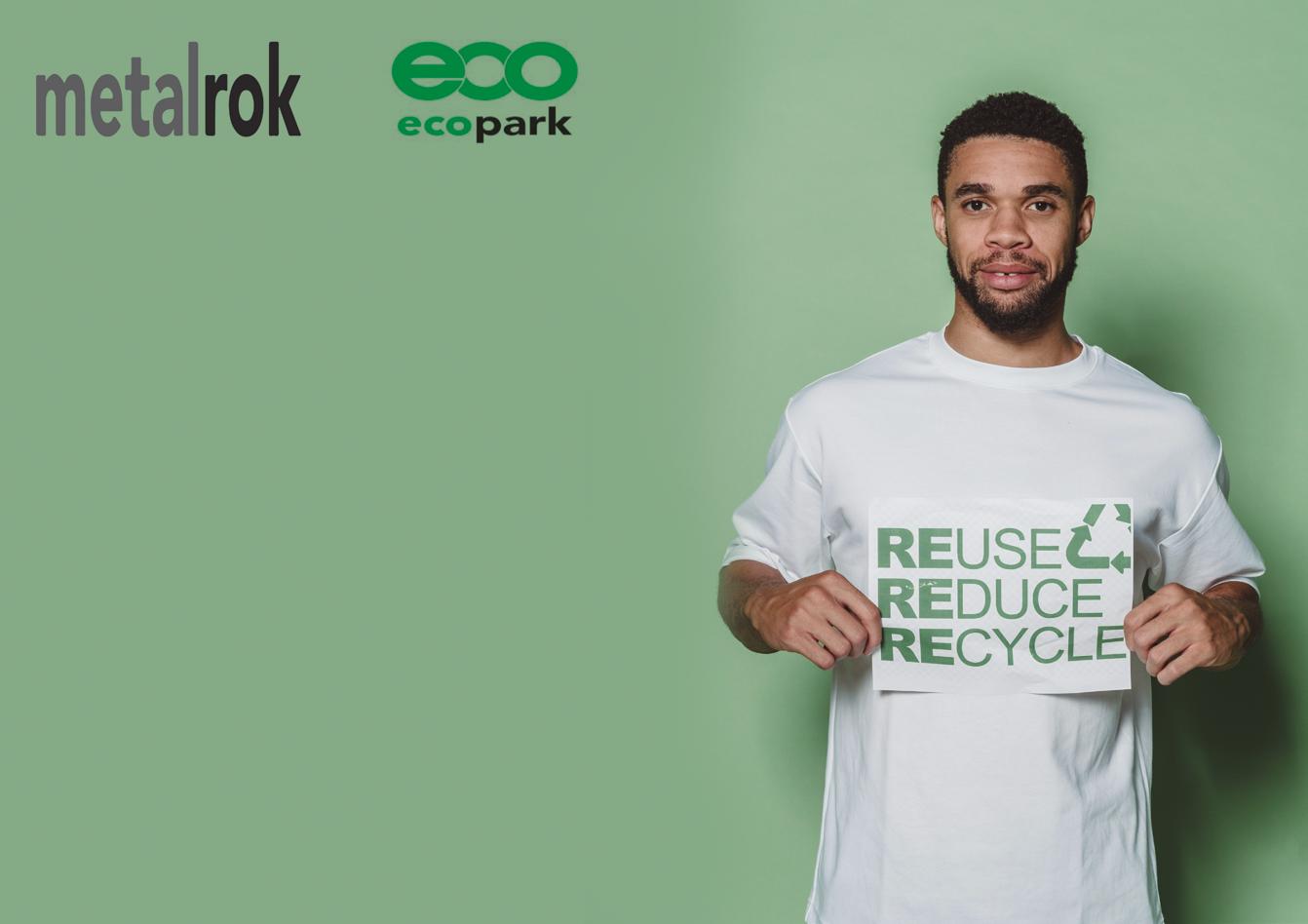

This changes everything.
Naomi Klein
In her book, Naomi Klein argues that climate change is a challenge to the current economic model, which must be abandoned in favor of a more sustainable model. She argues that the only way to address the climate crisis is to massively reduce greenhouse gas emissions, which will require a drastic change in the way we live and produce.
Klein argues that the current economic model, based on the free market, is primarily responsible for the climate crisis by encouraging overconsumption and
cambio drástico en la forma en que vivimos y producimos.
environmental destruction, and that it is unable to address the problems of inequality and poverty.
Klein proposes a new economic model, based on a respectful management of our resources and the recovery of social justice. This new model must be based on principles of cooperation, equity and respect for the environment.
Klein's book is a call to action. She urges readers to join her in the fight against climate change and to build a more sustainable and just world.
Esto lo cambia todo.
Naomi Klein.
En su libro, Naomi Klein argumenta que el cambio climático es un desafío al modelo económico actual, que debe ser abandonado en favor de un modelo más sostenible. Ella sostiene que la única manera de abordar la crisis climática es reducir masivamente las emisiones de gases de efecto invernadero, lo que requerirá un
Klein argumenta que el modelo económico actual, basado en el libre mercado, es el principal responsable de la crisis climática al fomentar el consumo excesivo y la destrucción del medio ambiente, y que no es capaz de abordar los problemas de la desigualdad y la pobreza.
Klein propone un nuevo modelo económico, basado en una gestión respetuosa de nuestros recursos y en la recuperación de la justicia social. Este nuevo modelo debe estar basado en principios de cooperación, equidad y respeto por el medio ambiente.
El libro de Klein es un llamamiento a la acción. Ella insta a los lectores a que la acompañe en la lucha contra el cambio climático y a construir un mundo más sostenible y justo.
Virtue in the mountains
Pablo Batalla Cueto
In today's world, humanism has been defeated by utilitarianism. This means that people are more interested in obtaining things than in enjoying life. This trend is even taking over
mountaineering, an activity that has traditionally been seen as a way to connect with nature and find happiness.
Today, mountain clubs are losing members, while mountain marathons are attracting more and more participants. This is because runners are more interested in competing than in simply enjoying nature. In addition, organizers are turning recreation into a business, selling their T-shirts and other items to others.
This change in mountaineering is worrying, because it means that people are losing contact with nature. This activity should be a way to connect with it and find happiness, but now it has become a way to compete and make money.

La virtud en la montaña.
Pablo Batalla Cueto.
En el mundo de hoy, el humanismo ha sido
derrotado por el utilitarismo. Esto significa que las personas están más interesadas en obtener cosas que en disfrutar de la vida. Esta tendencia se está apoderando incluso del montañismo, una actividad que tradicionalmente se ha visto como una forma de conectarse con la naturaleza y encontrar la felicidad.
Hoy en día, los clubes de montaña están perdiendo miembros, mientras que los maratones de montaña están atrayendo a más y más participantes. Esto se debe a que los corredores están más interesados en competir que en simplemente disfrutar de la naturaleza. Además, los organizadores están convirtiendo el ocio en un negocio, vendiendo sus camisetas y otros artículos a los demás.
Este cambio en el montañismo es preocupante, porque significa que la gente está perdiendo el contacto con la naturaleza. Esta actividad debería ser una forma de conectarse con ella y encontrar la felicidad, pero ahora se ha convertido en una forma de competir y hacer dinero.
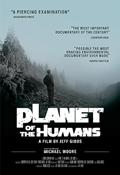
Planet of the Humans.
Jeff Gibbs.
This documentary is a frontal attack on the renewable lobbies and many of their die-hard advocates. The documentary argues that renewables are not as clean and green as claimed, and that they actually require the use of fossil fuels and scarce materials. It also criticizes the intermittency of these energies, which makes it necessary to have batteries and other less clean alternatives to maintain supply.
The documentary is brave, but it is also reckless. Some of the documentary's claims are inaccurate, and the documentary has been criticized by some environmentalists. However, the documentary has been praised by other environmental experts, who believe it is an important wake-up call about the limits of renewable energy.
Planeta de los humanos.
Jeff Gibbs.
Este documental es un ataque frontal a los lobbies de las renovables y a muchos de sus defensores a ultranza. El documental argumenta que las renovables no son tan limpias ni verdes como se dice, y que en realidad requieren el uso de combustibles fósiles y materiales escasos. También critica la intermitencia de estas energías, que hace necesario tener baterías y otras alternativas menos limpias para mantener el suministro. El documental es valiente, pero también es temerario. Algunas de las afirmaciones del documental son inexactas, y el documental ha sido criticado por algunos ambientalistas. Sin embargo, el documental ha sido elogiado por otros expertos en medioambiente, que creen que es una importante llamada de atención sobre los límites de las energías renovables.
Nanook of the North.
Robert J. Flaherty.
This 1922 documentary film was directed by Robert J. Flaherty. The film follows the life of an Eskimo hunter named Nanook and his

family in the Canadian Arctic.
It is one of the first documentary films and is considered a masterpiece of the genre. Flaherty was one of the first filmmakers to use narrative techniques in a documentary, and Nanook, the Eskimo is an early example of how film can be used to tell stories about real people and places. The film was a commercial and critical success, and helped popularize the documentary genre. Nanook, the Eskimo has been imitated many times since its release. This edition of Nanook, the Eskimo is restored and features a new score composed by Timothy Brock. It also includes three hours of bonus material, including a documentary about Nanook produced in 1988 and several
medium-length documentaries related to Eskimos and the Arctic made between 1913 and 1959.
Nanook, the Eskimo is a historically and culturally significant film, and this new edition is an excellent opportunity to see this classic film.
Nanook, el Esquimal.
Esta película documental de 1922 fue dirigida por Robert J. Flaherty. La película sigue la vida de un cazador esquimal llamado Nanook y su familia en el Ártico canadiense.
Ess una de las primeras películas documentales y está considerada una obra maestra del género.
Flaherty fue uno de los primeros cineastas en usar técnicas narrativas en un documental, y Nanook, el esquimal es un ejemplo temprano de cómo se puede usar el cine para contar historias sobre personas y lugares reales.
La película fue un éxito comercial y crítico, y ayudó a popularizar el género del documental.
Nanook, el esquimal ha sido imitada muchas veces desde su estreno.
Esta edición de Nanook, el esquimal está restaurada y
presenta un nuevo score compuesto por Timothy Brock. También incluye tres horas de material extra, incluyendo un documental sobre Nanook producido en 1988 y varios mediometrajes documentales relacionados con los esquimales y el Ártico realizados entre 1913 y 1959.
Nanook, el esquimal es una película histórica y culturalmente significativa, y esta nueva edición es una excelente oportunidad para ver este clásico del cine.

This podcast brings together leaders and activists from small island nations for an urgent call for climate action. These nations are responsible for less than 1% of cumulative greenhouse gas emissions, but are at the forefront of climate impacts such as sea level rise and extreme storms.
Hosted by Andy Liburd, a renowned media figure, it will also feature scientists, political negotiators, energy specialists and
indigenous voices. The podcast will be hard-hitting, informative and compelling, and will help raise awareness of the climate crisis and the impact it is having on small island nations. Listen to it.
Este podcast reúne a líderes y activistas de pequeñas naciones insulares para una llamada a la acción climática urgente. Estas naciones son responsables de menos del 1% de las emisiones acumuladas de gases de efecto invernadero, pero están a la vanguardia de los impactos climáticos, como el aumento del nivel del mar y las tormentas extremas.
Presentado por Andy Liburd, una figura mediática de renombre, también contará con científicos, negociadores políticos, especialistas en energía y voces indígenas. El podcast será contundente, informativo y convincente, y ayudará a generar conciencia sobre la crisis climática y el impacto que está teniendo en las pequeñas naciones insulares. Escúchalo
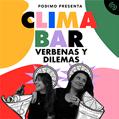
and Belén Hinojar are activists and climate content creators. They have created a podcast called Climabar, in which they talk about climate change from a less catastrophic point of view.
In the first episode, they discuss the relationship between food and climate change, and how we can reduce our impact on the environment through our food choices.
Climabar is produced by Ekos Media and is available on Podimo. The podcast features guests from a variety of backgrounds, including scientists, activists and politicians. Climabar aims to raise awareness about climate change and encourage people to take action to protect the planet. Listen to it.
Cliumabar. (Español).
Carmen Huidobro y Belén Hinojar son activistas y creadoras de contenido climático.
Han creado un podcast llamado Climabar, en el que hablan sobre el cambio climático desde un punto de vista
menos catastrofista. En el primer episodio, discuten la relación entre la alimentación y el cambio climático, y cómo podemos reducir nuestro impacto en el medio ambiente a través de nuestras elecciones alimentarias.
Climabar está producido por Ekos Media y está disponible en Podimo. El podcast cuenta con invitados de diferentes ámbitos, incluidos científicos, activistas y políticos. El objetivo de Climabar es concienciar sobre el cambio climático y animar a la gente a tomar medidas para proteger el planeta. Escúchalo. European Mobility Week. European Mobility Week is an annual campaign that takes place from September 16-22. The campaign is organized by the European Commission and aims to promote
sustainable urban mobility. During the week, a series of events and activities take place across Europe to raise awareness of the benefits of sustainable mobility and to encourage citizens to change their transport habits. The themes of European Mobility Week change every year. The theme for 2023 is "Save Energy." This theme is related to the European Union's goals of reducing greenhouse gas emissions and improving air quality. The campaign encourages citizens to use more sustainable modes of transport, such as public transport, cycling and walking. It also encourages companies to reduce their energy consumption and use more sustainable means of transport for their operations.
European Mobility Week is an opportunity for citizens and businesses across Europe to commit to sustainable mobility. The campaign
helps to raise awareness of the benefits of sustainable mobility and encourage citizens to change their transport habits. European Mobility Week is an important step towards creating a more sustainable future for Europe. More info.
Semana de la Movilidad Europea.
La Semana Europea de la Movilidad es una campaña anual que tiene lugar del 16 al 22 de septiembre. La campaña está organizada por la Comisión Europea y tiene como objetivo promover la movilidad urbana sostenible.
Durante la semana, se llevan a cabo una serie de eventos y actividades en toda Europa para concienciar sobre los beneficios de la movilidad sostenible y para animar a los ciudadanos a cambiar sus hábitos de transporte.
Los temas de la Semana Europea de la Movilidad cambian cada año. El tema de 2023 es
"Ahorra energía". Este tema está relacionado con los objetivos de la Unión Europea de reducir las emisiones de gases de efecto invernadero y de mejorar la calidad del aire. La campaña anima a los ciudadanos a utilizar medios de transporte más sostenibles, como el transporte público, la bicicleta y el caminar. También anima a las empresas a reducir su consumo de energía y a utilizar medios de transporte más sostenibles para sus operaciones. La Semana Europea de la Movilidad es una oportunidad para que los ciudadanos y las empresas de toda Europa se comprometan con la movilidad sostenible. La campaña ayuda a concienciar sobre los beneficios de la movilidad sostenible y a animar a los ciudadanos a cambiar sus hábitos de transporte. La Semana Europea de la Movilidad es un paso importante para crear un futuro más sostenible para Europa. Infórmate.

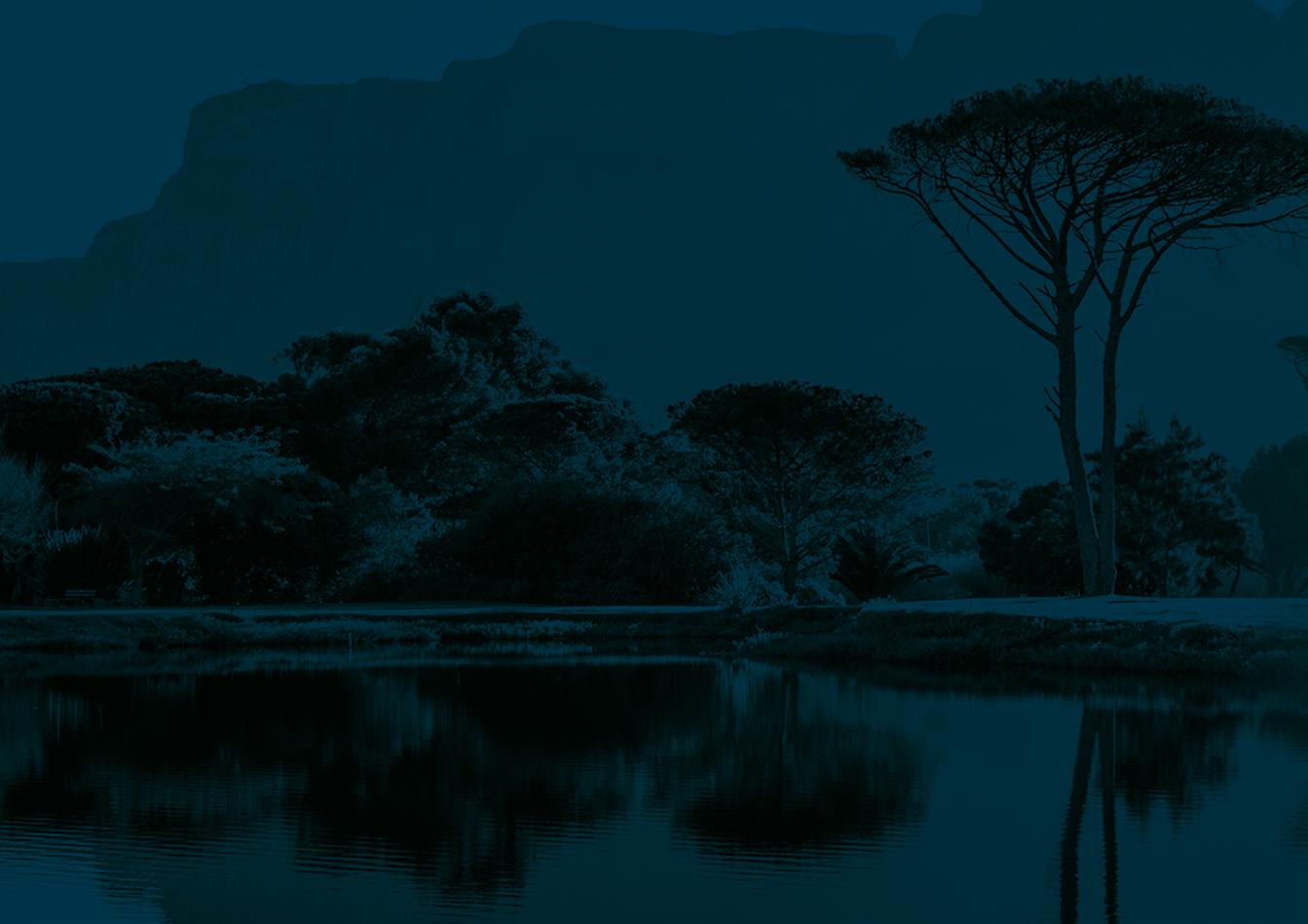
Data visualistion reporting habitats' condition reported by Member States under Article 17 reporting (period 2013-2018).
Visualización de datos que informan sobre el estado de los hábitats informado por los Estados miembros en virtud del artículo 17 sobre informes (período 2013-2018).
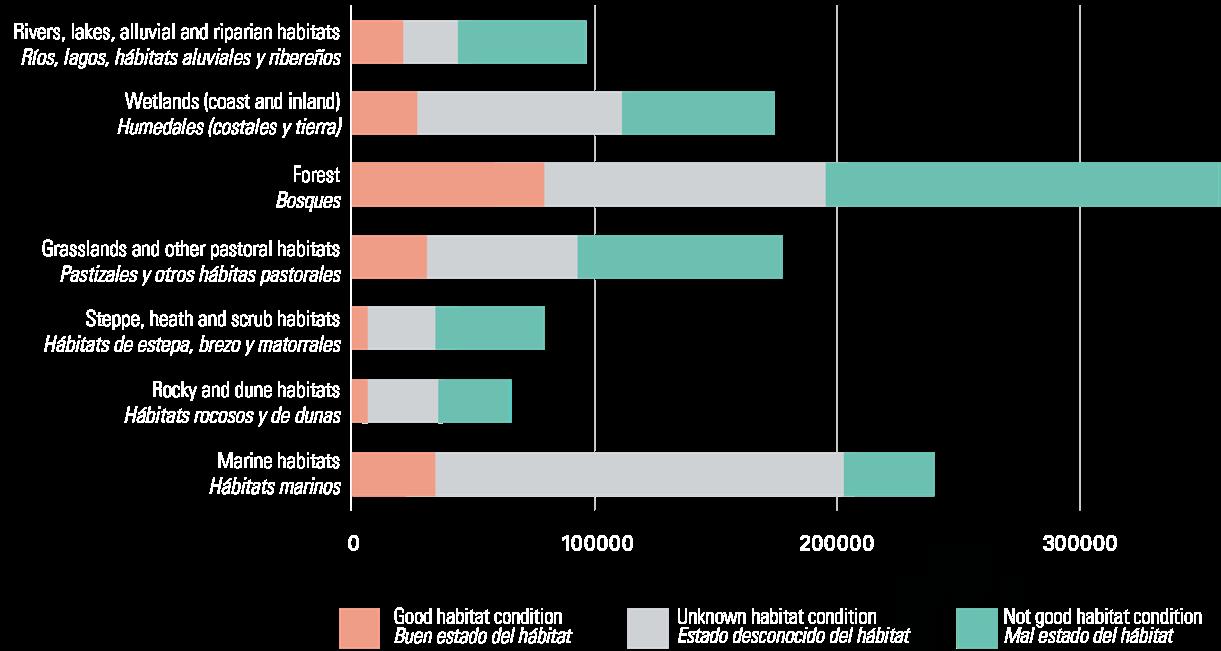
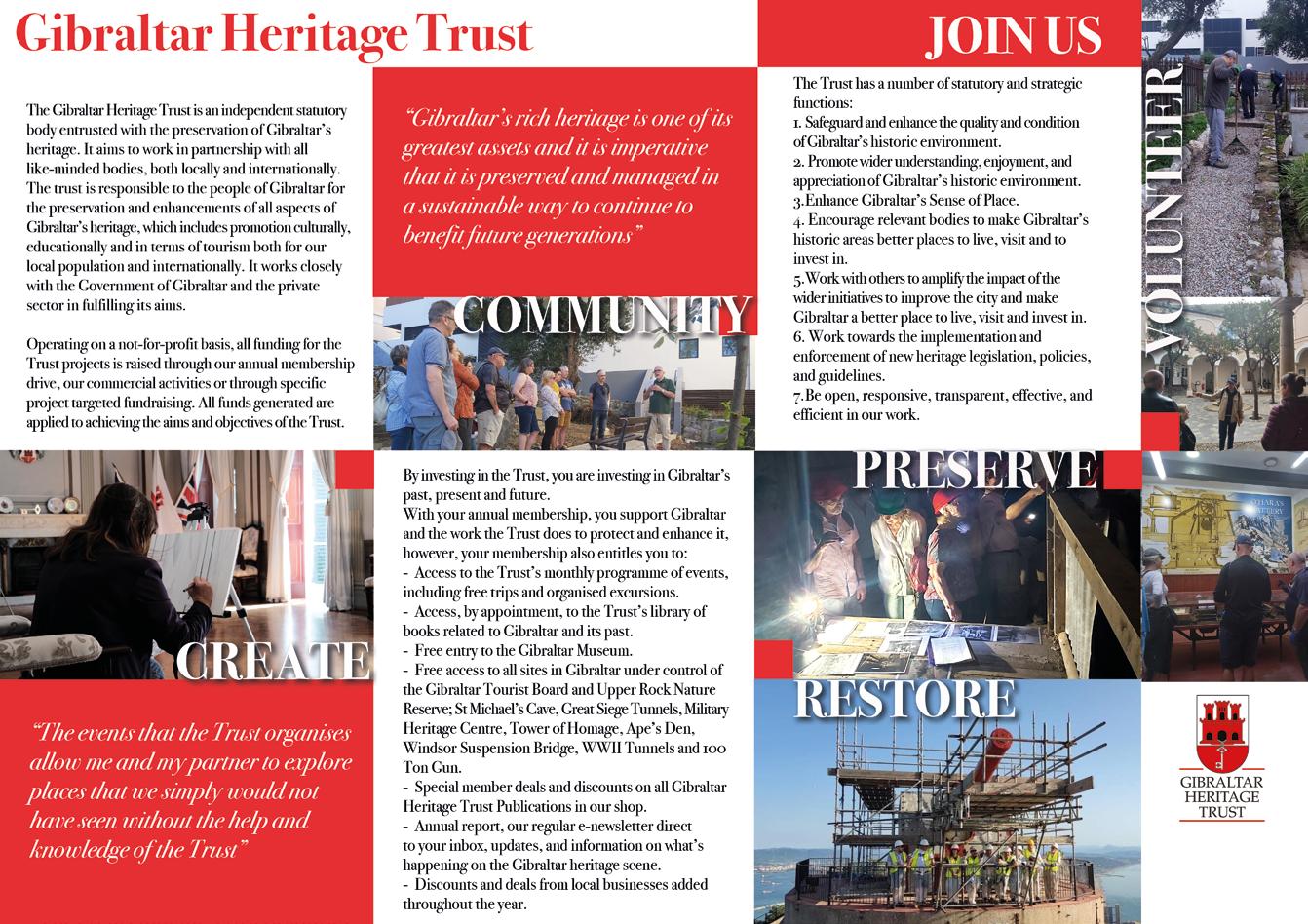
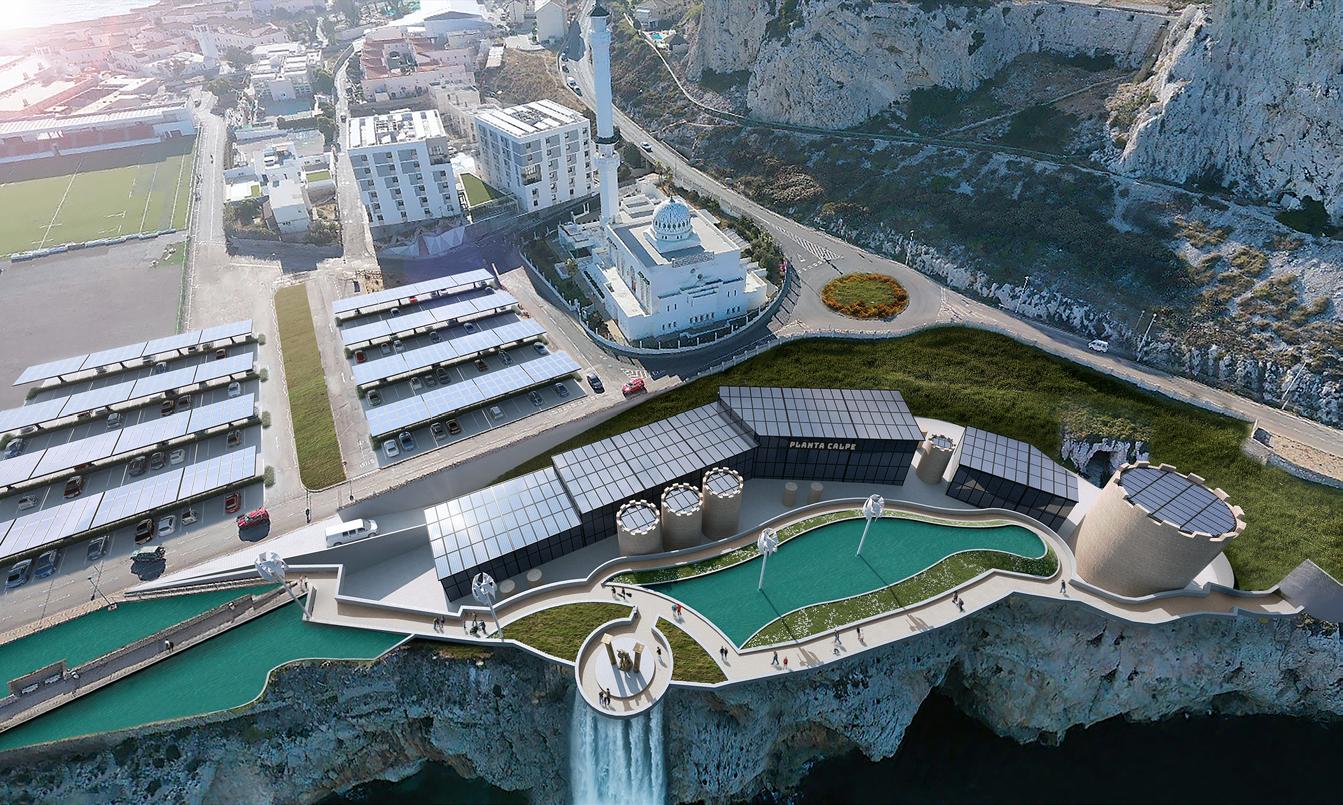
La revolucionaria tecnología e-WATTS ofrece una solución sostenible a los problemas de aguas residuales de Gibraltar
Gibraltar is poised to revolutionize its wastewater treatment with an innovative proposal that addresses its unique challenges. Known for its high chloride content traditional treatment methods have been ineffective. However, a cutting-edge technology, e-WATTS, could be the game-changer.
Gibraltar's limited space has been a significant hurdle, where conventional treatment plants for a population like Gibraltar's would occupy over 42,000 square meters. In contrast, the available area is a mere 4,500 square meters. e-WATTS technology could fit within 3,000 square meters, offering a space-efficient solution.
The high chloride content, initially a concern, becomes advantageous with e-WATTS. Unlike other technologies hindered by chlorides, e-WATTS thrives on them. Moreover, it requires minimal space and produces no odors. The added benefit of generating green energy through renewable sources or biogas and green hydrogen further enhances its environmental profile.
Incorporating wind turbines without blades for minimal visual impact and utilizing waste heat for drying sludge, e-WATTS showcases a comprehensive approach to sustainability. This technology might also enable the recovery of 50% of treated water for reuse, minimizing seawater contribution.
The e-WATTS proposal's validity has been established through an impressive track record. With an ongoing project in Italy and validation against competitors, it has demonstrated exceptional efficiency and cost-effectiveness. Tests using urban wastewater with added chlorides to simulate Gibraltar's conditions have yielded outstanding results.
The e-WATTS installations are accredited with the CE mark, offering reliability and quality assurance. With the potential for future enhancements like water recovery, this solution promises a bright future for Gibraltar.
Implementing this solution would not only position Gibraltar as a technological pioneer but also underscore its commitment to sustainability. The global impact of this initiative could resonate across media and political circles, setting a benchmark for wastewater treatment.
As Gibraltar stands at the cusp of this groundbreaking decision, the world watches with anticipa-
Gibraltar está a punto de revolucionar el tratamiento de sus aguas residuales con una propuesta innovadora que aborda sus retos únicos. Conocido por su alto contenido en cloruros los métodos tradicionales de tratamiento han resultado ineficaces. Sin embargo, una tecnología de vanguardia, e-WATTS, podría cambiar las reglas del juego.
El espacio limitado de Gibraltar ha sido un obstáculo importante, ya que las depuradoras convencionales para una población como la de Gibraltar ocuparían más de 42.000 metros cuadrados. En cambio, la superficie disponible es de apenas 4.500 metros cuadrados. La tecnología e-WATTS podría caber en 3.000 metros cuadrados, ofreciendo una solución eficiente en términos de espacio.
El alto contenido de cloruro, que en un principio preocupaba, se convierte en una ventaja con e-WATTS. A diferencia de otras tecnologías que se ven obstaculizadas por los cloruros, e-WATTS se nutre de ellos. Además, requiere un espacio mínimo y no produce olores. La ventaja añadida de generar energía verde mediante fuentes renovables o biogás e hidrógeno verde mejora aún más su perfil medioambiental.
Al incorporar turbinas eólicas sin aspas para minimizar el impacto visual y utilizar el calor residual para secar los lodos, e-WATTS muestra un enfoque integral de la sostenibilidad. Esta tecnología también podría permitir la recuperación del 50% del agua tratada para su reutilización, minimizando la aportación de agua de mar.
La validez de la propuesta e-WATTS ha quedado demostrada por un impresionante historial. Con un proyecto en curso en Italia y la validación frente a competidores, ha demostrado una eficacia y rentabilidad excepcionales. Las pruebas realizadas con aguas residuales urbanas con cloruros añadidos para simular las condiciones de Gibraltar han arrojado resultados extraordinarios.
Las instalaciones e-WATTS están acreditadas con la marca CE, lo que ofrece fiabilidad y garantía de calidad. Con el potencial de futuras mejoras como la recuperación de agua, esta solución promete un futuro brillante para Gibraltar.
La implantación de esta solución no sólo situaría a Gibraltar como pionero tecnológico, sino que también subrayaría su compromiso con la sostenibilidad. El impacto global de esta iniciativa podría resonar en
tion, recognizing the potential of e-WATTS technology to redefine wastewater treatment, sustainability, and international acclaim.
There are a number of proposals with the Government of Gibraltar now considering the tender in the light of all relevant factors.
A decision on the adjudication of these tenders is expected soon with a number of companies submitting proposals to address this challenging problem.
los medios de comunicación y los círculos políticos, estableciendo un punto de referencia para el tratamiento de aguas residuales.
Mientras Gibraltar se encuentra en la cúspide de esta decisión pionera, el mundo observa con expectación, reconociendo el potencial de la tecnología e-WATTS para redefinir el tratamiento de aguas residuales, la sostenibilidad y el reconocimiento internacional. El Gobierno de Gibraltar está estudiando la licitación a la luz de todos los factores pertinentes.
Se espera en breve una decisión sobre la adjudicación de estas licitaciones, ya que varias empresas han presentado propuestas para resolver este difícil problema.
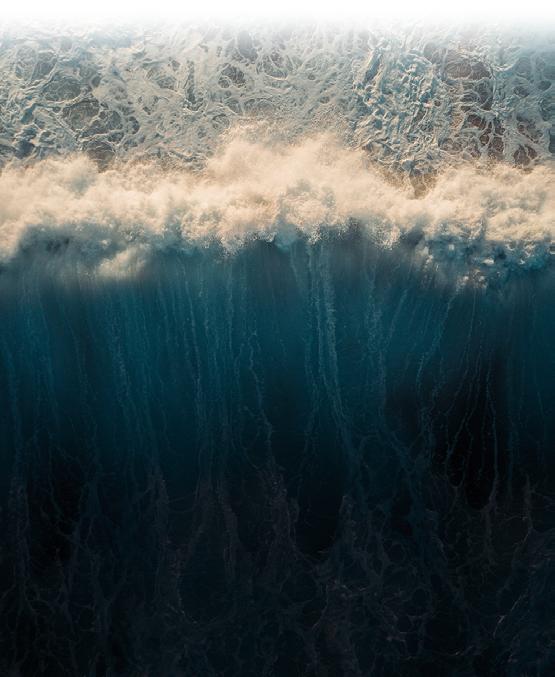


In recognition of the National Financial Awareness Day on 14/08, the topic of budgeting and financial health has become more important than ever before! With fluctuating inflation rates and persistent Bank of England rate increases, there is no better time than now to take care of your money and with September around the corner, student’s listen up as this can also apply to you!
Our Chief Financial Officer, Lee Buhagiar, shares his thoughts on the topic, “taking care of your financial health isn't just about numbers and spreadsheets -it's about empowering you to make informed decisions, build resilience, and seizing exciting opportunities and one way to do this is by looking into how you can budget your finances better.
Budgeting is like a roadmap for your money -it helps you stay on track, prioritise your spending, and make informed financial decisions. Here are a few key steps to help you get started:
Your Income and Expenses: Begin by gathering all of your financial information and tracking your income and expenses. This could include your salary, side hustles, bills, food shops, entertainment, and everything in between.
Con motivo del Día Nacional de la Concienciación Financiera, que se celebra el 14 de agosto, el tema del presupuesto y la salud financiera es más importante que nunca. Con las fluctuantes tasas de inflación y las persistentes subidas de tipos del Banco de Inglaterra, no hay mejor momento que éste para cuidar de su dinero y, con septiembre a la vuelta de la esquina, los estudiantes deben estar atentos, ya que esto también puede aplicarse a ustedes.
Nuestro Director Financiero, Lee Buhagiar, comparte su opinión sobre el tema: «Cuidar de tu salud financiera no es sólo cuestión de números y hojas de cálculo, sino de capacitarte para tomar decisiones informadas, crear resiliencia y aprovechar oportunidades interesantes, y una forma de hacerlo es estudiando cómo puedes presupuestar mejor tus finanzas. La elaboración de un presupuesto es como una hoja de ruta para tu dinero: te ayuda a mantener el rumbo, a priorizar tus gastos y a tomar decisiones financieras con conocimiento de causa. He aquí algunos pasos clave que te ayudarán a empezar: Controla tus ingresos y gastos: Empieza por recopilar toda tu información financiera y hacer un
Set Financial Goals: Identify your short-term and long-term financial goals. Whether it's preparing for university, saving for a house, paying off debt, or building an emergency fund, your goals will guide your budgeting decisions and provide a sense of purpose.
Categorise and Prioritise: Divide your expenses into categories such as housing, transportation, food, entertainment, and savings.
Create a Realistic Budget: Based on your income and priorities, create a budget that reflects your financial goals and values. Allocate specific amounts to each category, ensuring that your expenses don't exceed your income. Be realistic and flexible, allowing room for unexpected expenses and adjustments along the way.
Track and Review: Regularly track your expenses and compare them to your budget. This will help you identify areas where you may be overspending or where you can adjust. Review your budget periodically to ensure it aligns with your evolving needs and goals.
Remember, budgeting isn't about deprivation -it's about making intentional choices…and empowers you to take control of your money and achieve financial freedom.”
Be mindful, especially for those starting university this September that not everyone’s financial health and goals will match yours, what’s important to you may not be what’s important to them, which could be detrimental when taking care of your money.


seguimiento de tus ingresos y gastos. Esto podría incluir su salario, side hustles, facturas, tiendas de alimentos, entretenimiento, y todo lo demás.
Establece objetivos financieros: Identifica tus objetivos financieros a corto y largo plazo. Ya sea prepararte para la universidad, ahorrar para una casa, pagar deudas o crear un fondo de emergencia, tus objetivos guiarán tus decisiones presupuestarias y te proporcionarán un sentido de propósito.
Clasifica y prioriza: Divide tus gastos en categorías como vivienda, transporte, comida, ocio y ahorros.
Elabore un presupuesto realista: En función de sus ingresos y prioridades, elabore un presupuesto que refleje sus objetivos y valores financieros. Asigne cantidades específicas a cada categoría, asegurándose de que sus gastos no superan sus ingresos. Sé realista y flexible, dejando margen para gastos imprevistos y ajustes sobre la marcha.
Controle y revise: Controle periódicamente sus gastos y compárelos con su presupuesto. Esto le ayudará a identificar las áreas en las que puede estar gastando de más o en las que puede hacer ajustes. Revise su presupuesto periódicamente para asegurarse de que se ajusta a sus necesidades y objetivos. Recuerda, hacer un presupuesto no es privarse, es tomar decisiones intencionadas... y te capacita para tomar el control de tu dinero y alcanzar la libertad financiera».
Ten en cuenta, especialmente para los que empiezan la universidad este mes de septiembre, que no todos los objetivos y la salud financiera de todo el mundo coincidirán con los tuyos, lo que es importante para ti puede no serlo para ellos, lo que podría ser perjudicial a la hora de cuidar tu dinero.

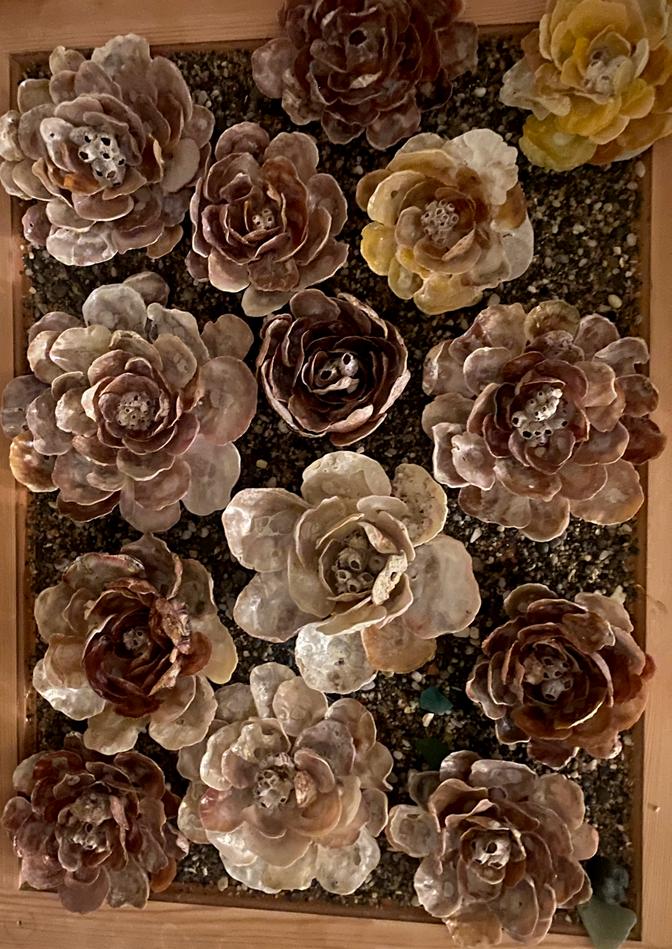
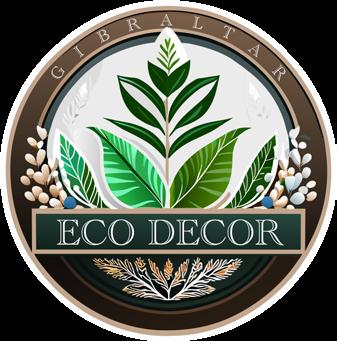
Ireana Schwock is a local artist very passionate about recycling and expressing her creativity by beautifying much needed social areas. Her focus is creating awareness within our community on the importance of recycling, upcycling, and preserving our natural environment. Her drive is to address the need to improve our limited outdoor space and beautifying our urban areas incorporating upcycling as a force for change by using natural, unused materials and resources as a main component of her designs. After being away for some time, Ireana noticed many urban areas within Gibraltar that have deteriorated with time and believes that this affects our civic pride. She has a vision to find solutions. She is passionate about initiatives that involve the participation of youth and community, spreading awareness on all these areas by reusing materials that would have otherwise ended up in the rubbish heap. Her dream is to take her skills into local schools and create community projects that would benefit teachers and pupils, developing and enhancing community pride and achievement. Her designs bring colourful mosaic artwork from broken ceramics locally sourced by businesses around the area. School children would be asked to design mosaics in the classroom on coloured paper which could then be
Ireana Schwock es una artista local muy apasionada por el reciclaje y la expresión de su creatividad mediante el embellecimiento de áreas sociales muy necesarias. Su objetivo es concienciar a nuestra comunidad sobre la importancia del reciclaje, el upcycling y la conservación de nuestro entorno natural. Su impulso es abordar la necesidad de mejorar nuestro limitado espacio exterior y embellecer nuestras zonas urbanas incorporando el upcycling como fuerza de cambio mediante el uso de materiales y recursos naturales no utilizados como componente principal de sus diseños. Después de estar fuera durante algún tiempo, Ireana se dio cuenta de que muchas zonas urbanas de Gibraltar se han deteriorado con el tiempo y cree que esto afecta a nuestro orgullo cívico. Su visión es encontrar soluciones. Le apasionan las iniciativas que implican la participación de los jóvenes y la comunidad, la difusión de la concienciación en todas estas áreas mediante la reutilización de materiales que de otro modo habrían terminado en el montón de basura. Su sueño es llevar sus habilidades a las escuelas locales y crear proyectos comunitarios que beneficien a profesores y alumnos, desarrollando y mejorando el orgullo y los logros de la comunidad. Sus diseños consisten en mosaicos de colores hechos con cerámicas rotas

recreated in ceramics on to various surfaces around the schools or our community. Art can channel great positive atmospheres, and the creation of mosaic art brightens and generates a great community spirit.
Her experience is vast. Just last year, she decorated the local Youth Centre for their “Fall Ball” in October. She made sure all materials at the youth club event were recycled and all were involved making it a unifying and team building experience. The decorations were made of recycled jars, tree branches and hanging recycled hoola hoops. Staff members also got involved in creating these gorgeous decorations.
She is also a strong supporter of local charities, selling all her pieces in events held in Christmas and Valentines for the Animals In Need Foundation. All sales profits went to rehoming abandoned animals, helping keep the kennels maintained and their veterinary needs.
Ireana’s drive to improve our outdoor communal areas for all our community is admirable. She believes that upcycling materials will plant seeds in minds and make any area look gorgeous – it just takes a little bit of tender love and care which is what Ireana brings every time. She took part in the local Spring Art Competition this year introducing the lovely Stephen Seagul. A gorgeous piece made only from shells, glass, pebbles united with epoxy rein.
The OTWO team are very excited to announce that Ireana will be decorating this year’s Eco Festival —she is already busy at work creating gorgeous mosaic pieces and will be decorating many areas within the festival itself. If you would like to see her work first hand, come along to the festival on September 23rd and 24th and check out her designs— if you are interested in any of her work or would like to contact Ireana directly let us know.
Stay tuned for many more initiatives to create civic pride and direct action from the community.
procedentes de empresas de la zona. Se pediría a los escolares que diseñaran mosaicos en clase, sobre papel de colores, que luego se recrearían en cerámica sobre diversas superficies de las escuelas o de nuestra comunidad. El arte puede canalizar grandes atmósferas positivas, y la creación de arte en mosaico ilumina y genera un gran espíritu de comunidad.
Su experiencia es amplia. El año pasado decoró el Centro Juvenil local para su "Baile de Otoño" en octubre. Se aseguró de que todos los materiales del evento del club juvenil fueran reciclados y de que todos participaran, convirtiéndolo en una experiencia unificadora y de creación de equipo. Las decoraciones estaban hechas de tarros reciclados, ramas de árboles y aros de hula hula reciclados. Los miembros del personal también participaron en la creación de estas magníficas decoraciones.
También es una gran defensora de las organizaciones benéficas locales, y vendió todas sus piezas en eventos celebrados en Navidad y San Valentín para la fundación Animals In Need. Todos los beneficios de las ventas se destinaron al realojamiento de animales abandonados, al mantenimiento de las perreras y a sus necesidades veterinarias.
El empeño de Ireana por mejorar nuestras zonas comunes al aire libre para toda nuestra comunidad es admirable. Cree que reciclando materiales se siembran las mentes y se consigue que cualquier zona tenga un aspecto precioso; sólo hace falta un poco de cariño y cuidado, que es lo que Ireana aporta siempre. Este año participó en el concurso local de arte de primavera presentando al encantador Stephen Seagul. Una hermosa pieza hecha sólo de conchas, vidrio, guijarros unidos con resina epoxi.
El equipo OTWO están muy contentos de anunciar que Ireana será la decoración de este año Eco Festival - que ya está ocupado en el trabajo de creación de piezas de mosaico magnífico y será la decoración de muchas áreas dentro del propio festival. Si quieres ver su trabajo de primera mano, acércate al festival los días 23 y 24 de septiembre y echa un vistazo a sus diseños. Si estás interesado en alguno de sus trabajos o quieres contactar directamente con Ireana, háznoslo saber.
Permanece atento a muchas más iniciativas para crear orgullo cívico y acción directa por parte de la comunidad.
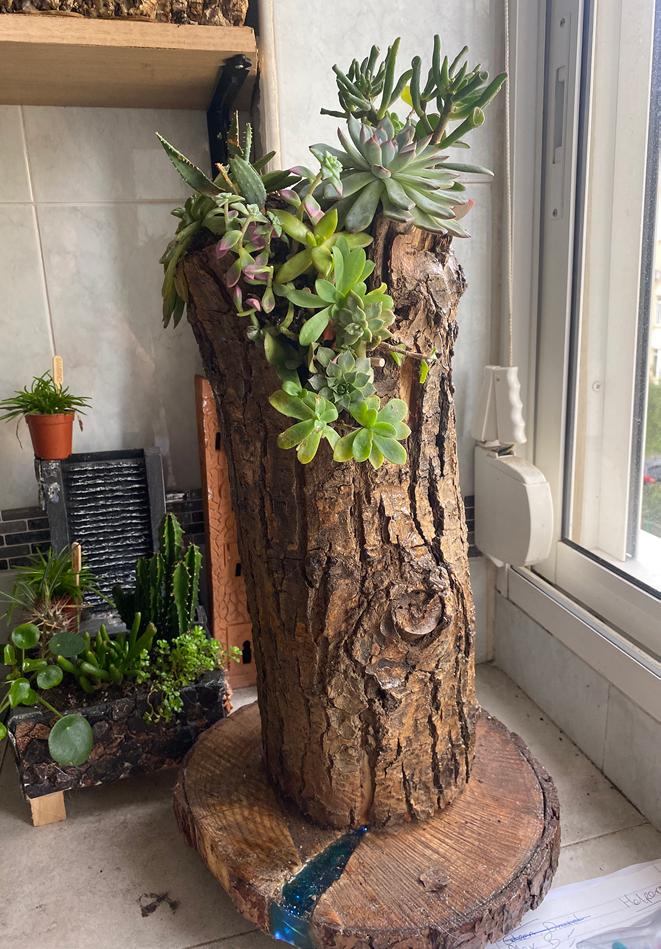
www.estudio-es.es
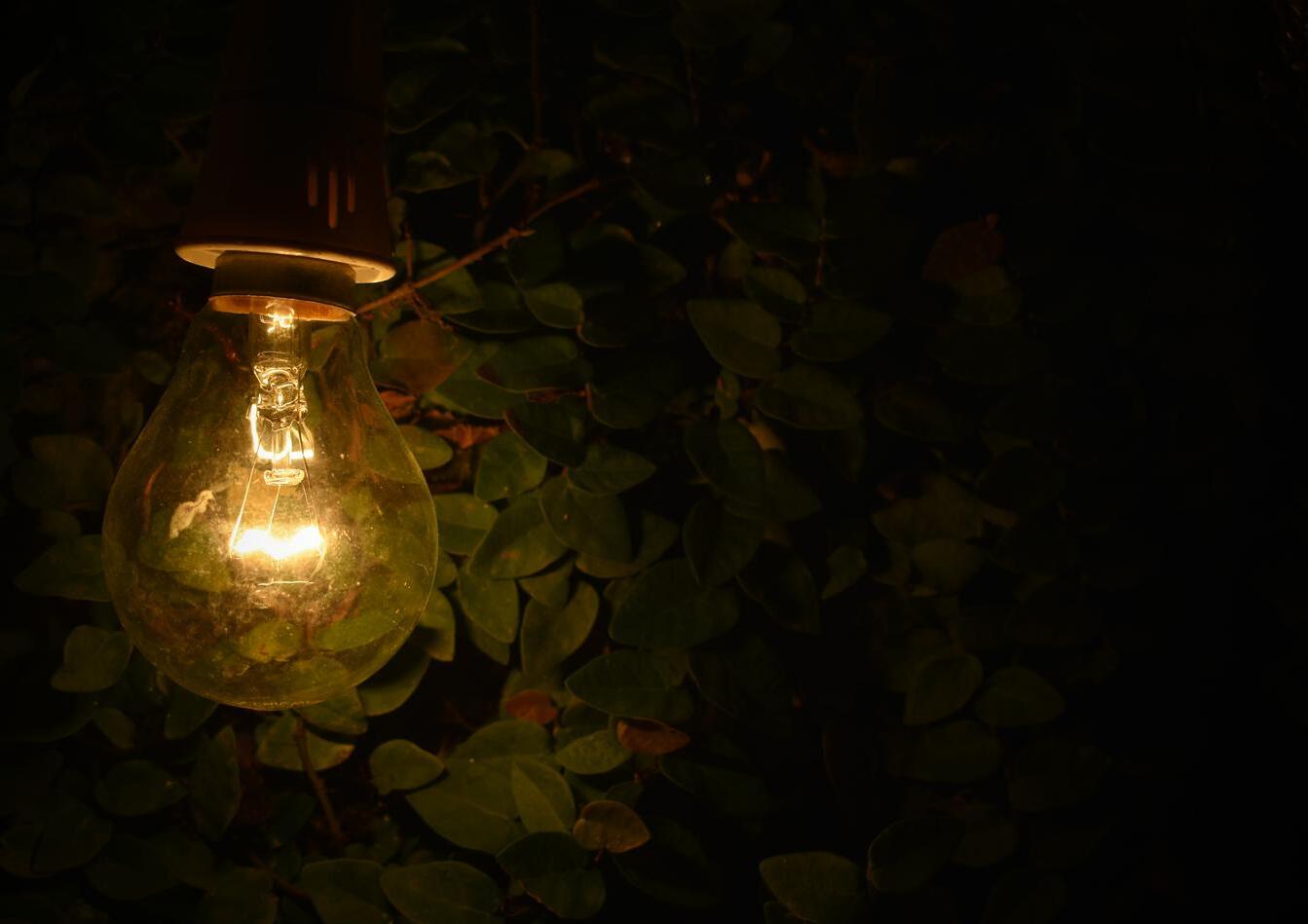
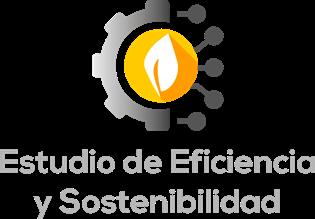
Estudio de Eficiencia y Sostenibilidad no ofrece una solución mágica para los problemas del consumo energético y su inestabilidad de costes.
Crear vuestra propia energía con paneles solares tiene sentido, pero solo como función del control de los gastos energéticos.
A veces no es lo mas la mejor manera de actuar, a veces el problema se podría controlar mejor actuando sobre los fallos de diseño o estudiando bien las diferentes opciones de un mercado que cada vez confunde más y más.
En estos momentos, lo ideal es ofrecer un servicio de asesoría especializado, con larga experiencia, y con recursos probados en el mercado.
Si es eso lo que buscas, llámanos. Será un placer atender a vuestras necesidades con profesionalidad y solvencia.
Y con una primera consulta totalmente gratis.
Por encima de todo, con ofertas claras y demostrablemente eficientes. No lo dudes.
Schmidt
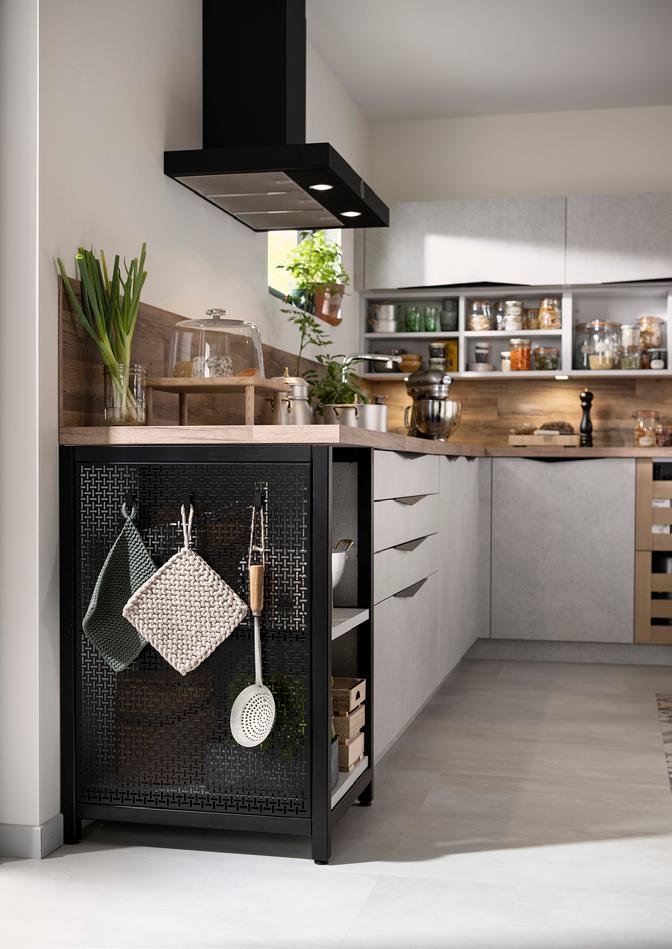
In an era defined by increasing environmental awareness, the concept of sustainability has permeated virtually every industry. This includes the realm of kitchen design, where Schmidt has emerged as a trailblazer in offering sustainable options that not only enhance the aesthetic appeal of spaces but also contribute to a greener future.
Schmidt, a renowned name in the world of kitchen interiors, has embraced sustainability as a core value, paving the way for a more conscious approach to kitchen design. Their commitment to sustainability is reflected in their innovative products and practices, making them a standout choice for environmentally-conscious consumers.
One of the cornerstones of Schmidt’s sustainability efforts is their careful selection of materials. Traditional kitchen design often involves the use of non-renewable resources and materials that have a significant ecological footprint. Schmidt Kitchens, however, takes a different route by utilizing eco-friendly alternatives without compromising on quality or style.
The company offers a wide array of sustainable materials, including responsibly sourced wood, bamboo, and recycled materials. These materials not only reduce the demand for virgin resources but also promote the concept of circular economy, where materials are recycled and reused, minimizing waste and environmental degradation.


A sustainable kitchen is not only about the materials used in its construction but also the appliances that power it. Schmidt Kitchens recognizes the significance of energy-efficient appliances in minimizing the carbon footprint of a kitchen. Their selection includes appliances with high energy-efficiency ratings, which not only help homeowners save on utility bills but also reduce overall energy consumption and greenhouse gas emissions.
Sustainability extends beyond materials and energy; it also involves efficient space utilization. Schmidt Kitchens excels in this aspect by offering
En una era definida por una creciente conciencia ambiental, el concepto de sostenibilidad ha permeado prácticamente todas las industrias. Esto incluye el ámbito del diseño de cocinas, donde Schmidt se ha convertido en un pionero al ofrecer opciones sostenibles que no sólo mejoran el atractivo estético de los espacios sino que también contribuyen a un futuro más ecológico.
Schmidt, un nombre reconocido en el mundo de los interiores de cocinas, ha adoptado la sostenibilidad como un valor fundamental, allanando el camino para un enfoque más consciente del diseño de cocinas. Su compromiso con la sostenibilidad se refleja en sus productos y prácticas innovadoras, lo que los convierte en una opción destacada para los consumidores conscientes del medio ambiente.
Materiales ecológicos
Una de las piedras angulares de los esfuerzos de sostenibilidad de Schmidt es su cuidadosa selección de materiales. El diseño de cocinas tradicionales a menudo implica el uso de recursos y materiales no renovables que tienen una huella ecológica significativa. Schmidt Kitchens, sin embargo, toma un camino diferente al utilizar alternativas ecológicas sin comprometer la calidad o el estilo.
La empresa ofrece una amplia gama de materiales sostenibles, incluida madera, bambú y materiales reciclados de origen responsable. Estos materiales no solo reducen la demanda de recursos vírgenes sino que también promueven el concepto de economía circular, donde los materiales se reciclan y reutilizan, minimizando los residuos y la degradación ambiental.
Electrodomésticos que ahorran energía
Una cocina sostenible no se trata sólo de los materiales utilizados en su construcción sino también de los electrodomésticos que la alimentan. Schmidt Kitchens reconoce la importancia de los electrodomésticos energéticamente eficientes para minimizar la huella de carbono de una cocina. Su selección incluye electrodomésticos con altas calificaciones de eficiencia energética, que no sólo ayudan a los propietarios a ahorrar en facturas de servicios públicos, sino que también reducen el consumo general de energía y las emisiones de gases de efecto invernadero.
smart storage solutions that optimize space and reduce clutter. By maximizing storage capacity, homeowners can minimize the need for excessive cabinetry, ultimately leading to the conservation of resources and a cleaner aesthetic.
A key aspect of sustainability is longevity. Schmidt prioritizes durability in their designs, creating kitchens that are built to withstand the test of time. When a kitchen is designed with longevity in mind, it reduces the need for frequent renovations and replacements, thereby curbing the demand for new materials and resources.
Water scarcity is a pressing global concern, and Schmidt Kitchens addresses this issue through water-efficient design choices. From faucets with low flow rates to smart dishwashers that optimize water usage, their designs help homeowners minimize water wastage without compromising on functionality.
Reducing the carbon footprint often involves minimizing transportation-related emissions. Schmidt recognizes this by emphasizing local sourcing and manufacturing. By relying on local suppliers and production facilities, they cut down on the distance materials need to travel to the minimum possible, reducing the associated emissions and supporting local economies.
In a world that produces vast amounts of waste, designing products that can be easily disassembled and recycled is crucial. Schmidt employs this principle in their designs, allowing for the separation and recycling of materials at the end of a product's life cycle. This approach not only reduces the strain on landfills but also conserves valuable resources.
Schmidt stands as a shining example of a company that seamlessly integrates sustainability into the world of interior design particularly kitchens. Through eco-friendly materials, energy-efficient ap-
Utilización inteligente del espacio
La sostenibilidad se extiende más allá de los materiales y la energía; también implica una utilización eficiente del espacio. Schmidt Kitchens destaca en este aspecto al ofrecer soluciones de almacenamiento inteligentes que optimizan el espacio y reducen el desorden. Al maximizar la capacidad de almacenamiento, los propietarios pueden minimizar la necesidad de gabinetes excesivos, lo que en última instancia conduce a la conservación de recursos y una estética más limpia.
Longevidad y durabilidad
Un aspecto clave de la sostenibilidad es la longevidad. Schmidt prioriza la durabilidad en sus diseños, creando cocinas construidas para resistir el paso del tiempo. Cuando una cocina se diseña teniendo en cuenta la longevidad, se reduce la necesidad de renovaciones y reemplazos frecuentes, frenando así la demanda de nuevos materiales y recursos.
Conservación del agua
La escasez de agua es una preocupación mundial apremiante y Schmidt Kitchens aborda este problema mediante opciones de diseño que ahorran agua. Desde grifos con bajos caudales hasta lavavajillas inteligentes que optimizan el uso del agua, sus diseños ayudan a los propietarios a minimizar el desperdicio de agua sin comprometer la funcionalidad.
Abastecimiento y fabricación locales
Reducir la huella de carbono a menudo implica minimizar las emisiones relacionadas con el transporte. Schmidt lo reconoce al enfatizar el abastecimiento y la fabricación locales. Al confiar en proveedores e instalaciones de producción locales, reducen al mínimo posible la distancia que deben recorrer los materiales, reduciendo las emisiones asociadas y apoyando las economías locales.
Diseño para desmontaje
En un mundo que produce grandes cantidades de residuos, es fundamental diseñar productos que puedan desmontarse y reciclarse fácilmente. Schmidt emplea este principio en sus diseños, permi-



pliances, smart space utilization, durability, water conservation, local sourcing, and a focus on disassembly, they demonstrate a holistic commitment to a greener future.
As the world grapples with environmental challenges, it's heartening to see companies like Schmidt taking proactive steps to mitigate their impact. By offering sustainable options that cater to the needs and preferences of consumers, they provide a roadmap for the broader industry to follow. As homeowners increasingly seek ways to align their lifestyles with their environmental values, Schmidt Kitchens provides a compelling solution – one that marries exquisite design with a genuine concern for the planet we all call home.
This is why at OTWO we are happy to support Schmidt and we are proud to announce that Schmidt has also joined our ever-increasing network of local companies willing to invest with us in a more sustainable future, they have joined our very successful bus advert campaigns. Already demonstrating their commitment to support their market with ecological solutions.

In addition, we are pleased to announce that they have also agreed to give a Special 300 euro discount voucher to all our readers. Simply fill in this interest form and you will receive our voucher which can be used for any purchase at Schmidt. This offer is time limited and strictly on a first come first served basis so please do this as soon as possible. We would hate to have to disappoint, and you do not have to commit to anything at this stage except of course considering their excellent design solutions. The whole planet will be the better for it.
tiendo la separación y el reciclaje de materiales al final del ciclo de vida de un producto. Este enfoque no sólo reduce la presión sobre los vertederos sino que también conserva recursos valiosos.
Conclusión
Schmidt es un brillante ejemplo de una empresa que integra perfectamente la sostenibilidad en el mundo del diseño de interiores, especialmente en las cocinas. A través de materiales ecológicos, electrodomésticos de bajo consumo, utilización inteligente del espacio, durabilidad, conservación del agua, abastecimiento local y un enfoque en el desmontaje, demuestran un compromiso holístico con un futuro más verde.
Mientras el mundo se enfrenta a los desafíos ambientales, es alentador ver que empresas como Schmidt toman medidas proactivas para mitigar su impacto. Al ofrecer opciones sostenibles que satisfacen las necesidades y preferencias de los consumidores, proporcionan una hoja de ruta a seguir por la industria en general. A medida que los propietarios buscan cada vez más formas de alinear sus estilos de vida con sus valores ambientales, Schmidt Kitchens ofrece una solución convincente, una que combina un diseño exquisito con una preocupación genuina por el planeta que todos llamamos hogar. Es por eso que en OTWO estamos felices de apoyar a Schmidt y estamos orgullosos de anunciar que Schmidt también se ha unido a nuestra red cada vez mayor de empresas locales dispuestas a invertir con nosotros en un futuro más sostenible. Se han sumado a nuestras exitosas campañas publicitarias de autobuses. Ya demuestran su compromiso de apoyar su mercado con soluciones ecológicas.
Además, nos complace anunciar que también han acordado regalar un vale de descuento especial de 300 euros a todos nuestros lectores. Simplemente rellene este formulario de interés y recibirá nuestro vale que podrá utilizar para cualquier compra en Schmidt. Esta oferta es por tiempo limitado y se otorga estrictamente por orden de llegada, así que hágalo lo antes posible. Acompáñanos en esta imprescindible propuesta, tan solo tiene que valorar nuestras excelentes soluciones de diseño, todo un planeta se lo agradecerá.

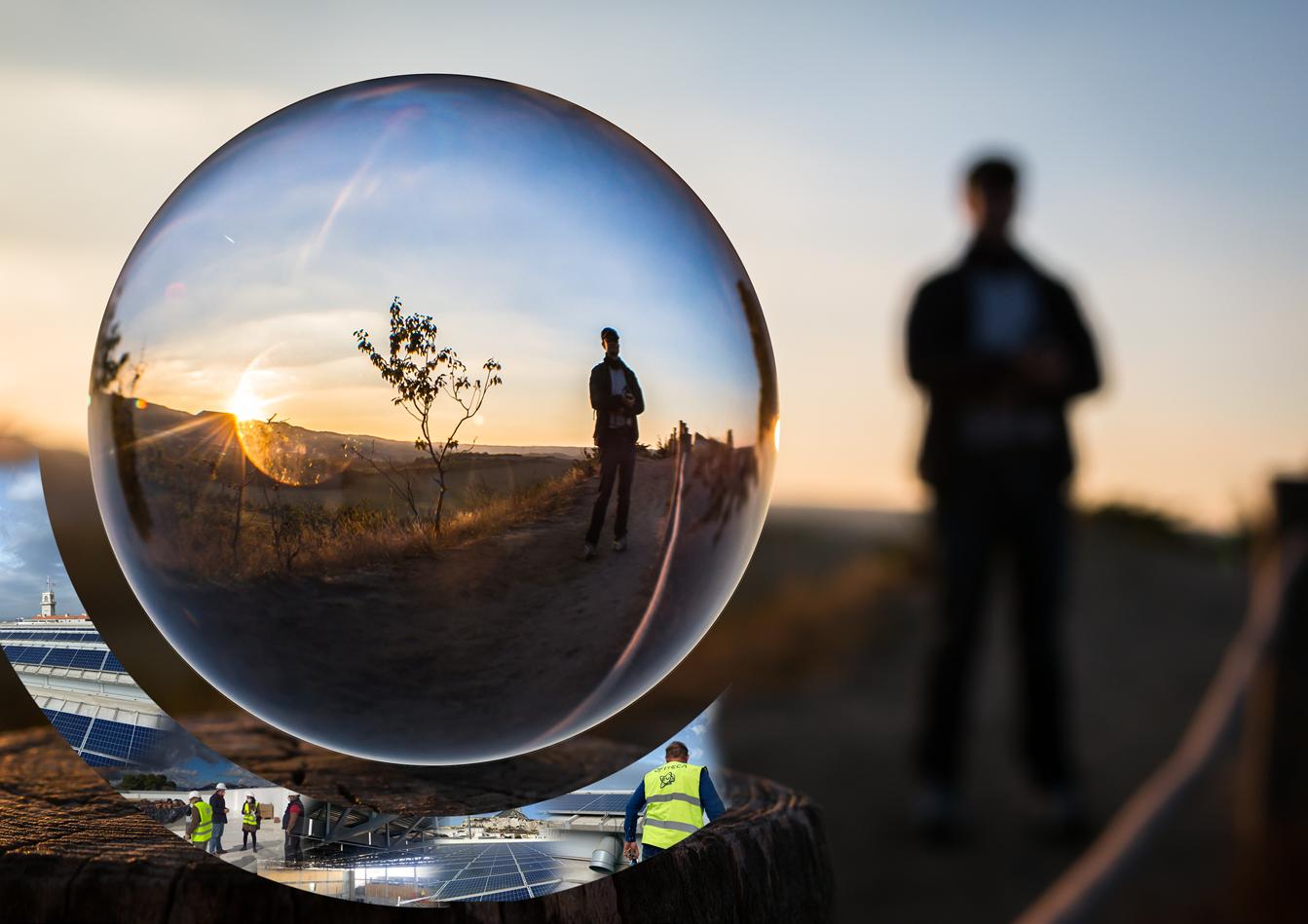









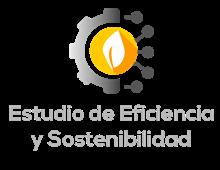
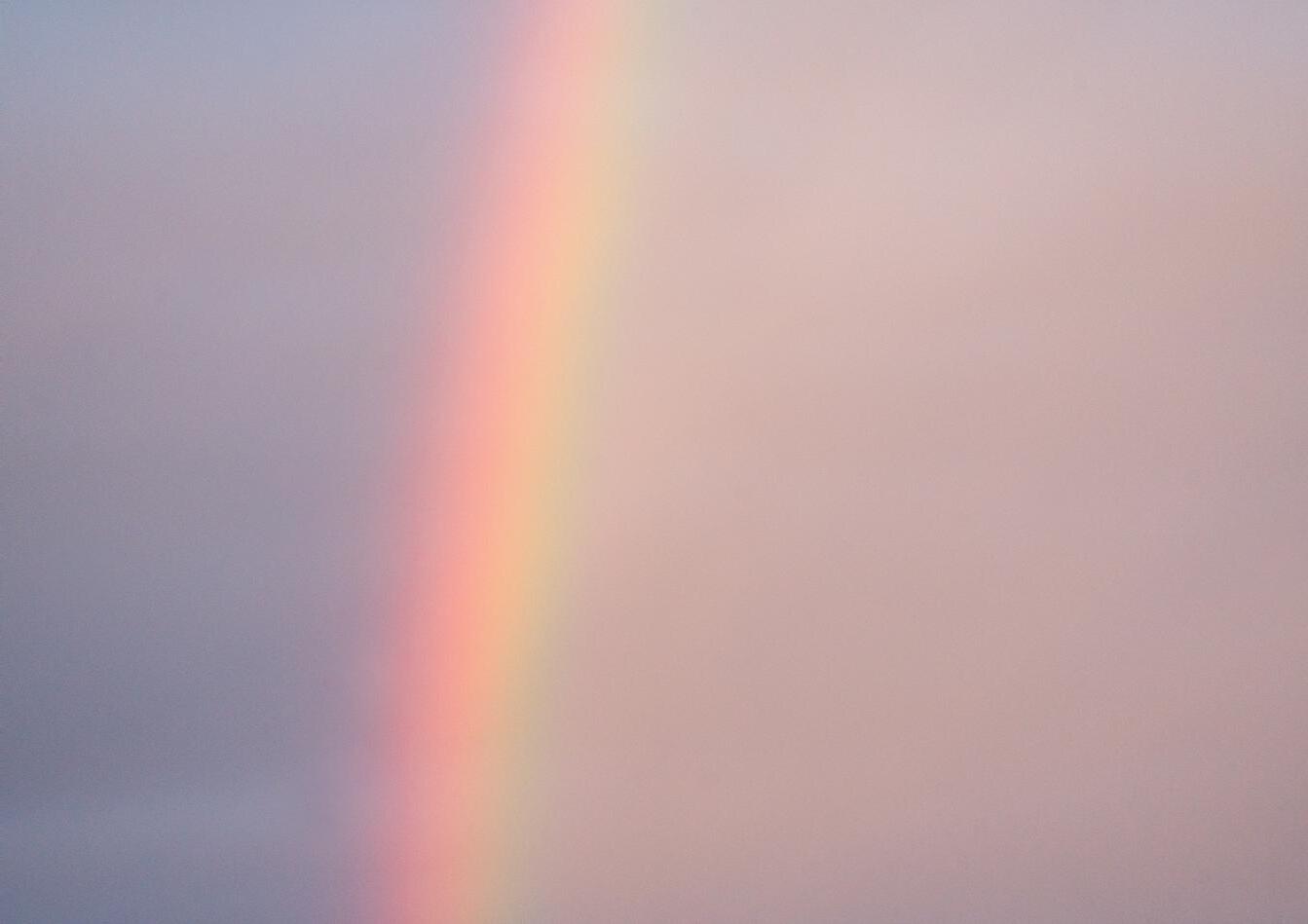
All societies now appear to be alive to the need for a clear and tangible commitment to fight climate change. To ensuring that we stop the unnecessary and wanton destruction of the world we live in.
It is widely accepted that the Construction Industry is in the top three of polluters in the world. In Gibraltar this figure is likely to be greater given our success in attracting investment. Whether Gibraltar or Spain however, the biggest challenge is the control of Energy waste within existing building portfolios which is by far the biggest consumer of energy.
To say that building and engineering practices have been lack in the past in the control of demand and use of energy is an understatement. The biggest challenge in this industry sector is therefore harnessing and controlling inefficiency within existing buildings.
In the excellent previous article, our colleagues at Coamba rightly put emphasis on the Universities in the area and highlight the need for transparent and ethical practices in this obviously important and influential sector.
At EVG in Gibraltar with our sister company EES in Spain, we have been working at developing tools for this precise problem. How to bring existing installations into control. How to provide consultancy services backed by engineering expertise that not only creates renewable energy where this is possible, or control and monitor the use of energy but provides real tangible advice on how to control systems and mitigate unnecessary energy wastage.
The economic consequences of the increased cost in energy is enormous. This reality is creating tremendous demand which in turn has resulted in a rush to market of products and services.
In next month’s issue we shall explain exactly what solutions we shall bring to market. Meanwhile if you have an installation that is wasteful, if you are confused by the sheer number of offers – do not hesitate to contact us on 00(350)54000826 or 00(34)677712329
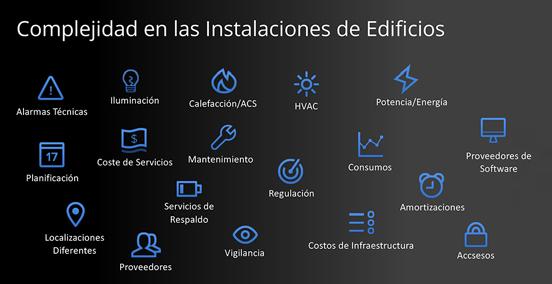
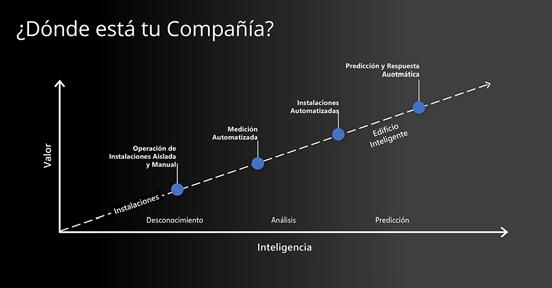




Todas las sociedades parecen ser conscientes ahora de la necesidad de un compromiso claro y tangible para luchar contra el cambio climático. Para garantizar que detenemos la destrucción innecesaria y gratuita del mundo en que vivimos.
Es un hecho ampliamente aceptado que el sector de la construcción se encuentra entre los tres más contaminantes del mundo. En Gibraltar es probable que esta cifra sea mayor, dado nuestro éxito a la hora de atraer inversiones. Sin embargo, ya sea en Gibraltar o en España, el mayor reto es el control de los residuos energéticos en los edificios existentes, que es, con diferencia, el mayor consumidor de energía.
Decir que las prácticas de construcción e ingeniería han sido deficientes en el pasado en el control de la demanda y el uso de la energía es quedarse corto. El mayor reto de este sector industrial es, por tanto, aprovechar y controlar la ineficiencia de los edificios existentes.
En el excelente artículo anterior, nuestros colegas de Coamba ponían acertadamente el acento en las Universidades de la zona y destacaban la necesidad de prácticas transparentes y éticas en este sector de evidente importancia e influencia.
En EVG, en Gibraltar, con nuestra empresa hermana EES en España, hemos estado trabajando en el desarrollo de herramientas para este problema concreto. Cómo controlar las instalaciones existentes. Cómo proporcionar servicios de consultoría respaldados por conocimientos de ingeniería que no sólo creen energía renovable cuando sea posible, o controlen y supervisen el uso de la energía, sino que proporcionen asesoramiento real tangible sobre cómo controlar los sistemas y mitigar el derroche innecesario de energía.
Las consecuencias económicas del aumento del coste de la energía son enormes. Esta realidad está creando una tremenda demanda que, a su vez, ha dado lugar a una avalancha de productos y servicios en el mercado.
En el número del mes que viene explicaremos exactamente qué soluciones sacaremos al mercado. Mientras tanto, si tiene una instalación que derrocha, si le confunde la cantidad de ofertas, no dude en ponerse en contacto con nosotros en el 00(350)54000826 o en el 00(34)677712329

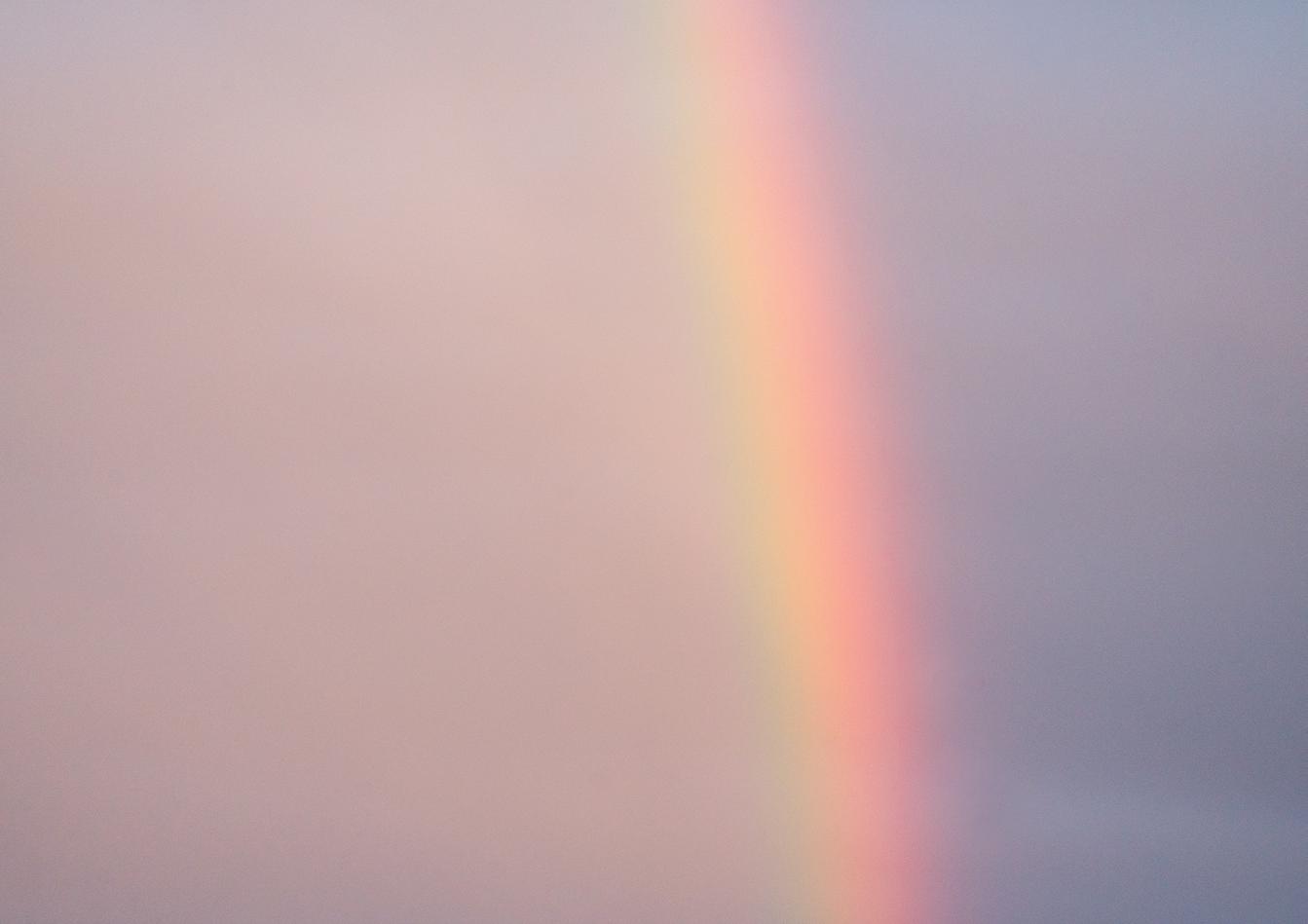

Cinéticas de incorporación de nutrientes en las macroalgas Ulva rigida y Ericaria selaginoides en el contexto de la eutrofización costera
María José Romero Pérez.
Environmentalist. Intern student IBYDA (Institute of Biotechnology and Blue Development). Thesis in Environmental Sciences. University of Málaga.
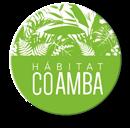
COAMBA is not the author of the published articles, but acts as an intermediary between the author who writes the article and the magazine.
COAMBA no es el autor de los artículos publicados, si no que actúa de intermediario entre la persona colegiada que escribe el artículo y la revista.

Introduction and background.
Coastal ecosystems are transitional systems between the marine and terrestrial environments. They are of great importance because they are unique environments due to their constant dynamism controlled by chemical, physical and biological processes. All these processes and environments change profoundly on a geographic scale, in time and duration, making these ecosystems very productive, but at the same time very vulnerable (Botello et al., 2011). Within these ecosystems, macroalgae constitute the majority of the biomass, reaching 40% of primary production, together with marine phanerogams. Macroalgae are a phylogenetically diverse group of photosynthetic organisms including green, red and brown seaweeds.
Los ecosistemas costeros son sistemas de transición entre el ambiente marino y el terrestre. Son de gran importancia, ya que son ambientes únicos por su constante dinamismo controlado por procesos químicos, físicos y biológicos. Todos estos procesos y ambientes cambian profundamente a escala geográfica, en el tiempo y en su duración haciendo que estos ecosistemas sean muy productivos, pero a la vez muy vulnerables (Botello et al., 2011). Dentro de estos ecosistemas, las macroalgas constituyen la mayor parte de la biomasa, alcanzando el 40% de la producción primaria, junto a las fanerógamas marinas. Las macroalgas son un grupo diverso filogenéticamente, constituido por organismos fotosintéticos en los que se incluye las algas marinas verdes, rojas y pardas.

In the intertidal, the distribution of communities is generally controlled by physical factors at higher elevations such as submergence, emersion, irradiance, temperature and nutrient availability, and by biological factors at lower elevations (Lewis, 1964; Sánchez de Pedro et al., 2013). Nutrient availability is an important factor in terms of community distribution, for example, species coexisting in the same habitat may compete for light, substrate and nutrients (Lobban and Harrison, 1994). In this sense, macroalgae possess different mechanisms to incorporate nutrients and therefore some species are able to survive when nutrients are scarce, thanks to their high absorption rates at low concentrations and high growth capacity by taking advantage of eventual nutrient pulses (Pedersen and Borum, 1997; Rosenberg et al, 1984; Sánchez de Pedro et al., 2013), while other slow uptake species make up for this disadvantage with high storage capacity (Campbell, 1999; Ryther et al., 1981; Sánchez de Pedro et al., 2013; Young et al., 2009).
Accordingly, changes in nutrient concentrations can lead some species to dominate the communities and others to disappear or reduce their presence considerably, causing a simplification of the complexity of the communities (Arévalo et al., 2007). As described by Grime (1977), the strategies that plants possess in the face of stress factors can be classified into three groups: (1) competitive species, which occupy areas of low stress and fluctuation, (2) tolerant species, which are capable of growing under unstable conditions, and (3) opportunistic species, which are those capable of taking maximum advantage of resources under conditions of contamination. This can give us an idea of the state of these waters according to the species we find and their abundance.
The great richness and diversity of coastal environments has led to a greater concentration of human activities on the coast. It is estimated that about 40% of the world's population lives near or on the coast (IOC/UNESCO, IMO, FAO, UNDP., 2011). The fluctuating conditions of the intertidal and the pressures linked to anthropogenic activities make them even more vulnerable to the effects of climate change.
One of the main human-induced changes is the increase of nutrient concentrations on the coasts
En el intermareal, la distribución de las comunidades está controlada generalmente por factores físicos en las zonas más altas como son la inmersión, emersión, irradiancia, temperatura y disponibilidad de nutrientes, y por factores biológicos en las zonas bajas (Lewis, 1964; Sánchez de Pedro et al., 2013). La disponibilidad de nutrientes es un factor importante en cuanto a la distribución de las comunidades, por ejemplo, las especies que conviven en el mismo hábitat pueden competir por luz, sustrato y nutrientes (Lobban y Harrison, 1994). En este sentido, las macroalgas poseen distintos mecanismos para incorporar los nutrientes y por ello algunas especies son capaces de sobrevivir cuando escasean los nutrientes, gracias a sus altas tasas de absorción a bajas concentraciones y alta capacidad de crecimiento aprovechando los pulsos eventuales de nutrientes (Pedersen y Borum, 1997; Rosenberg et al., 1984; Sánchez de Pedro et al., 2013), mientras que otras especies de lenta absorción suplen esta desventaja con una alta capacidad de almacenamiento (Campbell, 1999; Ryther et al., 1981; Sánchez de Pedro et al., 2013; Young et al., 2009).
De acuerdo con esto, los cambios de las concentraciones de nutrientes pueden llevar a unas especies a dominar las comunidades y otras a desaparecer o reducir su presencia considerablemente, provocando una simplificación de la complejidad de las comunidades (Arévalo et al., 2007). Según describe Grime (1977) las estrategias que poseen las plantas ante factores estresantes se pueden clasificar en tres grupos: (1) Las especies competitivas, que ocupan zonas de bajo estrés y fluctuación, (2) Las tolerantes que son capaces de crecer bajo condiciones inestables y (3) las oportunistas, que son aquellas capaces de aprovechar los recursos al máximo en condiciones de contaminación. Esto nos puede dar una idea del estado de esas aguas según las especies que encontramos y su abundancia.
La gran riqueza y diversidad de los ambientes costeros ha llevado a una mayor concentración de actividades humanas en el litoral. Se estima que alrededor del 40% de la población mundial vive cerca o en la costa (IOC/UNESCO, IMO, FAO, UNDP., 2011). Las condiciones fluctuantes del intermareal y las presiones ligadas a las actividades antropogénicas hacen que sean aún más vulnerables a los efectos del cambio climático.
due to activities such as construction, tourism, domestic dumping and the diffuse input of nitrogen and phosphate fertilizers, especially from agriculture and livestock.
Eutrophication increases primary production, which in many cases can lead to hypereutrophication, with massive algal blooms that generate conditions of anoxia and therefore a negative impact on the ecosystem (Campbell, 1999; Fonselius, 1978). We have seen extreme cases in the Meno River Sea in Murcia, due to intensive agriculture and human activities, where O2 values have reached below 1-2 mg/l, causing massive mortality of marine organisms. Hering et al., (2010) pointed out eutrophication as the most important cause of the state of regression of European coastal ecosystems, considering above all the reduction of nutrient discharges as a restoration measure.
In coastal systems, eutrophication causes a global impact that affects biogeochemical cycles, producing changes in benthic algal communities (Munda, 1993; Villares et al., 1998) and in zoo-benthic communities (Norkko and Bonsdorff, 1996; Pihl et al., 1995; Villares et al., 1998). The stress that can be generated by eutrophication of anthropogenic origin leads to the simplification of communities and a decrease in specific richness. Thus, the so-called ecosystem engineer species (Fucales and Laminariales), which are forest-forming and provide important ecosystem services, may be reduced or disappear and be replaced by fast-growing species; for example, E. Selaginoides (Linnaeus) Molinari & Guiry in the Mediterranean Sea may suffer a regression in an eventual eutrophication event; while the growth of opportunistic species such as Ulva Rigida (C. Agardh ) is favored (Rodríguez-Prieto & Polo, 1996).
Essential nutrients for macroalgae usually include elements such as nitrogen, phosphorus, iron and some metals such as magnesium. Nitrogen is one of the elements that can be limiting for macroalgae growth and in some cases phosphorus (Lobban and Harrison, 1997). It is also important to know the limiting N:P ratio for a given species, as this has been found to be genus and species dependent (Tilman et al., 1982). For example, on the Australian coasts it was found that for species of the genus Ulva the limiting factor was N and other species of the genus
Uno de los principales cambios inducidos por el ser humano es el aumento de concentraciones de nutrientes en las costas por actividades como la construcción, el turismo, vertidos domésticos y la entrada difusa de fertilizantes nitrogenados y fosfatados, sobre todo de agricultura y ganadería.
La eutrofización hace que aumente la producción primaria, que en muchas ocasiones puede provocar hipereutrofización, con proliferaciones masivas de algas que generan condiciones de anoxia y por tanto un impacto negativo en el ecosistema (Campbell, 1999; Fonselius, 1978). Casos extremos hemos podido en el Mar Meno,r en Murcia, a causa de la agricultura intensiva y actividades humana donde se han llegado a tener valores de O2 por debajo de 1-2 mg/l llegando a provocar una mortalidad masiva de organismos marinos. Hering et al., (2010) señalaron la eutrofización como la causa más importante del estado de regresión de los ecosistemas costeros europeos, considerando sobre todo la reducción de vertidos de nutrientes como medida de restauración.
En los sistemas costeros la eutrofización causa un impacto a nivel global que afecta a los ciclos biogeoquímicos, produciendo cambios en las comunidades de algas bentónicas (Munda, 1993; Villares et al., 1998) y en comunidades zoo bentónicas (Norkko y Bonsdorff, 1996; Pihl et al., 1995; Villares et al., 1998). El estrés que puede generar la eutrofización de origen antrópico lleva a la simplificación de las comunidades y a una disminución de la riqueza específica. De este modo, se pueden reducir o desaparecer las especies llamadas ingenieras de ecosistemas (Fucales y Laminariales), que son formadoras de bosques y proporcionan grandes servicios ecosistémicos y ser sustituidas por especies de crecimiento rápido.; por ejemplo, E. Selaginoides (Linnaeus) Molinari & Guiry en el mar Mediterráneo puede sufrir una regresión en un eventual suceso de eutrofización; mientras que se favorece el crecimiento de especies oportunistas como Ulva Rigida (C. Agardh ) (Rodríguez-Prieto & Polo, 1996).
Entre los nutrientes esenciales para las macroalgas se suelen incluir elementos como nitrógeno, fosforo, hierro y algunos metales como magnesio. El nitrógeno es uno de los elementos que puede ser limitante para el crecimiento de macroalgas y en algunos casos el fósforo (Lobban y Harrison, 1997).
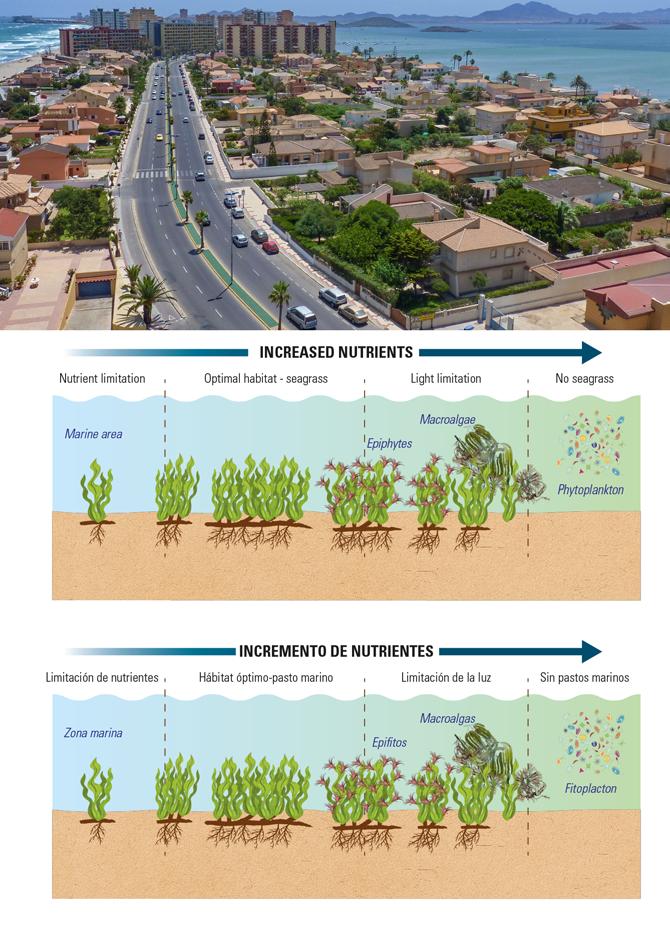
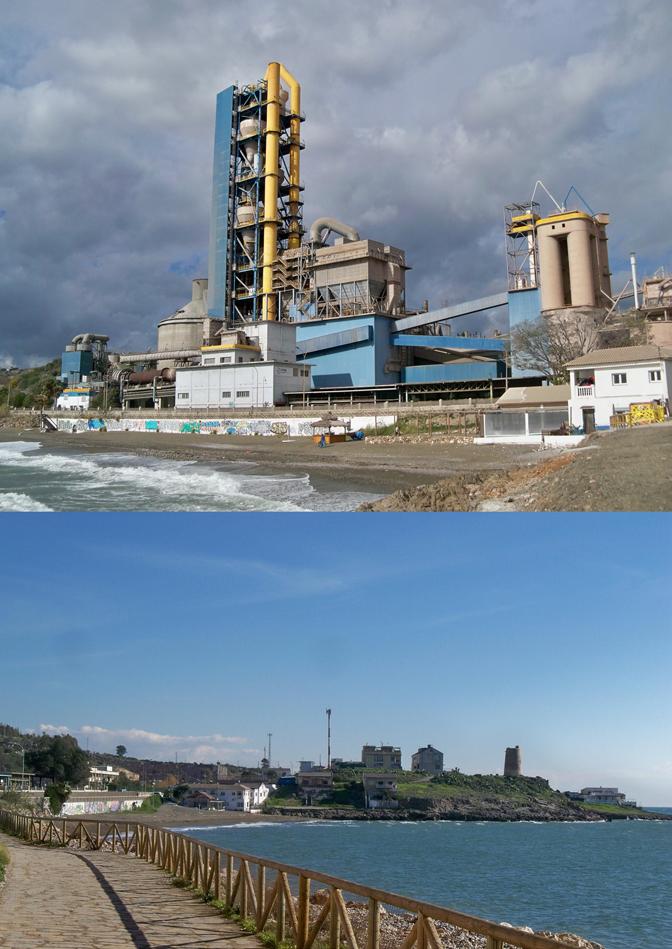
Cladophora were limited by lack of phosphorus (Valiela et al., 1987).
The problem of anthropogenic eutrophication
The problem of eutrophication due to human activities in coastal areas is recognized worldwide as a major threat to coastal ecosystems (Norkko and Bonsdorff, 1996; Valiela et al., 1997; Raffaelli et al., 1998; Sfriso et al., 2001). One of the main consequences on these ecosystems when nutrient loading increases is the change in communities and the spatial displacement of primary producers (Neto et al., 2012) such as macroalgae, affecting associated communities (macroinvertebrates, fish...) (Raffaeli et al., 1998) and the services they generate to the environment (Jonge et al., 2000).
In this context of increasing eutrophication, nutrient discharges of anthropogenic origin cause some species to be more favored than others. The growth rate, nutrient requirements and nutrient incorporation is directly related to the surface-area-to-volume ratio, so that filamentous and foliose macroalgae grow faster and require more nutrients per unit biomass and time (Karez et al., 2004; Pedersen and Borum, 1997). On eutrophicated rocky shores, the growth of annual filamentous algae increases, which may delay the emergence of perennial species (Pedersen and Borum, 1996; Schramm, 1999). This substitution by opportunistic species is a sign that there is increasing eutrophication in these waters (Orfanidis et al., 2001).
The current city model in Malaga is increasingly incompatible with sustainability and the maintenance of coastal water quality. The growing increase in construction on the coast only aggravates the deteriorating situation of the coasts. Specifically on the beach of La Araña, despite not being a place occupied massively by tourism, we do find other infrastructures that can affect the ecosystems of this beach. Mainly the cement plant, and later also the waste incinerator, the quarry and the highway.
The expansion that is taking place in the Malaga coasts motivates the study of how the increase of nutrients of anthropogenic origin will affect the incorporation rates of two typical algae of the coast: Ulva rigida, which in addition to having a high production capacity, is one of the dominant species of the Mediterranean coast (Figueroa et al., 2020), and
También es importante conocer la ratio N:P limitante para una especie dada, ya que se ha podido comprobar que esto depende del género y la especie (Tilman et al., 1982). Por ejemplo, en las costas australianas se vio que para especies del género Ulva el factor limitante era el N y otras especies del género Cladophora estaban limitadas por la falta de fósforo (Valiela et al., 1987).
La Problemática de la eutrofización antrópica El problema de la eutrofización a causa de las actividades humanas en las costas es reconocido mundialmente como una amenaza importante para los ecosistemas costeros (Norkko y Bonsdorff, 1996; Valiela et al., 1997; Raffaelli et al., 1998; Sfriso et al., 2001). Una de las principales consecuencias sobre estos ecosistemas cuando aumenta la carga de nutrientes, es el cambio en las comunidades y el desplazamiento espacial de los productores primarios (Neto et al., 2012) como las macroalgas, afectando a las comunidades asociadas (macroinvertebrados, peces…) (Raffaeli et al., 1998) y a los servicios que generan al entorno (Jonge et al., 2000). En este contexto de aumento de la eutrofización, las descargas de nutrientes de origen antrópico hacen que unas especies se vean más favorecidas que otras. La tasa de crecimiento, los requerimientos de nutrientes y la incorporación de éstos está directamente relacionado con la proporción superficie-área-volumen, por lo que las macroalgas filamentosas y foliosas crecen más rápido y precisan más nutrientes por unidad de biomasa y tiempo (Karez et al., 2004; Pedersen y Borum, 1997). En las costas rocosas eutrofizadas el crecimiento de algas filamentosas anuales aumenta, por lo que se puede retrasar la aparición de las especies perennes (Pedersen y Borum, 1996; Schramm, 1999). Esta sustitución por especies oportunistas es una señal de que hay una eutrofización creciente es esas aguas (Orfanidis et al., 2001).
El modelo de ciudad actual en Málaga es cada vez más incompatible con la sostenibilidad y con el mantenimiento de la calidad de las aguas costeras. El creciente aumento de las construcciones en el litoral no hace más que agravar la situación de deterioro de las costas. En concreto en la playa de la Araña, a pesar de no ser un lugar ocupado masivamente por el turismo, sí que encontramos otras infraestructuras
Ericaria selaginoides, which is considered an indicator of good water status (Diez et al., 1999), in addition to being a species that forms marine forests in the Mediterranean.
The incorporation of the nutrients ammonium, nitrate and phosphate was estimated following the multiple perturbation model, a method proposed by Pedersen (1994) that combines the multiple tube technique and the perturbation method. This technique measures the variation of nutrients at successive time intervals in culture media prepared with different initial substrate concentrations. This method provides information on all phases of incorporation and the dependence of incorporation rates on time.
The experiment was carried out in a range of environmentally eutrophic concentrations, whose initial concentrations were 100, 50, 25, 10 and 5 μM for ammonium and nitrate, and 50, 25, 10 and 5 μM for phosphate.
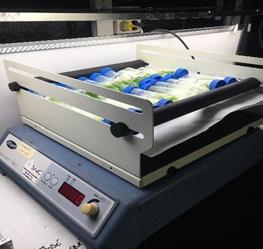
Results
In this study, the kinetic responses of incorporation for both species show clear differences according to nutrient and time. In general, Ulva rigida presented higher incorporation rates for all three nutrients. Constituting an advantage in a context of eutrophication.
The results obtained in this study point to an advantage of U. rigida over E. selaginoides for its
que pueden afectar a los ecosistemas de esta playa. Principalmente la cementera, y posteriormente también incineradora de residuos, la cantera y la autovía.
La expansión que se está llevando a cabo en las costas malagueñas motivan el estudio de cómo el aumento de nutrientes de origen antrópico afectará a las tasas de incorporación de dos algas típicas de la costa: Ulva rigida, que además de tener una alta capacidad de producción, es una de las especies dominantes de la costa mediterránea (Figueroa et al., 2020), y Ericaria selaginoides, la cual se considera indicadora del buen estado de las aguas (Diez et al., 1999), además de ser una especie que forma bosques marinos en el Mediterráneo.
Método de estudio
La incorporación de los nutrientes amonio, nitrato y fosfato se estimó siguiendo el modelo de la perturbación múltiple; método propuesto por Pedersen (1994) que combina la técnica de tubos múltiples y método de perturbación. Con esta técnica se mide la variación de los nutrientes en sucesivos intervalos de tiempo en medios de cultivos preparados con distintas concentraciones iniciales de sustrato. Este método ofrece información sobre todas las fases de incorporación y la dependencia de las tasas de incorporación en el tiempo.
El experimento se llevó a cabo en un rango de concentraciones ambientalmente eutróficas, cuyas concentraciones iniciales fueron 100, 50, 25, 10 y 5 μM para amonio y nitrato, y 50, 25, 10 y 5 μM para fosfato.
Resultados
En este estudio las respuestas cinéticas de incorporación para ambas especies muestran claras diferencias según el nutriente y el tiempo. En general, Ulva rigida presentó mayores tasas de incorporación para los tres nutrientes. Constituyendo una ventaja en un contexto de eutrofización.
Los resultados obtenidos en este estudio apuntan a una ventaja de U. rigida sobre E. selaginoides por sus mayores tasas de incorporación para nitrato y amonio. Esto concuerda con las características descritas para las especies del género Ulva como oportunista (Mayorga, 2009) que además de su morfología externa, presentan altas tasas de crecimiento y una alta capacidad de incorporar y metabolizar

Kinetics of NH4 + incorporation in U. rigida and E. selaginoides at successive time intervals (minutes). Cinética de incorporación de NH4 + en U. rigida y E. selaginoides en sucesivos intervalos de tiempo (minutos).

Kinetics of NO3- incorporation in U. rigida and E. selaginoides at successive time intervals (minutes). Cinética de incorporación de NO3- en U. rigida y E. selaginoides en sucesivos intervalos de tiempo (minutos).
higher incorporation rates for nitrate and ammonium. This is in agreement with the characteristics described for species of the genus Ulva as opportunistic (Mayorga, 2009) which, in addition to their external morphology, present high growth rates and a high capacity to incorporate and metabolize inorganic nitrogen (mainly NO - and NH +) (Cohen and Neori 1991; Littler and Littler, 1980; Rosenberg and Ramus 1984;). While E. selaginoides thrives in areas little affected by anthropogenic activities and without eutrophication (Bellan- Santini 1968; Belsher, 1979; Hoffmann et al., 1988; Ballesteros et al., 1998; Thibaut et al., 2005). In addition, benthic macroalgae such as E. selaginoides can help identify disturbed waters as bioindicators (Ballesteros et al., 2007).
However, in this study, high incorporation rates were obtained for high initial concentrations in E. selaginoides, even surpassing U. rigida in the first 15 minutes for NO -, so it could support some degree of eutrophication as suggested by Triano (2019). In this regard, Silva (2016) observed that E. selaginoides obtained higher incorporation rates than Ellisolandia elongata ((J. Ellis & Solander) K.R. Hind & G.W. Saunders) and Arévalo et al. (2007) indicated that species of this genus already occur in areas with nutrient levels three times higher than those reported in non-polluted areas.
Ammonium incorporation rates were higher than nitrate incorporation rates in both species, except for similar rates in E. selaginoides in the first half hour.
The lower metabolic cost for transport and assimilation of ammonium causes it to be preferentially taken up by many macroalgae (D'Elia and DeBoer, 1978; Pedersen & Borum 1997; Luo et al. 2012), and may explain the higher incorporation rates for ammonium than for nitrate in the species of the present study.
Phosphate depletion in the medium for both macroalgae was similar and did not show significant differences as for ammonium or nitrate. E. selaginoides did not deplete the nutrient in the medium for any initial concentration. In both macroalgae, a more rapid decrease is seen in the first 15 minutes, although in Ericaria only at higher concentrations, which may be due to metabolic differences between the two macroalgae.
nitrógeno inorgánico (fundamentalmente NO - y NH +) (Cohen y Neori 1991; Littler y Littler, 1980; Rosenberg y Ramus 1984;). Mientras que E. selaginoides prospera en zonas poco afectadas por actividades antropogénicas y sin eutrofización (Bellan- Santini 1968; Belsher, 1979; Hoffmann et al., 1988; Ballesteros et al., 1998; Thibaut et al., 2005). Además, las macroalgas bentónicas como E. selaginoides pueden ayudar a identificar aguas perturbadas como bioindicadores (Ballesteros et al., 2007).
Sin embargo, en este estudio se ha obtenido altas tasas de incorporación para concentraciones iniciales elevadas en E. selaginoides, incluso superando a U. rigida en los primeros 15 minutos para NO -, por lo que podría soportar cierto grado de eutrofización como sugirió Triano (2019). En este sentido, Silva (2016) observó que E. selaginoides obtuvo tasas de incorporación más altas que Ellisolandia elongata ((J. Ellis & Solander) K.R. Hind & G.W. Saunders) y Arévalo et al. (2007) indicaron que las especies de este género ya aparecen en zonas con niveles de nutrientes tres veces más altos que los informados en zonas no contaminadas.
Las tasas de incorporación de amonio fueron superiores a las de nitrato en ambas especies, salvo tasas similares en E. selaginoides en la primera media hora.
El menor coste metabólico para el transporte y asimilación de amonio hace que sea absorbido preferentemente por muchas macroalgas (D'Elia y DeBoer, 1978; Pedersen & Borum 1997; Luo et al. 2012), pudiendo explicar las mayores tasas de incorporación para el amonio que para el nitrato en las especies del presente estudio.
La diminución de fosfato en el medio para ambas macroalgas fue similar y no mostraron diferencias significativas como para el amonio o el nitrato. E. selaginoides no agotó el nutriente en el medio para ninguna concentración inicial. En ambas macroalgas se ve una disminución más rápida en los primeros 15 minutos, aunque en Ericaria solo a las concentraciones más altas lo que podrá deberse a las diferencias metabólicas entre ambas macroalgas.
Conclusiones
Ambas especies presentaron diferencias en sus tasas de incorporación, siendo Ulva rigida la que po-
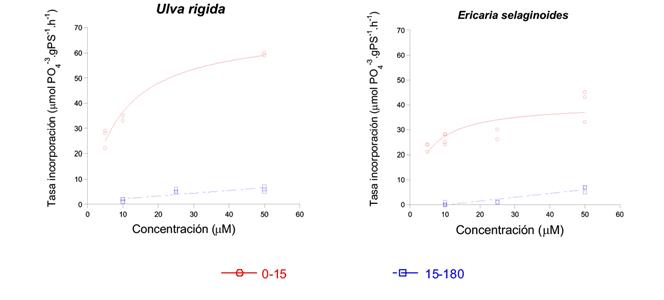
Kinetics of PO43- incorporation in U. rigida and E. selaginoides in the two successive time intervals (minutes). Cinética de incorporación de PO43- en U. rigida y E. selaginoides en los dos intervalos de tiempo sucesivos (minutos).
Conclusions
Both species showed differences in their incorporation rates, with Ulva rigida having higher Vmax for phosphate and ammonium, and higher incorporation rates for all three nutrients than E. selaginoides.
Ericaria selaginoides presented lower affinity for ammonium and nitrate than for phosphate while the affinity for phosphate was similar in both species.
Future research lines could study whether E. selaginoides has greater tolerance to polluted water and determine in both species the incorporation and accumulation of nutrients and long-term growth, to corroborate the possible changes that would occur in the macroalgae community, considering both species.
In a context of eutrophication, U. rigida could have an advantage over E. selaginoides due to the kinetic response and higher rates of nitrogen and phosphorus incorporation obtained, which could displace the latter.
Finally, it is worth mentioning the importance of the ecological status of waters, considering biological quality as the abundance and presence of bioindicator macroalgae species, since they respond to environmental changes such as nutrient concentration or hydromorphology (Neto et al., 2012). Therefore, today the European Water Framework Directive (WFD2000/60/EC) requires European member states to assess the ecological status of waters, thus considering macroalgae as indicators.
see una mayor Vmáx para el fosfato y amonio, y mayores tasas de incorporación de los tres nutrientes que E. selaginoides.
Ericaria selaginoides presentó menor afinidad por el amonio y nitrato que por el fosfato mientras que la afinidad por el fosfato fue similar en ambas especies.
En líneas futuras de investigación se podría estudiar si E. selaginoides tiene mayor tolerancia a las aguas contaminadas y determinar en ambas especies la incorporación y acumulación de nutrientes y crecimiento a largo plazo, para corroborar los posibles cambios que se darían en la comunidad de macroalgas, considerando ambas especies
En un contexto de eutrofización, U. rigida podría tener ventaja sobre E. selaginoides por la respuesta cinética y mayores tasas de incorporación de nitrógeno y fósforo obtenidas, pudiendo llegar a desplazar a esta última.
Finalmente cabe destacar la importancia del estado ecológico de las aguas, considerando la calidad biológica como la abundancia y presencia de especies de macroalgas bioindicadores, ya que éstas responden a los cambios del medio como la concentración de nutrientes o la hidromorfología (Neto et al., 2012).
Por ello, hoy día la Directiva Marco Europea del agua (DMA2000/60/CE), exige a los estados miembros europeos evaluar el estado ecológico de las aguas, considerando así a las macroalgas como indicadoras.



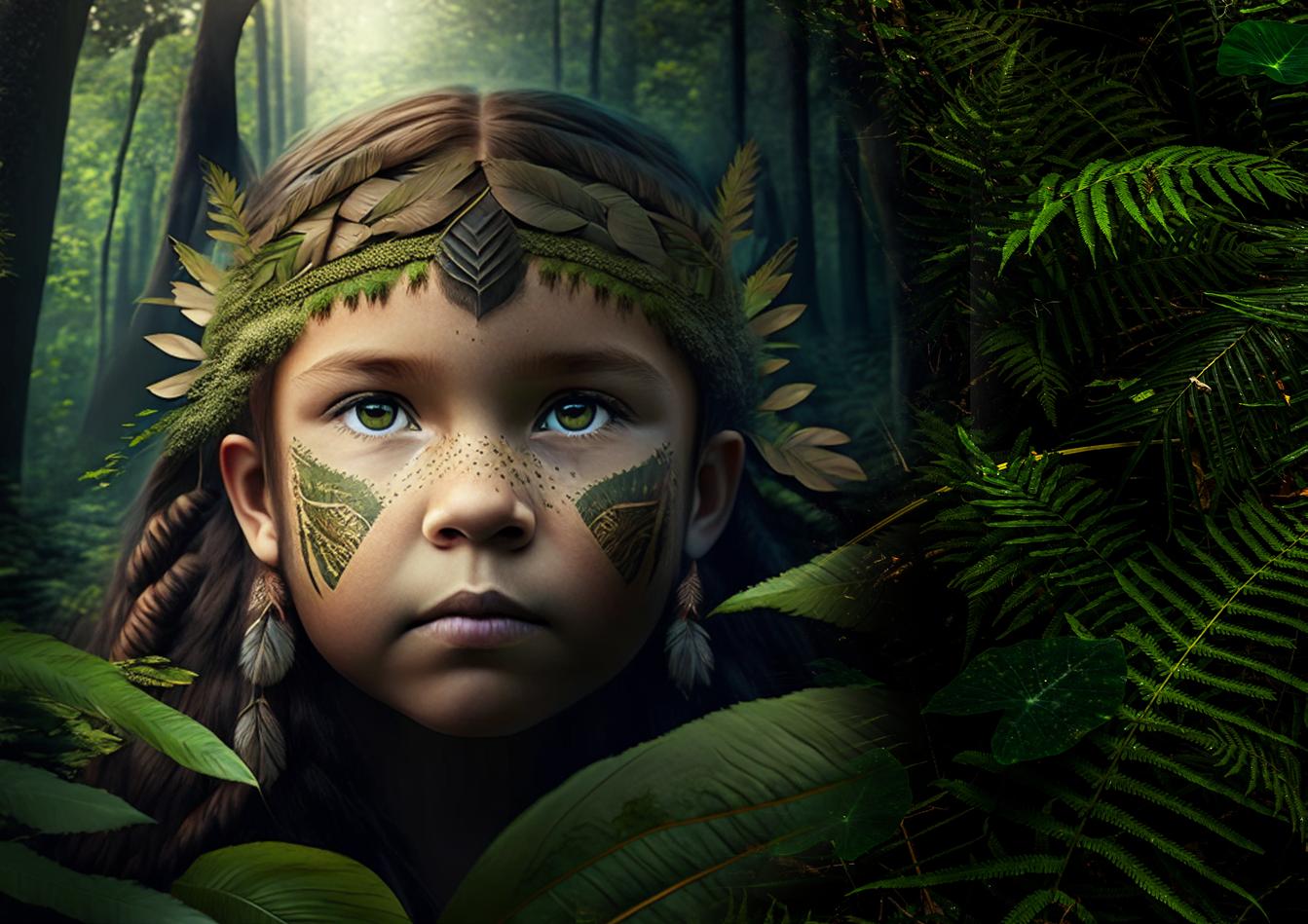
Text and photographs: Mercedes Versaci-Insúa
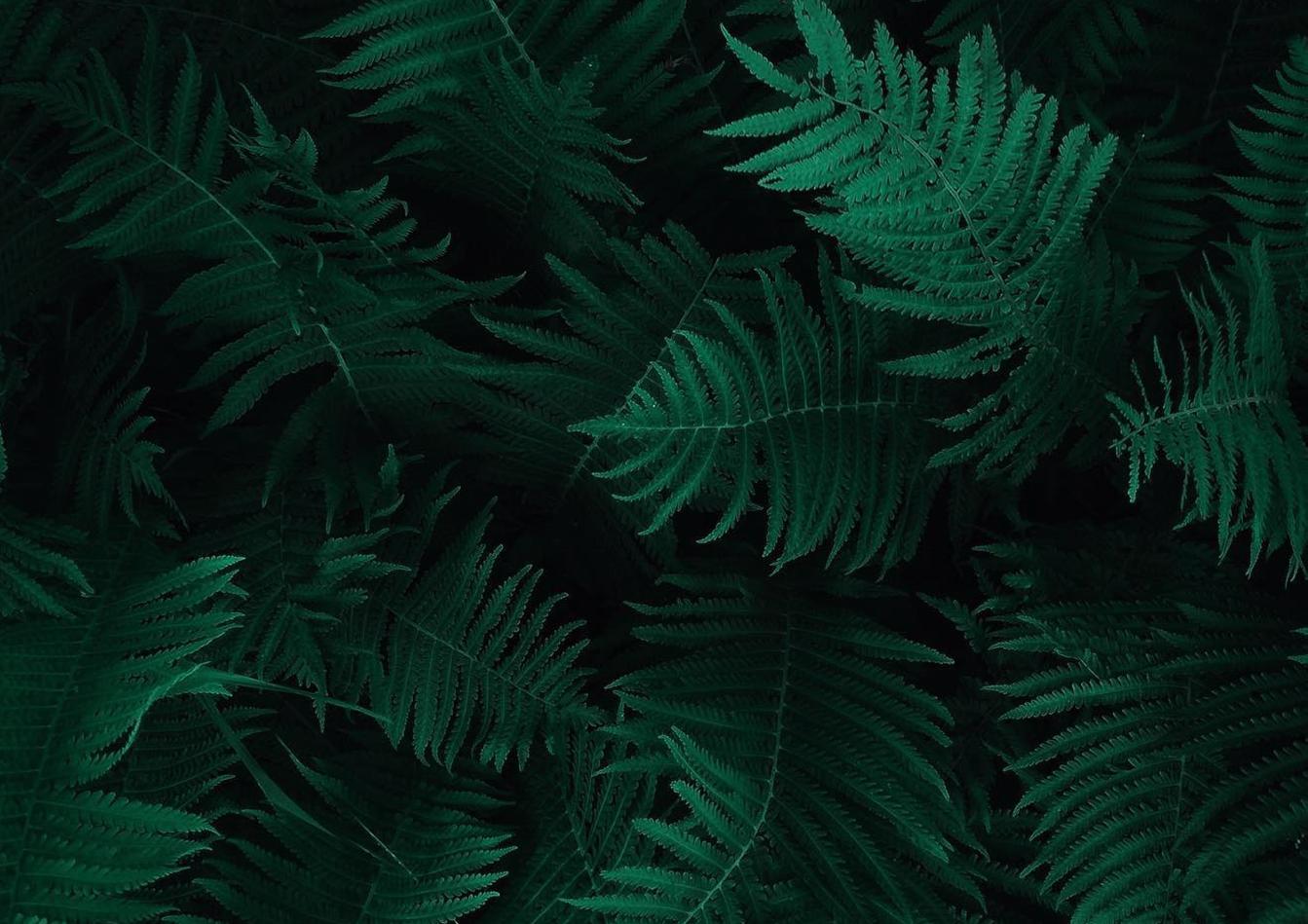

Hours had passed since they had departed from the village, yet the girl showed no signs of fatigue. Her constant and somewhat hurried pace elicited complaints from one of her younger brothers, who invariably found himself on her youthful but comforting shoulders. The anticipation of what lay ahead filled her with energy, the very same energy that had kept her awake throughout the entire night, ready to run out and take the lead in the line of children.
Once a year, since time immemorial, the inhabitants of the villages surrounding the Great Lagoon would gather at the Giant's Sanctuary. They came to express gratitude to the cave spirits for the harvests and to strengthen the bonds, many familial, that existed among them. They arrived from all directions, crossing valleys and misty forests, rivers and wetlands. The wetlands were the most stressful, requiring heightened senses and a quickened pace to protect the children from the bites of insects or reptiles that inhabited these places.
The village to which she belonged was not among the farthest from the Sanctuary. Its people began their journey with the first rays of the sun and reached their destination with the last. Despite the journey's brevity, it was carried out in stages for strategic reasons. The first group to depart consisted of children, the elderly, and pregnant women, along with mothers still carrying their little ones. A few hours later, the second group, composed of men and women responsible for carrying the goods and animals for "the Ceremony of the Union," would set out. The elderly or sick who could not undertake this journey were left in the care of a family clan member. She was almost always the first to glimpse the Sanctuary. She would strive to distance herself from the group, climbing to high places to scan the horizon and sharpen her senses. The echo of flutes and voices singing in unison, melodies that seemed to emanate from the earth's core, sent shivers down her spine. That eternal instant of ecstasy that seized her confirmed her proximity to the ceremonial centre, leaving her momentarily paralyzed. By journey's end, her small but sturdy feet were covered with wounds and thorns that would take time to remove. Despite her mother's insistence that she wear the esparto grass and leather sandals her grandmother had crafted, she preferred to feel the
Hacía horas que habían partido del poblado y la niña no acusaba cansancio alguno. El ritmo constante y más bien apresurado que llevaba, provocaba la queja de uno de sus hermanos más pequeños, quien terminaba siempre en sus infantiles pero acogedores hombros. La emoción por lo que estaba por vivir la llenaba de energía, la misma que la había mantenido despierta durante toda la noche, presta a salir corriendo y ponerse al frente de la columna de niños. Una vez al año, desde tiempos inmemoriales, los habitantes de los poblados del entorno de la Gran Laguna se reunían en el Santuario del Gigante, con el fin de agradecer a los espíritus de las cuevas las cosechas obtenidas y también para afianzar los lazos, muchos de parentesco, que existían entre ellos. Llegaban desde todas las direcciones cruzando valles y bosques de niebla, ríos y humedales. Estos eran los más estresantes, en ellos había que agudizar los sentidos y apresurar la marcha ya que los niños y niñas, principalmente, podrían sufrir picaduras de insectos o reptiles que habitaban en este tipo de parajes.
El poblado al cual ella pertenecía no era de los más distantes del Santuario, su gente comenzaba el viaje cuando aparecían los primeros rayos del sol y con los últimos llegaban a su destino. A pesar de la corta duración del periplo, por razones estratégicas, se realizaba de forma escalonada. En el primer grupo que partía iban los niños, ancianos y mujeres en estado avanzado de gestación junto con las que aún cargaban con sus pequeños a cuestas. Pocas horas después salía el segundo grupo, compuesto por hombres y mujeres que se ocupaban de portar los bultos y animales que llevarían a «la Ceremonia de la Unión». Los ancianos o enfermos que no podían realizar este viaje quedaban al cuidado de algún miembro del clan familiar.
Ella era casi siempre la primera en divisar el Santuario. Intentaba ganar distancia del grupo y subir a lugares altos para otear el horizonte y agudizar sus sentidos. El eco del sonido de flautas y voces entonando al unísono melodías que parecían surgir del mismo centro de la tierra, erizaban su piel. Ese segundo eterno de éxtasis que se apoderaba de ella confirmaba su cercanía al centro ceremonial y, por un momento, la dejaba paralizada.
Al final del camino sus pequeños pero fuertes pie-

earth, moss, water, stones, and mud beneath her feet. She felt more secure knowing what she was stepping on, sensing that all those elements that were once wolf bones, bird feathers, seashells, or snake skin were part of her very being. She was the earth.
In 1913, Colonel, writer, and ornithologist Willoughby Cole Verner discovered a group of painted shelters. The first reports of this site, called Bacinete, were recorded by H. Breuil and Burkitt in their work "Rock Painting of Southern Andalusia" (1929).
Located in the Natural Park of Los Alcornocales, in the eastern foothills of the Sierra del Niño (Los Barrios, Cadiz), this set of ten painted shelters is nestled among ferns and abundant watercourses.
Though situated at a high altitude from where the Strait of Gibraltar can be seen, the large blocks of Aljibe sandstone in which the cavities formed are hidden in a hollow, creating a magical and mysterious landscape among the colossal stony giants.
The shelter known as "Abrigo Principal" stands out among the group. It's a concave cavity elevated a metre and a half from the ground, resembling an amphitheatre. It features over 170 paintings with various motifs: human figures, animals, and abstract designs. Among the human figures, a large one in the centre of the painted panel, "the giant of Bacinete," dominates. The style of the paintings is schematic with a naturalistic tendency typical of this area. Our research team (PAIDI HUM 812 Group of the University of Cadiz) collaborated with the University of Barcelona's project ARTSOUNDSCAPES, studying the acoustics of shelters with post-Palaeolithic cave paintings. The results obtained, along with ethnographic studies, allow us to hypothesise that this shelter, with its impressive acoustic properties and location within the archaeological site, would have served as an amphitheatre. Ritual practices abundant with stories and the echoes of voices, flutes, and drums would have united the spectators, possibly leading them to altered states of consciousness.
Sound would not be a tangential component of these spiritual gatherings but an integral one. It would serve as a powerful tool in unifying the groups gathered there. Just as the girl needed to feel connected to the earth through the soles of her feet, sound was an indispensable part of this impressive biocultural complex.
cecitos estaban cubiertos de heridas y espinas que le llevaría tiempo quitarse. Por mucho que su madre insistiera en que calzara las sandalias de esparto y cuero que su abuela le había confeccionado, ella prefería sentir su piel en contacto con la tierra, el musgo, el agua, las piedras, el lodo… se encontraba más segura sabiendo lo que pisaba, percibiendo que todos esos elementos que una vez fueron huesos de lobo, plumas de pájaros, caracoles marinos o piel de serpiente formaban parte de su propio ser. Ella era la tierra.
En 1913 el coronel, escritor y ornitólogo Willoughby Cole Verner, descubre un grupo de abrigos pintados. Las primeras noticias sobre este yacimiento denominado Bacinete las recogerán H. Breuil y Burkitt en su obra Rock Painting of Southern Andalusia (1929).
Ubicado en el Parque Natural de los Alcornocales, en las estribaciones orientales de la Sierra del Niño (Los Barrios, Cádiz), cubierto de helechos y recorrido por cursos de agua en abundancia se encuentra este conjunto de diez abrigos pintados. Aunque ubicados en una zona de altura desde donde puede divisarse el Estrecho de Gibraltar, los grandes bloques de Arenisca del Aljibe en los cuales se formaron las cavidades, están en una hondonada que las mantiene casi ocultas, formando un paisaje mágico y misterioso entre los corredores que separan estos grandes canchos, colosos pétreos.
Del conjunto de abrigos destaca el llamado «Abrigo principal». Se trata de una cavidad cóncava elevada a un metro y medio del suelo y que recuerda la figura de un anfiteatro. Cuenta con más de 170 pinturas con diferentes motivos: figuras humanas, animales y motivos abstractos. Entre las figuras humanas predomina una de gran tamaño en el centro del panel pintado, «el gigante de Bacinete». El estilo de las pinturas es esquemático con una tendencia naturalista propia de esta zona.
Nuestro equipo de investigación (Grupo PAIDI HUM 812 de la Universidad de Cádiz) ha colaborado en el proyecto de investigación de la Universitat de Barcelona ARTSOUNDSCAPES: la acústica de los abrigos con manifestaciones rupestres postpaleolíticas. Los resultados obtenidos en este yacimiento y los estudios etnográficos realizados, permiten plantear la hipótesis de que este abrigo, por sus im-
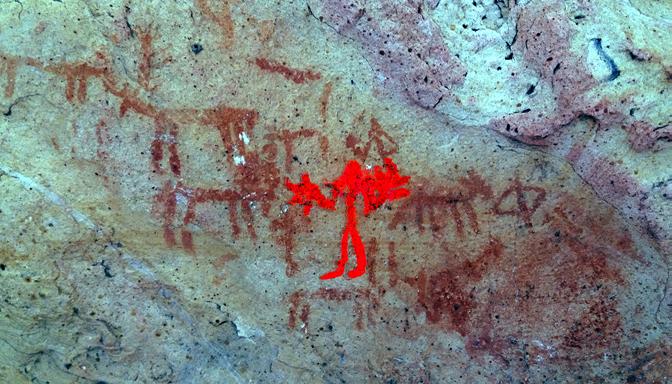


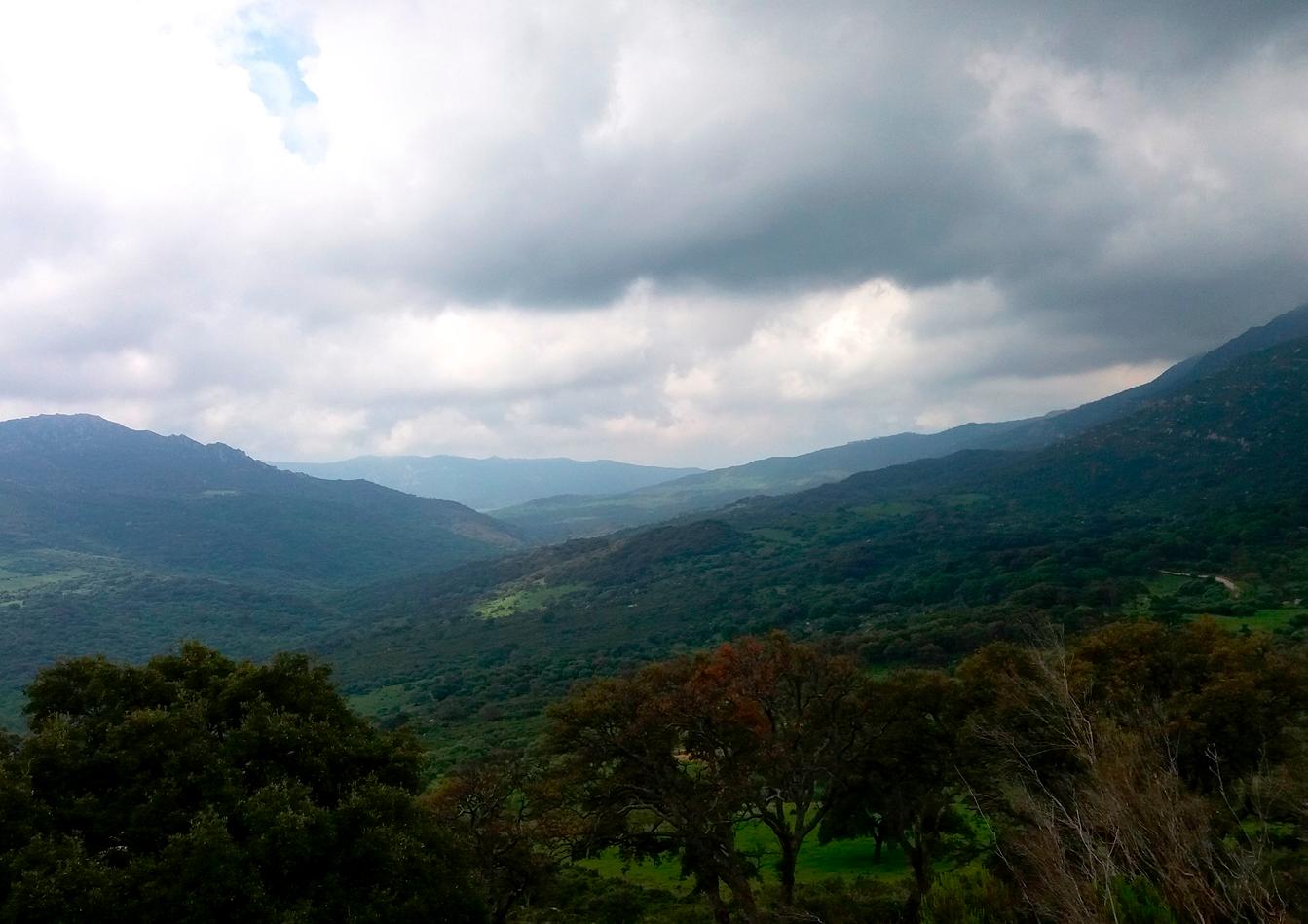
presionantes propiedades acústicas y su ubicación dentro de todo el conjunto arqueológico, tendría una función de anfiteatro. En este lugar se habrían realizado prácticas rituales en las que abundarían los relatos, fuente importante de su cosmovisión, y donde los ecos de sonidos de voces, flautas y tambores unirían a los espectadores llevándolos, posiblemente, a estados alterados de conciencia.
El sonido no sería un componente tangencial de estas reuniones espirituales, sino integral, y constituiría una herramienta poderosa a la hora de cohesionar a los grupos allí reunidos. Así como la niña habría necesitado sentirse unida a la tierra a través de las plantas de sus pies, también así el sonido formaría parte indispensable de este impresionante complejo biocultural.
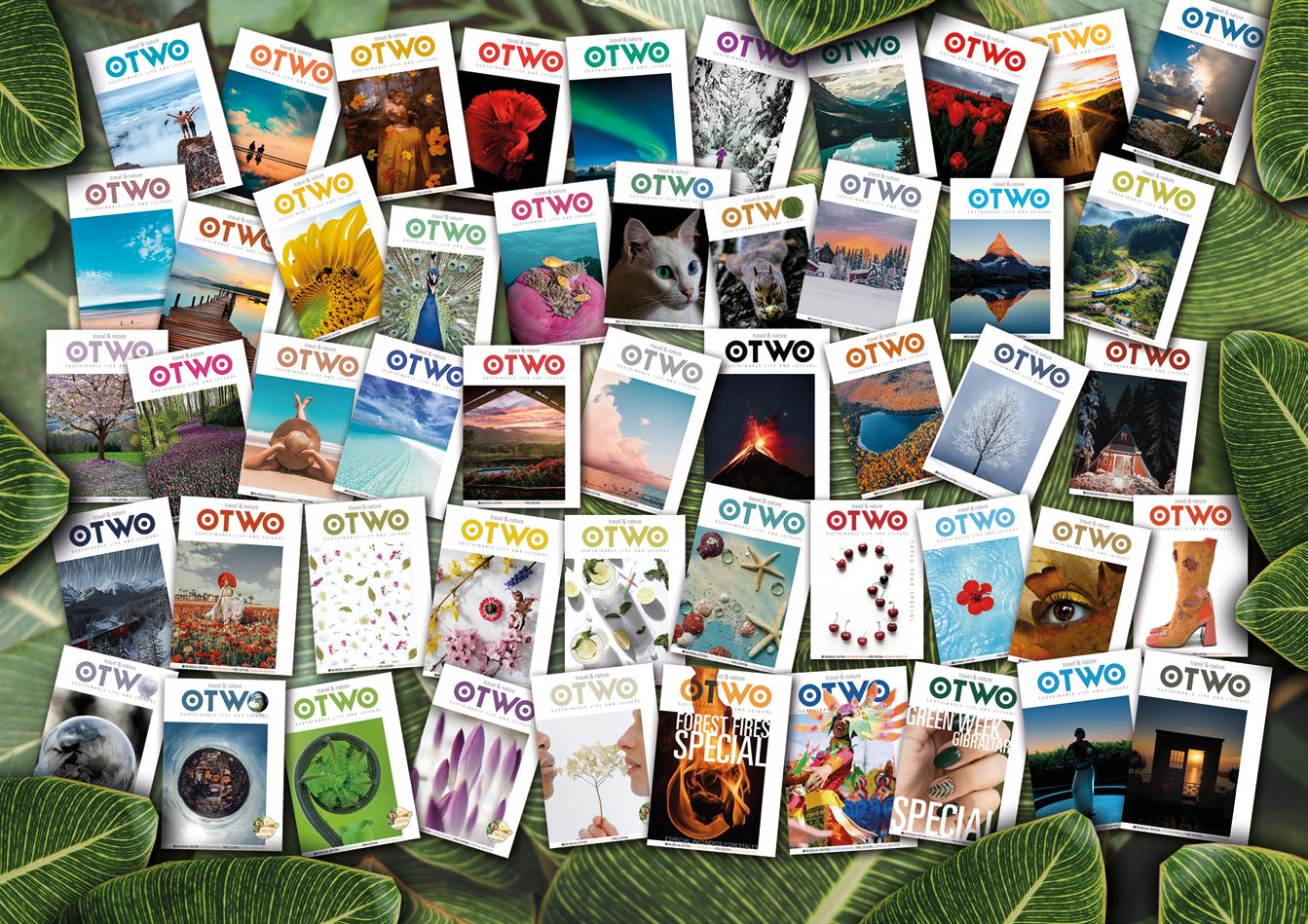
Manifestaciones de un organismo vivo en sus cincuenta números de existencia
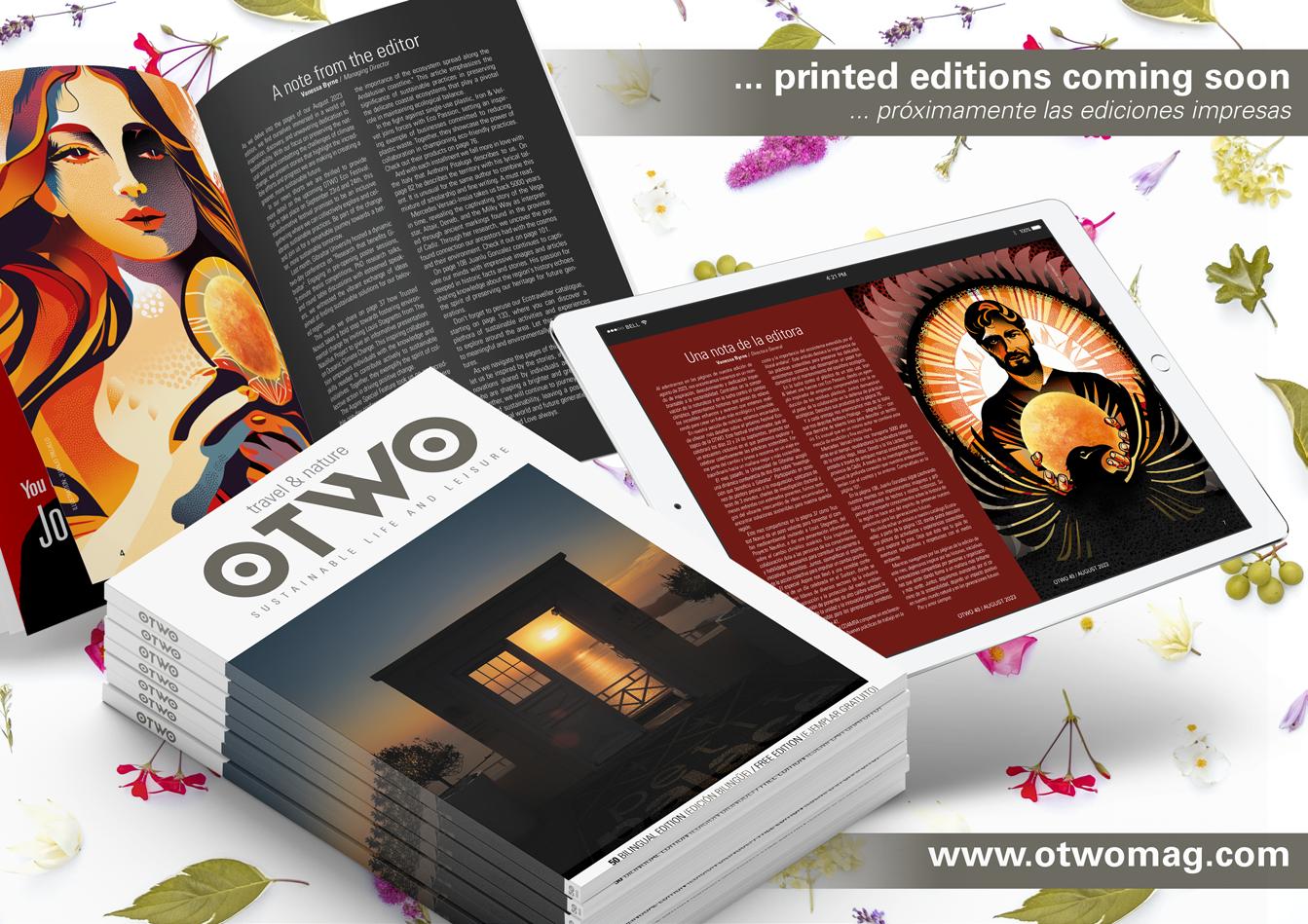
Verona
Milan Venice
Sestri Levante
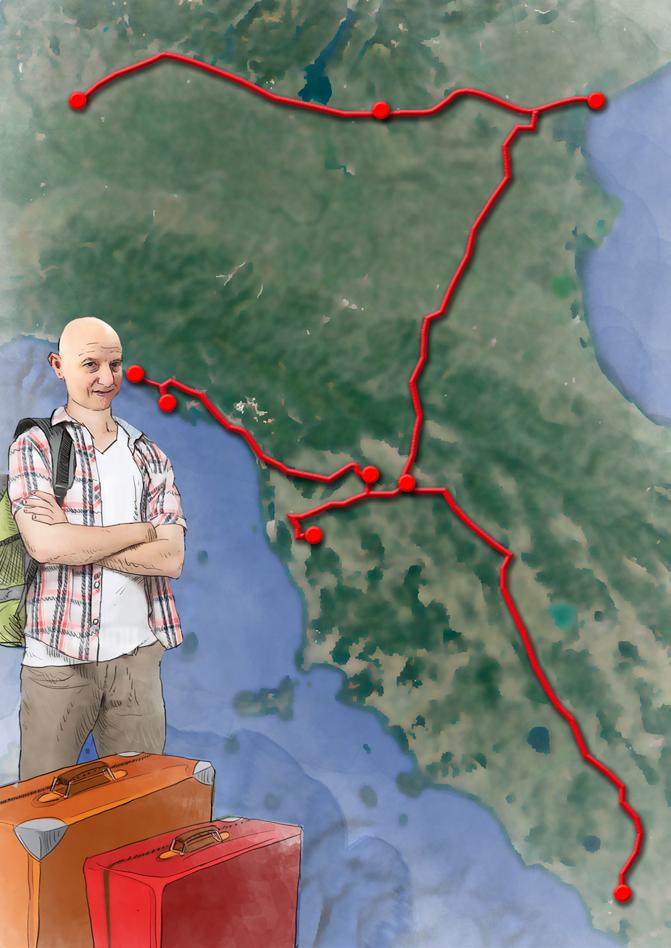
With a short journey ahead, we left the beautiful coastal town of Monterosso al Mare, one of the five villages that make up the celebrated Cinque Terre National Park. This brief stretch of road would take us to Sestri Levante our next destination An independent town and commune located in the province of Genoa, Sestri Levante operates its own local government and administrative structure.
Heading southeast on the SP38, commonly known as Strada Provinciale Trentotto, the distance to Sestri Levante is approximately fifty kilometres. Under normal traffic and weather conditions, the journey by car from Monterosso al Mare to our destination takes around one hour. The picturesque route winds along the Ligurian coastline moving across the town of Levanto, considered the gateway to the Cinque
Vinci
Florence
Pisa
La experiencia italiana:. Capítulo Ocho. Sestri Levante
Text and photographs: Anthony Pitaluga.
Rome
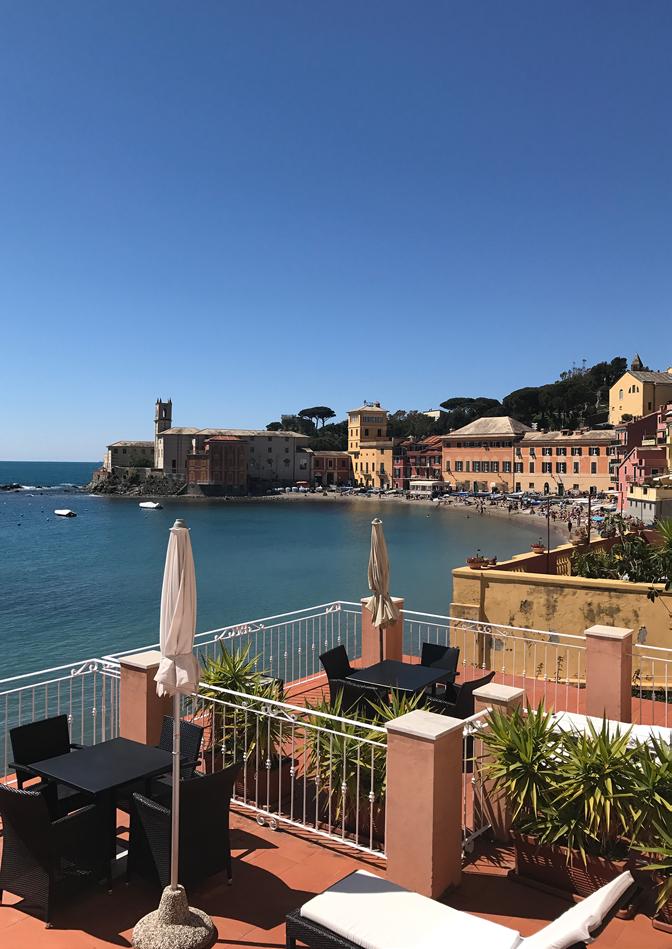
Con un corto trayecto por delante, abandonamos la bella localidad costera de Monterosso al Mare, uno de los cinco pueblos que conforman el célebre Parque Nacional de Cinque Terre. Este breve tramo de carretera nos llevaría a Sestri Levante, nuestro próximo destino. Sestri Levante, ciudad y municipio independiente situado en la provincia de Génova, cuenta con su propio gobierno local y estructura administrativa.
En dirección sureste por la SP38, comúnmente conocida como Strada Provinciale Trentotto, la distancia a Sestri Levante es de aproximadamente cincuenta kilómetros. En condiciones normales de tráfico y meteorología, el trayecto en coche desde Monterosso al Mare hasta nuestro destino dura aproximadamente una hora. La pintoresca ruta ser-
Terre National Park. With time on our hands, we decided to make a brief stopover in Levanto and explore this bustling coastal town which is famous for its colourful history manifested in its medieval architecture and landmarks.
Levanto, known as Ceula in Roman times, is located between a region of densely wooded hills situated just north of the Cinque Terre area, at the mouth of a small body of flowing water named after the town. Richly forested, the hills surrounding Levanto are brimming with olive and pine trees.
Considerably larger than the individual Cinque Terre villages, Levanto offers more in the way of amenities, including a wider range of hotels, restaurants, cafés, and touristic services. We parked our car and set off on foot towards the centre of town for coffee and pastries. On the way to the historic centre, we stopped at the Levanto tourist office and picked up a colourful brochure with the aim of acquainting ourselves with the key attractions the town offered.
Common to many Italian towns and cities, Levanto is home to a number of historical points of interest, including Castello di Levanto, a medieval 13th century castle, as well as two gothic styled churches, Chiesa Sant'Andrea and Chiesa Santa Maria della Costa. We made our way to the castle which is privately owned and not open to the public. However, it was well worth the visit because its outward appearance exhibits an impressive state of conservation which is undeniably evident.
Before resuming our journey to Sestri Levante, we visited the two churches I alluded to previously. The 13th-century Chiesa Sant'Andrea (Church of Saint Andrew), with an impressive facade decorated in black and white stripes, followed by the pre-13th century Chiesa Santa Maria della Costa (Church of Saint Mary of the Coast). Just like Castello di Levanto, these two medieval churches present a state of preservation worthy of praise, testament of national reverence, cultural pride, and shrewd investment.
We left Levanto heading southeast on the SS1 coastal road, also known as via Aurelia, named after the Roman consul Marcus Aurelius Cotta Via Aurelia was a major Roman road constructed in the third century BCE during the era of the Roman Republic. The SS1 to Sestri Levante runs along the same path taken by the ancient Roman road, remnants of which
pentea a lo largo de la costa ligur atravesando la localidad de Levanto, considerada la puerta de entrada al Parque Nacional de Cinque Terre. Con el tiempo libre, decidimos hacer una breve parada en Levanto y explorar esta bulliciosa ciudad costera, famosa por su colorida historia manifestada en su arquitectura medieval y sus monumentos.
Levanto, conocida como Ceula en tiempos de los romanos, se encuentra entre una región de colinas densamente arboladas situada justo al norte de la zona de Cinque Terre, en la desembocadura de una pequeña masa de agua corriente que lleva el nombre de la ciudad. Ricamente arboladas, las colinas que rodean Levanto rebosan de olivos y pinos.
Considerablemente más grande que los pueblos de Cinque Terre, Levanto ofrece más comodidades, como una mayor variedad de hoteles, restaurantes, cafeterías y servicios turísticos. Aparcamos el coche y nos dirigimos a pie hacia el centro de la ciudad para tomar un café y unos pasteles. De camino al centro histórico, nos detuvimos en la oficina de turismo de Levanto y recogimos un folleto en color con el objetivo de familiarizarnos con las principales atracciones que ofrecía la ciudad.
Al igual que muchas ciudades italianas, Levanto alberga varios puntos de interés histórico, como el Castello di Levanto, un castillo medieval del siglo XIII, y dos iglesias de estilo gótico, la Chiesa Sant'Andrea y la Chiesa Santa Maria della Costa. Nos dirigimos al castillo, que es propiedad privada y no está abierto al público. Sin embargo, mereció la pena visitarlo porque su aspecto exterior muestra un impresionante estado de conservación que resulta innegablemente evidente.
Antes de reanudar nuestro viaje a Sestri Levante, visitamos las dos iglesias a las que he aludido anteriormente. La Chiesa Sant'Andrea (Iglesia de San Andrés), del siglo XIII, con una impresionante fachada decorada con franjas blancas y negras, seguida de la Chiesa Santa Maria della Costa (Iglesia de Santa María de la Costa), anterior al siglo XIII. Al igual que el Castello di Levanto, estas dos iglesias medievales presentan un estado de conservación digno de elogio, testimonio de reverencia nacional, orgullo cultural y astuta inversión.
Salimos de Levanto en dirección sureste por la carretera costera SS1, también conocida como vía
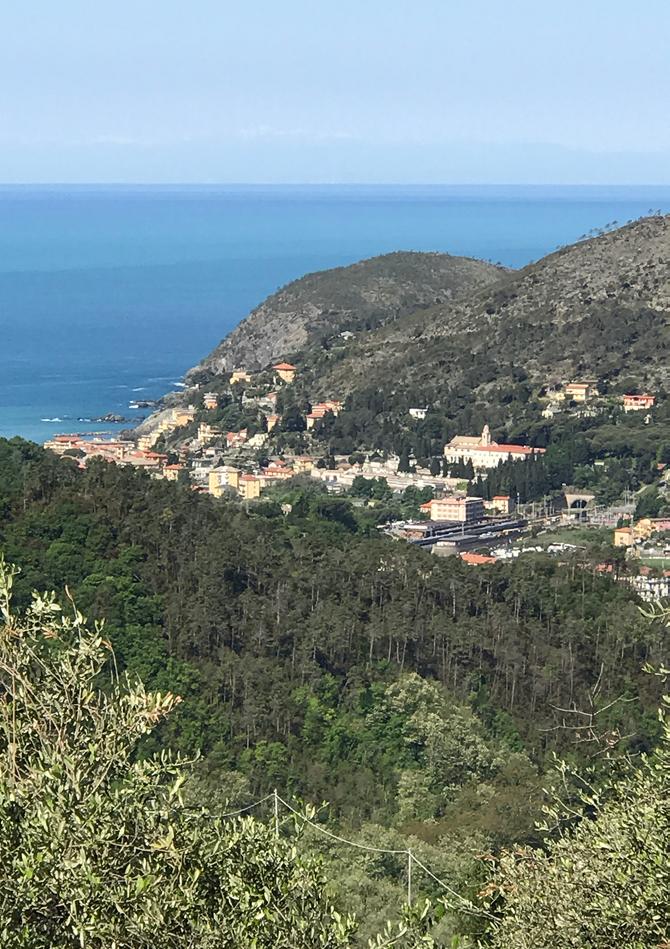
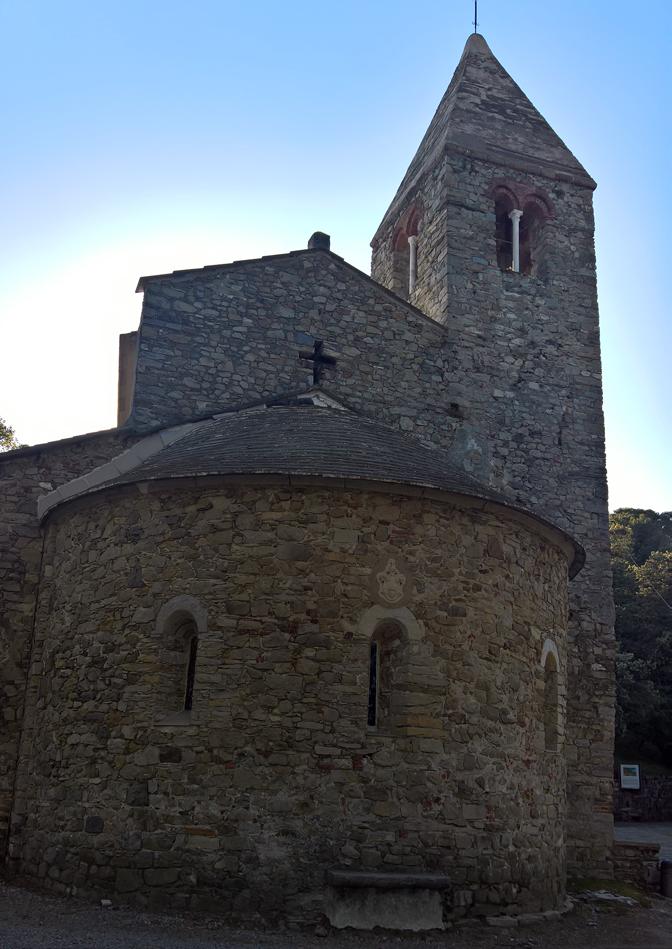
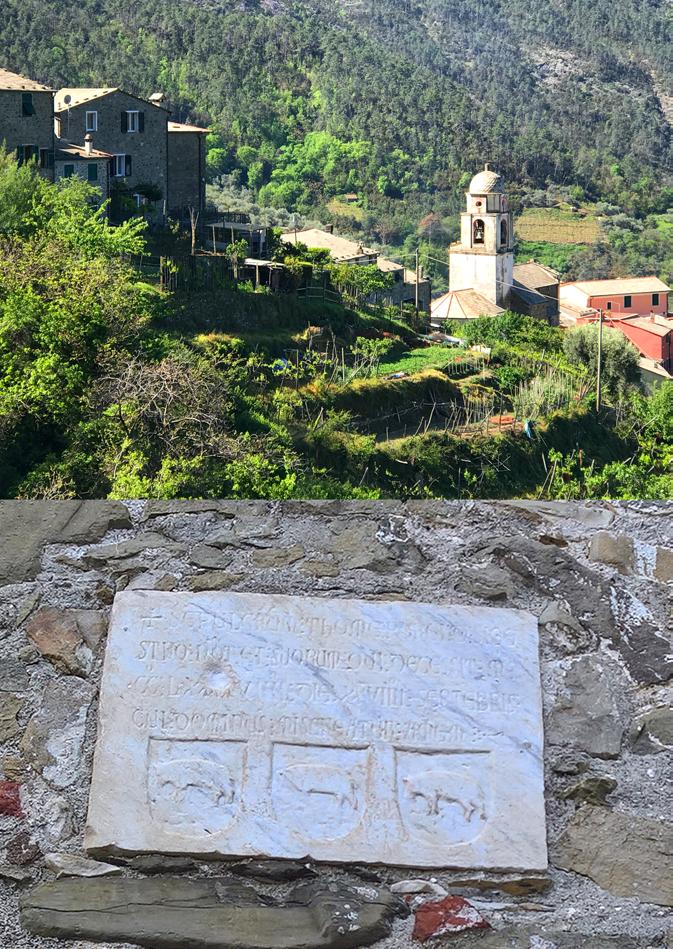
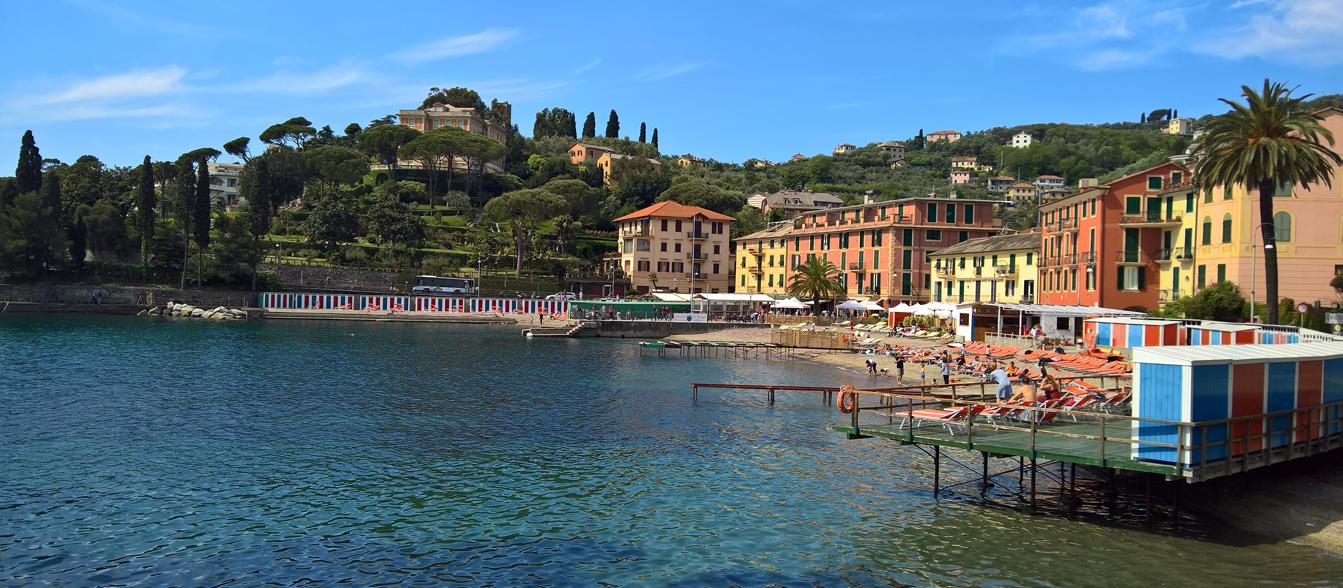
lie preserved along sections of the Ligurian coast. With little more than twenty-five kilometres left to cover, we arrived at hotel Miramare, our base in Sestri Levante, just after two in the afternoon. Located along the seafront, Hotel Miramare offers all the comforts and amenities expected from any modern European hotel. The resort includes beautiful indoor and outdoor gardens, an array of terraces at diverse levels of the hotel with gorgeous views overlooking the sea, a classy wine bar, spacious reading room and library, cinema, conference halls, and a reserved restricted beach.
Our self-driven journey through Italy had by this point entered into its third week. In this time, we had made stop overs at Verona, Venice, Rome, Florence,
Aurelia, llamada así por el cónsul romano Marco Aurelio Cotta. La Vía Aurelia fue una importante calzada romana construida en el siglo III a.C. durante la época de la República Romana. La SS1 a Sestri Levante discurre por el mismo camino que la antigua calzada romana, de la que se conservan restos a lo largo de tramos de la costa de Liguria.
Con poco más de veinticinco kilómetros por recorrer, llegamos al hotel Miramare, nuestra base en Sestri Levante, poco después de las dos de la tarde. Situado frente al mar, el hotel Miramare ofrece todas las comodidades y servicios que se esperan de cualquier hotel europeo moderno. El complejo incluye hermosos jardines interiores y exteriores, una serie de terrazas en diversos niveles del hotel con precio-
Vinci, Pisa, and the Cinque Terre National Park. Covering well in excess of one thousand two hundred kilometres since we took off from Milan’s Malpensa airport, our starting point, fatigue was making its presence felt.
In order to recharge our proverbial batteries, the plan at this specific juncture was to spend a couple of restful nights in Sestri Levante, a beautiful corner of the Italian Riviera, halfway between Genoa and Cinque Terre. As things stood, rest and relaxation were crucial prior to the completion of our road trip which would take us to the historic port city of Genoa, on our penultimate leg, and finally to the vibrant city of Milan, fashion capital which offers a blend of modern sophistication and rich historical heritage.
sas vistas al mar, un elegante bar de vinos, una amplia sala de lectura y biblioteca, cine, salas de conferencias y una playa reservada de acceso restringido.
Nuestro viaje por Italia había entrado en su tercera semana. En este tiempo, habíamos hecho escala en Verona, Venecia, Roma, Florencia, Vinci, Pisa y el Parque Nacional de Cinque Terre. Tras recorrer más de mil doscientos kilómetros desde que despegamos del aeropuerto de Malpensa, en Milán, nuestro punto de partida, el cansancio se hacía sentir.
Para recargar las pilas, el plan era pasar un par de noches en Sestri Levante, un bello rincón de la Riviera italiana a medio camino entre Génova y Cinque Terre. Tal y como estaban las cosas, el descanso y la relajación eran cruciales antes de completar nues-
Approximately forty kilometres south-east of Genoa, Sestri Levante originated as an ancient maritime and merchant centre. Known as the town of the two seas, Sestri Levante is a charming municipality of the Italian Riviera well known for its historic centre and beautiful beaches. Locals often use the expression Sestri è scialla, referring to the quiet nature of the town, known for its stunning views. Upstaged in a touristic sense by neighbouring Porto Fino and Cinque Terre, Sestri Levante has become a popular summer destination for Italians. The well-known Baia del Silenzio (Bay of Silence) and Baia delle Favole (Bay of Fairytales) are considered among the town’s most popular.
Baia del Silenzio (also known as Portobello) is located east of the isthmus that connects the village of Sestri Levante and the modern area of the town. One of the most attractive and romantic beaches in the region of Liguria, Baia del Silenzio so named because of its quiet and tranquil character, is a public beach frequented by locals, known as sestrini or sestriotti Enclosed within craggy cliffs, its calm waters shape a peaceful and secluded natural environment. Albeit in recent years this beach has become exceedingly popular with tourists mostly of a senior generation looking for peace and quiet. The growing numbers of foreign visitors is having a negative impact, making this once placid beach overcrowded, busy and noisy. The positive is that the town’s economy is reaping the benefits.
A curious feature of Baia del Silenzio is Il Pescatore, a bronze statue by Leonardo Lustig. Appropriately placed on a rocky area above sea level, the sculpture adds a touch of artistic class which compliments the natural aesthetics of this scenic bay. Typical Lustig, who’s work explores themes of human figures and their relationship with nature, the piece depicts a naked angler, kneeling on a rock casting a net into the sea. This magnificent statue pays tribute to the town’s rich fishing heritage that stretches back centuries. With easy access at low tide, I felt obliged to brave the slippery rocks in order to approach the effigy and admire it at close quarters. As a lover of art in all its facets, the experience was both moving and thoroughly captivating!
Baia delle Favole, is another of those picturesque beaches and seafront promenade areas the town has
tro viaje por carretera, que nos llevaría a la histórica ciudad portuaria de Génova, en nuestra penúltima etapa, y finalmente a la vibrante ciudad de Milán, capital de la moda que ofrece una mezcla de sofisticación moderna y rico patrimonio histórico. A unos cuarenta kilómetros al sureste de Génova, Sestri Levante tiene su origen en un antiguo centro marítimo y mercantil. Conocida como la ciudad de los dos mares, Sestri Levante es un encantador municipio de la Riviera italiana muy conocido por su centro histórico y sus hermosas playas. Los lugareños suelen utilizar la expresión Sestri è scialla, para referirse al carácter tranquilo de la localidad, conocida por sus impresionantes vistas. Superada en sentido turístico por las vecinas Porto Fino y Cinque Terre, Sestri Levante se ha convertido en un popular destino veraniego para los italianos. La conocida Baia del Silenzio (Bahía del Silencio) y la Baia delle Favole (Bahía de los Cuentos) están consideradas entre las más populares de la ciudad.
La Baia del Silenzio (también conocida como Portobello) se encuentra al este del istmo que une el pueblo de Sestri Levante y la zona moderna de la ciudad. Una de las playas más atractivas y románticas de la región de Liguria, Baia del Silenzio llamada así por su carácter tranquilo y apacible, es una playa pública frecuentada por los lugareños, conocidos como sestrini o sestriotti. Encerrada entre escarpados acantilados, sus tranquilas aguas conforman un entorno natural apacible y recogido. Aunque en los últimos años esta playa se ha hecho muy popular entre los turistas, en su mayoría de la tercera edad que buscan paz y tranquilidad. El creciente número de visitantes extranjeros está teniendo un impacto negativo, haciendo que esta playa antaño plácida esté abarrotada, concurrida y ruidosa. Lo positivo es que la economía de la ciudad se está beneficiando. Un elemento curioso de Baia del Silenzio es Il Pescatore, una estatua de bronce de Leonardo Lustig. Apropiadamente colocada en una zona rocosa sobre el nivel del mar, la escultura añade un toque de clase artística que complementa la estética natural de esta pintoresca bahía. Típica de Lustig, cuya obra explora temas de figuras humanas y su relación con la naturaleza, la pieza representa a un pescador desnudo, arrodillado sobre una roca echando una red al mar. Esta magnífica estatua rinde homenaje al rico
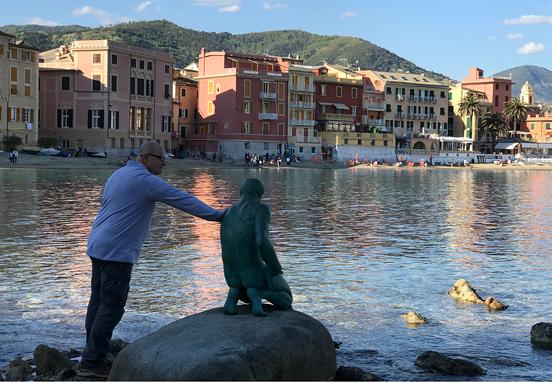
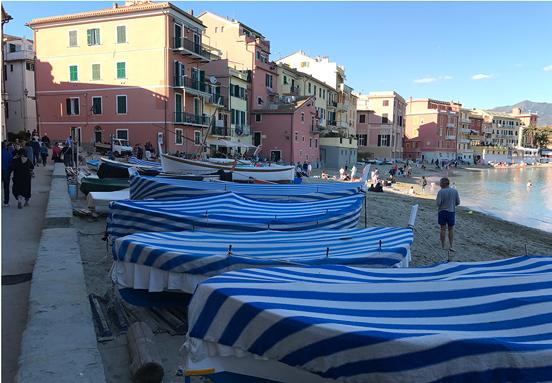
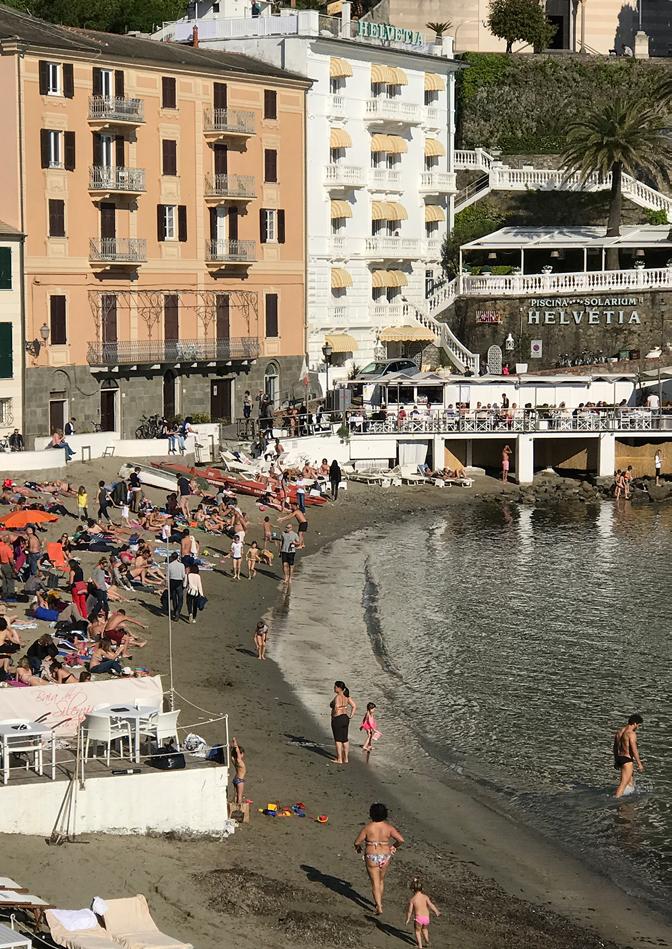
to offer. Associated with Hans Christian Andersen, Danish author who lived in the town for a brief time in 1833, this enchanting cove is characterized by its crescent shape and crystal-clear turquoise waters. According to local legend the bay’s natural beauty inspired Andersen, twenty-eight years old at the time, to write The Little Mermaid, a poetic fairy tale first published in 1837.
The fairy tale tells the story of a youthful mermaid named Ariel who yearned for a human soul. However, Triton the Sea King, her father, a powerful and authoritative figure, forbade her any association with the world above the ocean. In her quest to become human, Ariel was prepared to disobey Triton, and in doing so, give up her privileged life in the underwater kingdom. In the end, Ariel falls in love with Eric, a human prince. Moved by the couple’s enthusiastic love, Triton willingly transforms his beloved daughter from a mermaid into a human, and they both live happily ever after. The cartoon version of the Little Mermaid was released by Walt Disney Pictures in 1989. The human version of the film was released in May 2023.
Since 1967, Sestri Levante hosts an annual literary festival in honour of Hans Christian Andersen. Open to both professional as well as amateur authors, the prestigious and highly sought after Andersen Prize, culmination of the festival, is awarded to the best submission of children’s literature. The festival has become one of the longest-running and most famous literary competitions in Italy.
Adding cultural and educational interest to Baia delle Favole, is the sea-facing Palazzo Fascie Museum complex, a prominent building situated along the beachfront promenade. The museum highlights a range of interesting exhibits that span from prehistory to the contemporary age. Built in the 17th century, the building, one of the most significant landmarks in Sestri Levante, originally served as the private residence of the Fascie family who were promientt local figures.
The charming historic centre, a mere five-minute walk from our hotel, occupies an area of approximately one square kilometre. It’s narrow, winding streets lined with colourful buildings adorned with vibrant flower boxes, include a diverse selection of shops, boutiques, and local artisan stores, offering all manner of traditional products and souvenirs.
patrimonio pesquero de la ciudad, que se remonta a siglos atrás. De fácil acceso con la marea baja, me sentí obligado a desafiar las resbaladizas rocas para acercarme a la efigie y admirarla de cerca. Como amante del arte en todas sus facetas, la experiencia fue conmovedora y cautivadora.
Baia delle Favole, es otra de las pintorescas playas y zonas del paseo marítimo que ofrece la ciudad. Asociada con Hans Christian Andersen, autor danés que vivió en la ciudad durante un breve periodo en 1833, esta encantadora cala se caracteriza por su forma de media luna y sus aguas cristalinas de color turquesa. Según la leyenda local, la belleza natural de la bahía inspiró a Andersen, que entonces tenía veintiocho años, a escribir La Sirenita, un poético cuento de hadas publicado por primera vez en 1837. El cuento narra la historia de una joven sirena llamada Ariel que ansiaba un alma humana. Sin embargo, Tritón, el Rey del Mar, su padre, una figura poderosa y autoritaria, le prohibió cualquier relación con el mundo de encima del océano. En su afán por convertirse en humana, Ariel estaba dispuesta a desobedecer a Tritón y, al hacerlo, renunciar a su vida privilegiada en el reino submarino. Al final, Ariel se enamora de Eric, un príncipe humano. Conmovido por el amor entusiasta de la pareja, Tritón transforma voluntariamente a su amada hija de sirena en humana, y ambos viven felices para siempre. La versión de dibujos animados de La Sirenita fue estrenada por Walt Disney Pictures en 1989. La versión humana se estrenó en mayo de 2023.
Desde 1967, Sestri Levante acoge un festival literario anual en honor de Hans Christian Andersen. Abierto tanto a autores profesionales como aficionados, el prestigioso y codiciado Premio Andersen, colofón del festival, se concede a la mejor obra de literatura infantil. El festival se ha convertido en uno de los certámenes literarios más antiguos y famosos de Italia. El complejo museístico Palazzo Fascie, situado en el paseo marítimo, añade interés cultural y educativo a la Baia delle Favole. El museo presenta una serie de interesantes exposiciones que abarcan desde la prehistoria hasta la época contemporánea. Construido en el siglo XVII, el edificio, uno de los hitos más significativos de Sestri Levante, sirvió originalmente como residencia privada de la familia Fascie, quienes fueron prominentes figuras locales.
There are also an interesting variety of grocery store, bakeries, pastry shops that have kept the traditional production and flavours of the past. Most of these family run businesses have very often been maintained exactly as they were half a century ago.
Catering for all pockets, the town centre is full of restaurants that offer classic Ligurian cuisine, which pay tribute to the town's fishing heritage reflected in its culinary traditions. Strolling along the attractive little streets of town centre, we were drawn by the mouthwatering aroma of food that permeated the air. Approaching lunchtime we entered a traditional family-run eatery known as a Trattoria. Warm and inviting the establishment offered a wide range of homemade food. Without hesitation we ordered trofie al pesto (a local pasta dish with basil sauce) and frittura mista (mixed fried seafood), considered the town’s most popular dishes. To accompany the food, the friendly waiter recommended the Cinque Terre DOC white wine known for its fresh, crisp character. He explained that this wine, served very cold would pair well with the food we had ordered. The quality of the food and service were outstanding. Considering our meal consisted of a variety of freshly caught seafood and an excellent quality white wine, the price was very reasonable. I would not hesitate to recommend a traditional Trattoria to anyone visiting Italy, as these family-run establishments offer an authentic culinary experience, which highlights the true flavours of traditional Italian cuisine. With a full stomach we followed the hiking path leading from the old town to Punta Manara, a scenic promontory that extends into the Ligurian Sea. From this vantage point it is possible to enjoy the magnificent panorama and admire the stunning coastline that extends from Levanto to Portofino
We spent what remained of the afternoon unwinding on our hotel’s private beach. Before dinner that evening, we visited the Church of San Nicolo of the island and the Gualino Castle, which has an interesting history. In 1145, the Commune of Genoa came into joint possession of the fief (landholding or estate) of Sestri Levante which originally belonged to the influential Fieschi family, and the Benedictine monks of San Fruttoso di Capodimonte, who’s monastery was based in the town of Camogli, near Genoa. In the middle of the 12th century, the Genoese
El encantador centro histórico, a sólo cinco minutos a pie de nuestro hotel, ocupa una superficie aproximada de un kilómetro cuadrado. Sus calles estrechas y sinuosas, bordeadas de coloridos edificios adornados con vibrantes jardineras, incluyen una variada selección de tiendas, boutiques y tiendas de artesanía local, que ofrecen todo tipo de productos tradicionales y recuerdos. También hay una interesante variedad de tiendas de ultramarinos, panaderías y pastelerías que han conservado la producción y los sabores tradicionales de antaño. La mayoría de estos negocios familiares se han mantenido en muchos casos tal y como eran hace medio siglo. Para todos los bolsillos, el centro de la ciudad está repleto de restaurantes de cocina clásica de Liguria, que rinden homenaje a la herencia pesquera de la ciudad reflejada en sus tradiciones culinarias. Paseando por las atractivas callejuelas del centro de la ciudad, nos sentimos atraídos por el apetitoso aroma a comida que impregnaba el aire. Cuando se acercaba la hora de comer, entramos en una trattoria familiar tradicional. Cálido y acogedor, el establecimiento ofrecía una amplia variedad de comida casera. Sin dudarlo pedimos trofie al pesto (un plato local de pasta con salsa de albahaca) y frittura mista (mezcla de marisco frito), considerados los platos más populares de la ciudad. Para acompañar la comida, el amable camarero nos recomendó el vino blanco Cinque Terre DOC, conocido por su carácter fresco y crujiente. Nos explicó que este vino, servido muy frío, combinaría bien con la comida que habíamos pedido. La calidad de la comida y el servicio fueron excepcionales. Teniendo en cuenta que nuestra comida consistía en una variedad de mariscos recién pescados y un vino blanco de excelente calidad, el precio fue muy razonable. No dudaría en recomendar una trattoria tradicional a cualquiera que visite Italia, ya que estos establecimientos familiares ofrecen una experiencia culinaria auténtica, que resalta los verdaderos sabores de la cocina tradicional italiana. Con el estómago lleno, seguimos el sendero que lleva desde el casco antiguo hasta Punta Manara, un pintoresco promontorio que se adentra en el mar de Liguria. Desde este mirador es posible disfrutar del magnífico panorama y admirar la impresionante costa que se extiende desde Levanto hasta Portofino. Pasamos el resto de la tarde descansando en la


initiated construction of a fortification complex, and a church dedicated to San Nicolo. The development was completed around 1151. In 1432, a naval incursion by the Venetians inflicted considerable damage to the fortress and church. A few years later architect Leone da Bissone, appointed by the Genoese, reconstructed the entire complex. In 1810, the fortification was transformed into a cemetery, and remained so until 1925, when the industrialist Ricardo Gualino bought the area and built three new constructions on the site. In 1950, the entire complex was turned into the elegant four-star Hotel dei Castelli.
Our stay in Sestri Levante had ended. We had accomplished what we set out to do, enjoy a couple of restful beach days in this quiet holiday resort prior to the next and penultimate leg of our journey that would take us to the port city of Genoa, capital of northwest Italy's Liguria region.
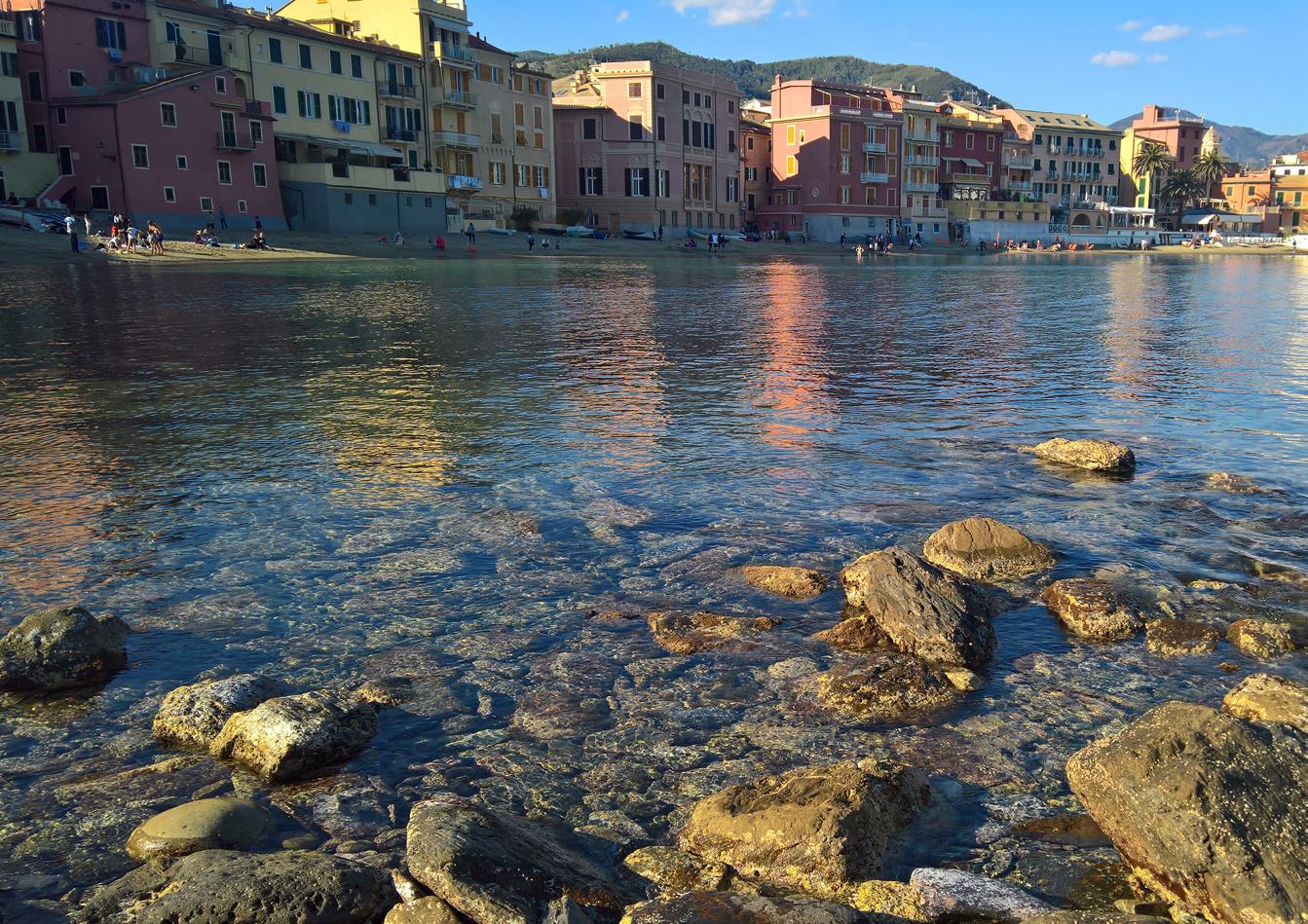
playa privada de nuestro hotel. Antes de cenar esa noche, visitamos la iglesia de San Nicolo de la isla y el castillo de Gualino, que tiene una interesante historia. En 1145, la Comuna de Génova entró en posesión conjunta del feudo de Sestri Levante, que originalmente pertenecía a la influyente familia Fieschi y a los monjes benedictinos de San Fruttoso di Capodimonte, cuyo monasterio tenía su sede en la ciudad de Camogli, cerca de Génova. A mediados del siglo XII, los genoveses iniciaron la construcción de un complejo de fortificaciones y una iglesia dedicada a San Nicolo. La obra se completó hacia 1151. En 1432, una incursión naval de los venecianos infligió daños considerables a la fortaleza y la iglesia. Pocos
años después, el arquitecto Leone da Bissone, nombrado por los genoveses, reconstruyó todo el complejo. En 1810, la fortificación se transformó en cementerio, y así permaneció hasta 1925, cuando el industrial Ricardo Gualino compró la zona y construyó tres nuevas edificaciones en el lugar. En 1950, todo el complejo se convirtió en el elegante Hotel dei Castelli, de cuatro estrellas. Nuestra estancia en Sestri Levante había terminado. Habíamos cumplido lo que nos habíamos propuesto: disfrutar de un par de días de playa en este tranquilo lugar de vacaciones antes de la siguiente y penúltima etapa de nuestro viaje, que nos llevaría a la ciudad portuaria de Génova, capital de la región de Liguria, en el noroeste de Italia.
Any event, from initial ideas, to production, assembly or press clipping - we are there.
Innovation in PR
Sometimes the events are confused as strategies when in fact they are a means of very high value for the identification, recognition or presentation of a brand, a product or a project.
Associating positive and group experiences with the communicative arguments of the company is a fast and effective way to satisfy users.
Emotional connectivity
We get connections between target audiences, commercial and social agents of relevance to grant notoriety to the company. What better way to know and interact, to get the data of true interest, their opinions, their desires and their loyalty?
The union makes the party
We have a team capable of not only designing, planning and organizing any type of event, but we also have specialized professionals in all areas:
conceptualization, financial analysis, communication strategies, manufacturing and assembly, public relations, chronograms, monitoring of results, and more.

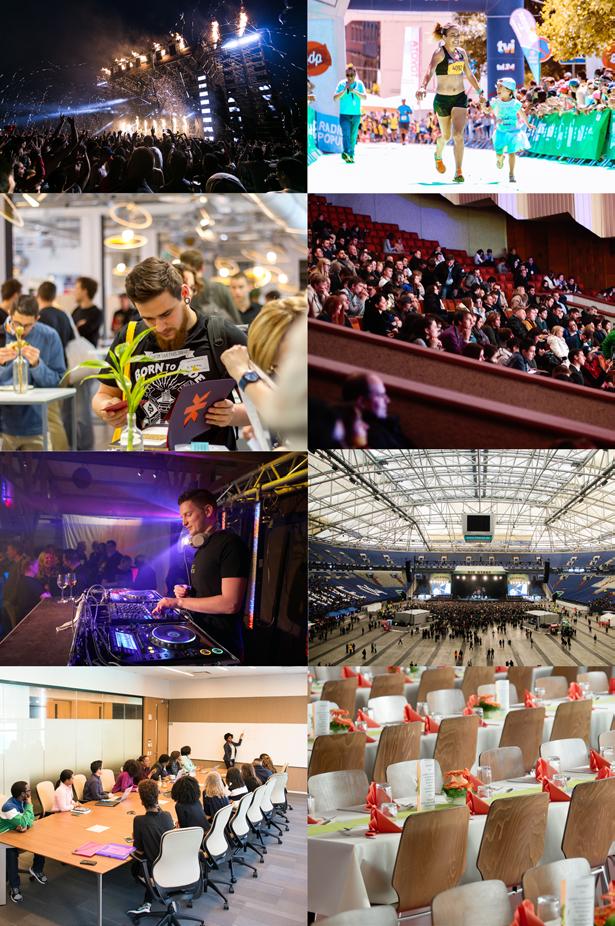


Somos capaces de organizar cualquier tipo de eventos, desde las ideas iniciales, hasta la producción, el montaje o el cloipping de prensa.
Innovación en las RRPP
A veces se confunde los eventos como estrategias cuando en realidad son un medio de altísimo valor para la identificación, reconocimiento o presentación de una marca, un producto o un proyecto. Asociar experiencias positivas y grupales con los argumentos comunicativos de la empresa es una manera rápida y efectiva de satisfacer a los usuarios.
Conectividad emocional
Conseguimos conexiones entre públicos objetivos, agentes comerciales y sociales de relevancia para otorgar notoriedad a la compañía. ¿Qué mejor manera de conocer e interactuar, de conseguir los datos de verdadero interés, sus opiniones, sus deseos y su fidelidad?.
La unión hace la fiesta
Contamos con un equipo capaz no solo de diseñar, planificar y organizar cualquier tipo de eventos, sino que también disponemos de profesionales especializados en todas las áreas: conceptualización, análisis financiero, estrategias de comunicación, fabricación y montaje, relaciones públicas, cronogramas, seguimientos de los resultados y mucho más www.communications.com
VOLUME 3 / VOLUMEN 3
El santuario de Lalla Mrika
Juanlu González
Article and images
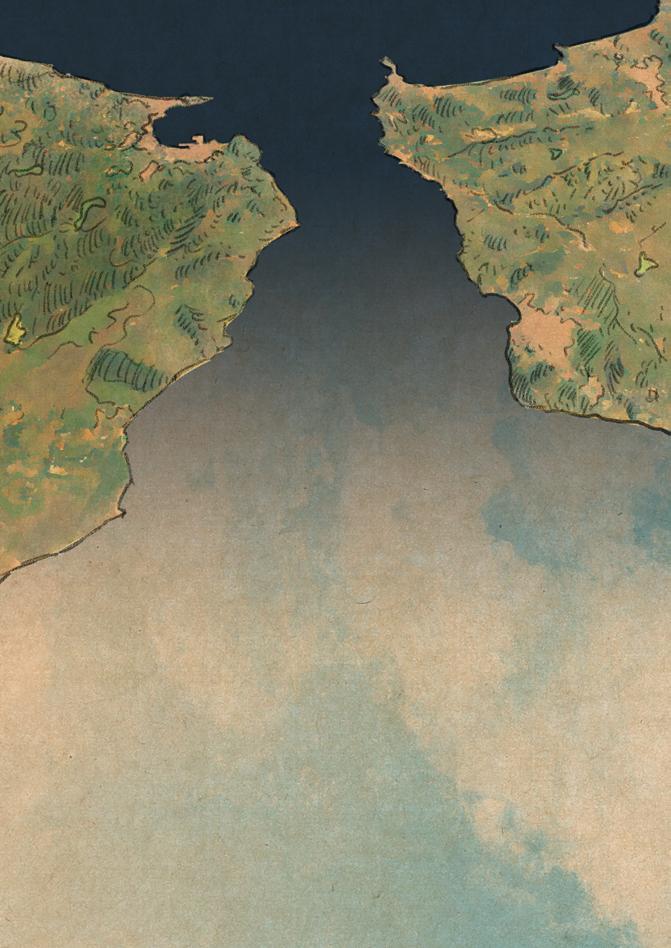
I was told years ago by members of the berber tribe of the Bocoia that Malek was a traveler from other lands who entered the Al Hoceima region in search of a new destination to settle and try his luck in life. In spite of being poor, he was a cultivated, eloquent person and, those who knew him, considered him intelligent and fair. He was tall and slender, with a good beard on his face, which gave him a certain nobility. Still middle-aged, he had the wisdom that came from having lived long enough, but still retained in his eyes an innate curiosity and a desire to improve the world around him.
One day, Malek went to the weekly souk. In addition to being able to shop, markets are meeting places, meeting, dealing and business areas. It is a good place to find work or simply to spend the day, meet people or find out the news and gossip from around the region. As he was tired and it was hot, he sat down under a tree near a butcher's stall. There, absorbed in his troubles and meditations, his attention was attracted by a hungry dog that prowled around the meat in case it fell some pitraco or offal as a gift. But as time was running out and hunger was pressing without him getting a bite to eat, the dog, in an oversight of the slaughterer, managed to take a bite of an open carcass hanging from a tree. Realizing what had happened, the butcher tied up the dog, took a stick and beat him to a pulp.
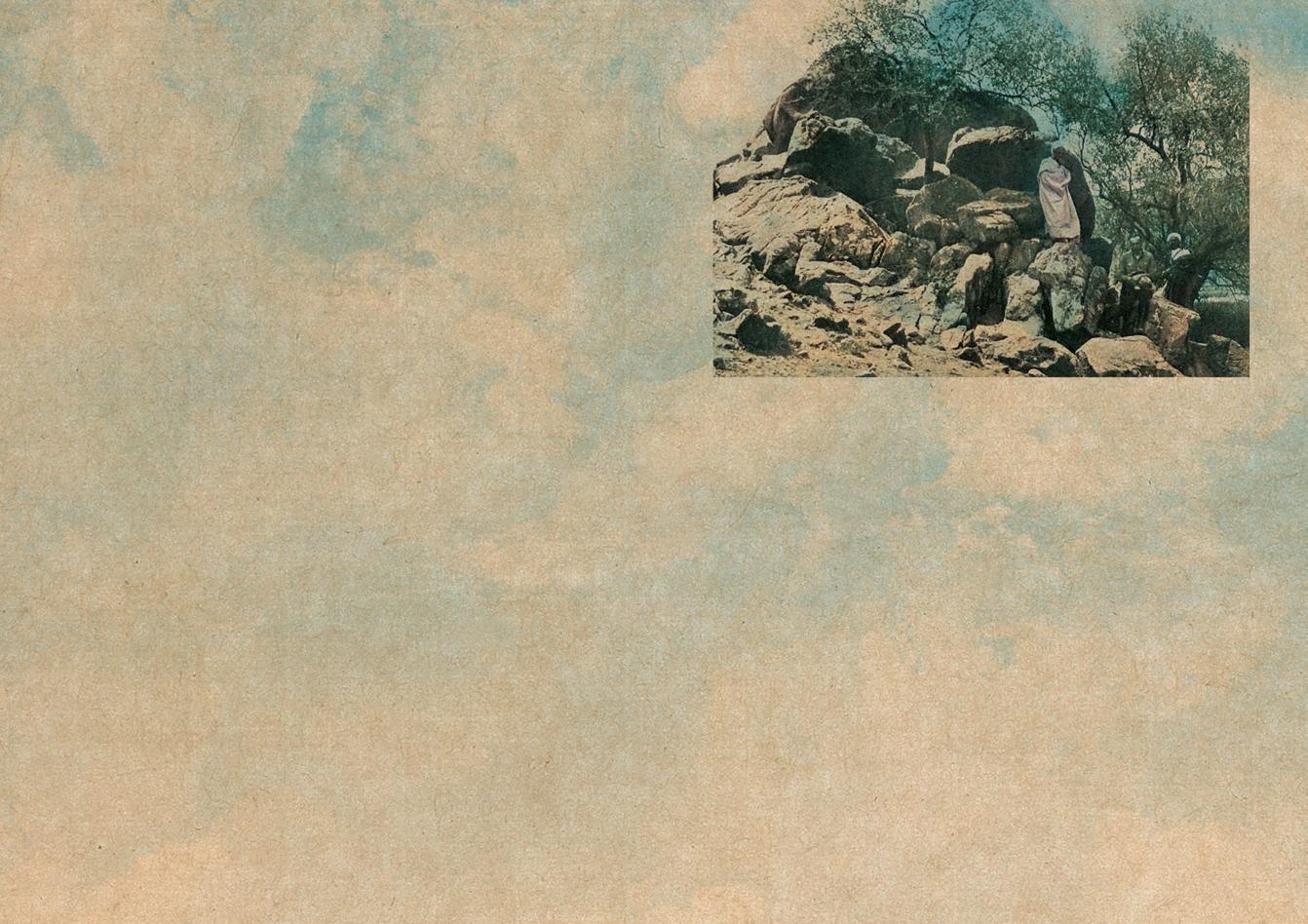
Me contaron años atrás miembros de la tribu beréber de los Bocoia que Malek era un viajero de otras tierras que se adentró en la región de Alhucemas para buscar un nuevo destino en el que asentarse y probar suerte en la vida. A pesar de ser pobre, era una persona cultivada, elocuente y, quienes lo conocían, lo tenían por inteligente y justo. De cuerpo alto y delgado, una buena barba poblaba su rostro y le proporcionaba cierta nobleza. Aún de mediana edad, tenía la sabiduría que le aportaba el haber vivido lo suficiente, pero conservando aún en su mirada una innata curiosidad y las ganas de mejorar el mundo que le rodeaba.
Un día, Malek acudió al zoco semanal. Además de poder comprar, los mercados son zonas de reunión, de encuentro, de tratos y negocios. Es un buen sitio para encontrar trabajo o simplemente, para pasar el día, conocer gente o enterarse de las noticias y los cotilleos de toda la región. Como estaba cansado y hacía calor, se sentó bajo un árbol cerca de un puesto de carnicero. Allí, absorto en sus cuitas y meditaciones, le llamó la atención un perro hambriento que merodeaba alrededor de la carne por si le caía algún pitraco o despojo de regalo. Pero como el tiempo corría y el hambre apretaba sin que alcanzase a probar bocado alguno, el can, en un descuido del matarife, logró dar un bocado a
Malek, hearing the whimpering of the animal, woke up from his lethargy and rebuked the butcher:
—That's enough, you're going to kill him, it wasn't that bad either.
To which the butcher, visibly angry, replied:
—If these well-deserved whippings bother you so much, I offer you a deal. If you pay me for the damage the dog has caused me, I will stop beating him and let him go.
Our traveler took out the few coins he had to buy some food for himself and handed them over to the madman, who complied with the agreement and released the poor animal. The latter, before disappearing in a hurry, had time to look Malek in the eyes and lick his hand as a sign of gratitude.
When the souk was dismantled, our traveler, now rested, although hungry, continued walking until he stopped at a beautiful water source, located next to some solitary sandstone rocks surrounded by wild olive trees. There he was approached by a young man who told him a strange story. He told him that he was in fact a yin, a genie, who had decided to go to the market for a walk transformed into a dog. When he returned home, he told his mother what had happened and she expressed her desire to thank the stranger as he certainly deserved. So, she had gone out to fetch him to accompany him to a city in the world of the genies, of which Mrika was its queen. Malek did not believe his ears, but there was nothing to be lost by accompanying him. In any case, he needed lodging for the night and some food to satisfy his hunger.
They both descended through a sort of hollow between mastic trees until a huge city opened before them, full of sumptuous buildings, palaces, gardens, fountains. On the way to the royal mansion, the yin commented to Malek:
—As you see, my mother is a very powerful woman and she wants to reward you for what you have done for me today. She is going to offer you to choose whatever you wish from among her treasures. But do not let yourself be dazzled by gold, jewels or precious stones. You should only ask him for the gold ring he wears on his hand, that is the source of his power and his most precious possession. It is what you deserve for your kindness and your help.
When they arrived at the palace, Mrika, that was
una res abierta en canal que colgaba de un árbol. Al darse cuenta de lo sucedido, el carnicero ató al perro, tomó una vara y se ensañó a golpes con él. Malek, oyendo los quejidos del animal, despertó de su letargo e increpó al carnicero: —Ya es suficiente, lo vas a matar, tampoco ha sido para tanto.
A lo que el carnicero, visiblemente enfadado respondió:
—Si tanto te molestan estos merecidos azotes, te ofrezco un trato. Si me pagas el daño que me ha causado el perro, dejaré de pegarle y lo soltaré. Nuestro viajero sacó las pocas monedas que tenía para comprar algo de comida para sí y se las entregó al energúmeno, que cumplió con lo pactado y liberó al pobre animal. Éste, antes de desaparecer a toda prisa, tuvo tiempo de mirar a Malek a los ojos y lamerle la mano en señal de agradecimiento.
Cuando se desmontó el zoco, Malek, ya descansado, aunque hambriento, siguió caminando hasta detenerse en un hermoso nacimiento de agua, situado junto a unas rocas solitarias de arenisca rodeadas de acebuches. Allí se le acercó un joven que le contó una extraña historia. Le dijo que él era en realidad un yin, un genio, que había decidido ir al mercado a dar una vuelta transformado en perro. Al volver a su casa, le contó a su madre lo sucedido con el matarife y ésta le manifestó su deseo de agradecérselo al forastero como sin duda merecía. Así que había salido a buscarlo para que lo acompañase hasta una ciudad en el mundo de de los genios, su madre Mrika era la reina. Malek no daba crédito a sus oídos, pero no perdía nada con acompañarlo. De todas formas, necesitaba un alojamiento para pasar la noche y algo de comida para saciar su hambre.
Ambos bajaron por una especie de hueco entre lentiscos hasta que se abrió ante ellos una enorme ciudad, llena de edificios suntuosos, de palacios, de jardines, de fuentes. De camino a la mansión real, el yin le comentó a Malek: —Como ves, mi madre es una mujer muy poderosa y quiere recompensarte por lo que has hecho hoy por mi. Te va a ofrecer para que elijas cualquier cosa que desees de entre sus tesoros. Pero no te dejes obnubilar por el oro, las joyas o las piedras preciosas. Sólo debes pedirle el anillo de oro que



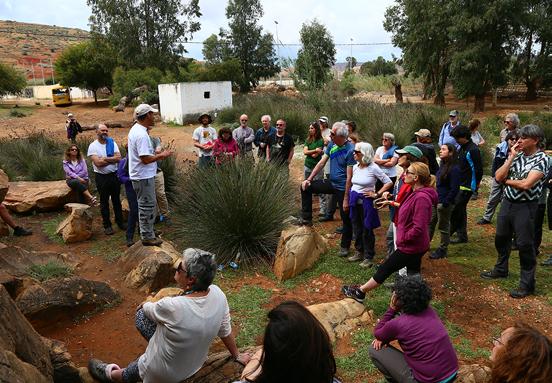
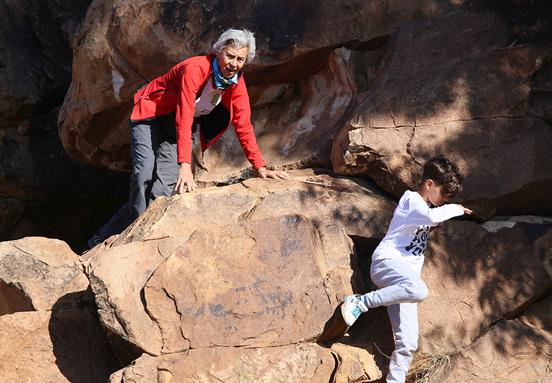
the name of the queen of the genies, presented herself to him, kissed his hand and said:
-Welcome to this city of the kingdom of the Yenun of which I am its sovereign. Unselfishly, without knowing it, you have protected my son from the blows of that accursed butcher even at the cost of your own well-being. Ask me for whatever you wish of what I have.
Malik, fleeting his gaze to the prince, stammered and said:
—I would only like you to give me your ring -he answered shyly looking at the ground.
—It is yours, from now on, you will have all the power at your disposal," Mrika said, disgruntled but bound by her promise.
Suddenly, Malek saw the covers of a book peeking out from between several cushions on the couch where the queen was resting, which caught his attention.
—I would like to take that book too," said Malek.
—That book of knowledge. It is already yours but, for your own good, I am not going to give it to you in its entirety. Total wisdom will bring you a lot of unhappiness," replied Mrika, tearing the book in half and continued, "You will have the power and the wisdom. I will only give you one condition, neither one nor the other you will be able to use them for your own benefit, only to do good to others. But you must know that if you accept, you will never see your own people again, you will consecrate your existence to improve the lives of others, do you accept?
—Of course, it is what I have always longed for," replied Malek.
Suddenly, the city of the yenum vanished and once again both men saw each other by the rocks and the fountain where they had previously met. The prince said, pointing to a nearby hill:
—In that marabout you will receive the men and women who need your services. They will come to be cured of the evil eye, women who cannot have children, those who have been deprived of their health, epileptics, those who have been subjugated by demons, those whose understanding has been clouded by magical arts. All will find comfort and healing through the gifts you have just received. —I don't see any marabouts," said Malek, looking at the hill. At that very moment, a building appeared
lleva en la mano, esa es la fuente de su poder y su bien más preciado. Es lo que mereces por tu bondad y tu ayuda.
Cuando llegaron a palacio, Mrika, que así se llamaba la reina de los genios, se presentó ante él, le besó la mano y le dijo:
—Bienvenido a esta ciudad del reino de los yenún de la que soy su soberana. Desinteresadamente, sin saberlo, has protegido a mi hijo de los golpes de ese maldito carnicero aún a costa de tu propio bienestar. Pídeme lo que desees de cuanto tengo.
Malik, dirigió fugazmente su mirada al príncipe, balbuceó y dijo:
—Únicamente me gustaría que me dieses tu anillo —respondió tímidamente mirando al suelo.
—Es tuyo, a partir de ahora, dispondrás de todo el poder—le espetó Mrika, contrariada pero atada a su promesa.
De pronto, Malek vio las tapas de un libro asomando entre varios cojines del diván en el que reposaba la reina que le llamó mucho la atención.
—Me gustaría también llevarme ese libro — dijo Malek.
—Ese el libro del conocimiento. Ya es tuyo pero, por tu propio bien, no voy a dártelo completo. La sabiduría total te va a producir mucha infelicidad —respondió Mrika partiendo el libro por la mitad y continuó diciéndole— vas a tener el poder y la sabiduría. Solo te pondré una condición, ni lo uno ni la otra podrás usarlas en beneficio propio, únicamente para hacer el bien al prójimo. Pero debes saber que si aceptas, jamás volverás a ver a los tuyos, consagrarás tu existencia a mejorar la vida de los demás ¿aceptas?
—Por supuesto, es lo que siempre he anhelado —respondió Malek.
De pronto, la ciudad de los yenún se desvaneció y de nuevo ambos se vieron junto a las peñas y la fuente donde previamente se habían encontrado. El príncipe le dijo, señalando a un cerro próximo:
—En esa zawiya recibirás a los hombres y las mujeres que necesiten de tus servicios. Vendrán a curarse del mal de ojo, acudirán mujeres que no puedan tener descendencia, también aquellos a los que les han quitado la salud, los epilépticos, los que han sido subyugados por los demonios, a

out of nowhere, all white and gleaming, as if freshly whitewashed.
—There you have your house from now on. Your name from today will be Sidi Malek. The rocks and the fountain where we stand have also been blessed forever. They will be visited by pilgrims from all over, attracted by their healing power," were the yin's last words before vanishing completely and forever from the sight of the one who would eventually become a great saint revered throughout the region, especially by the Bocoia tribe.
It was precisely there, in the shadow of those same magical crags, where I was told the story when I heard it for the first time. The most curious thing is that in the Peñas de los Yenun, which is how it is known locally, it is not uncommon to find small groups of people who come to fulfill a prearranged ritual seeking to improve their health or luck. First, they leave pieces of bread at Lalla Mrika, specifically in a nearby pond, which will serve, in the end, to feed the turtles and blessed fish that inhabit it. Then you have to turn the stone three times in a row and, finally, leave some coins to the guardians of the devils' rock, the couple who live in the place and who take care of it with zeal. He is completely blind; she has vision in only one eye. Both, guardians of the invisible, keep Mrika's flame alive, proudly telling her story whenever someone curious enough to want to hear it arrives.
What is really interesting is the strong attraction the place has among the inhabitants of the region, stronger even than the nearby marabout. And considering that this is the area inhabited by the Yenun, it is truly unique. By all accounts, it seems that Mrika really is the saint.
Perhaps that is why the shrine was recently attacked by Sunni Islamic fundamentalists. One night, a group of bearded men climbed the rocks with iron crowbars and managed to pull down a small rock that formed a kind of narrow passageway through which one had to pass to turn the rock completely around. Obviously, they could do little more; it would take many kilos of explosives to blow up the whole thing. But their intention was to put an end to a cult they consider pagan, as they have already done with numerous marabouts in the Rif, popular expressions of Sufism, which they have destroyed, vandalized or
los que les han nublado el entendimiento con artes mágicas. Todos hallarán consuelo y curación gracias a los dones que acabas de recibir.
—No la veo—dijo Malek mirando a la loma. En ese mismo momento, un edificio surgió de la nada, todo blanco y resplandeciente, como recién encalado.
—Ahí tienes tu casa a partir de ahora. Tu nombre desde hoy será Sidi Malek. Las rocas y la fuente en la que nos encontramos también han sido bendecidas para siempre. Serán visitadas por peregrinos de todas partes atraídos por su poder sanador —fueron las últimas palabras del yin antes de desvanecerse por completo y para siempre a la vista de quien sería, a la postre, un gran santo venerado en toda la región, especialmente por la tribu de los Bocoia.
Fue justamente ahí, a la sombra de esas mismas peñas mágicas, donde acabaron de contarme el relato cuando lo oí por primera vez. Lo más curioso es que en las Peñas de los Yenún, que es como se le conoce localmente, no es raro encontrarnos con pequeños grupos de personas que vienen a cumplir con un ritual prefijado buscando mejorar su salud o su suerte. Primero dejan trozos de pan a Lalla Mrika, concretamente en una charca cercana, que servirán, a la postre, para alimentar a las tortugas y peces bendecidos que la habitan. Luego hay que darle tres vueltas seguidas a la piedra y, finalmente, dejar unas monedas a los guardianes de la roca de los diablos, la pareja que vive en el lugar y que lo cuida con celo. Él, completamente ciego, ella con visión en un solo ojo. Ambos, guardianes de lo invisible, mantienen viva la llama de Mrika, relatando orgullosos su historia cada vez que llega alguien con la suficiente curiosidad como para desear oírla. Lo que es realmente interesante es la atracción tan fuerte que tiene el lugar entre los habitantes de la región, más incluso que la que tiene el morabito cercano. Y teniendo en cuenta que se trata de la zona donde habitan los yenún, algo realmente singular. A todas luces, pareciera que Mrika fuese realmente la santa.
Quizás esa sea la razón por la cual el santuario fuese atacado recientemente por integristas islámicos sunitas. Una noche, un grupo de barbudos subieron a las piedras con palancas de hierro y lograron tirar una pequeña roca que conformaba
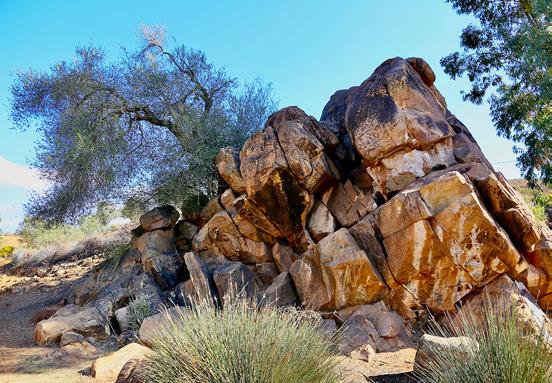
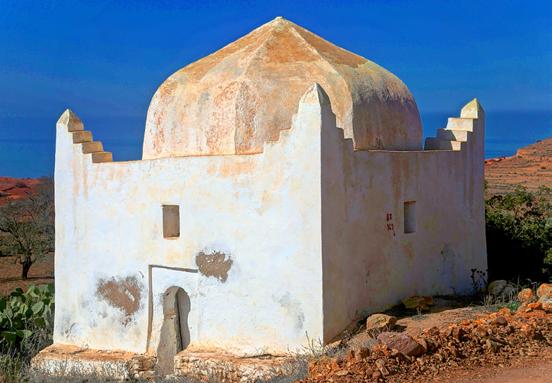
set on fire. In 2006, for example, they burned the Ceuta shrine of Sidi Bel Abbas, in the foothills of Mount Hacho.
On this occasion, however, it backfired. The damage inflicted was minimal and pilgrims continue to visit it as if nothing had happened. Nor did they count on the revenge of Lalla Mrika. On their way back from the attack to the neighborhood they sardonically call Kandahar, on the outskirts of the city of Al Hoceima, where many fundamentalists live, the vehicle was involved in an accident and all the occupants were seriously injured. That day they learned that, believe it or not, the Yenun are not to be trifled with…

una especie de pasillo estrecho por el que había que pasar para darle la vuelta completa al peñasco. Obviamente, poco más pudieron hacer, harían falta muchos kilos de explosivos para volar todo el conjunto. Pero su intención era acabar con un culto que consideran pagano, como ya han hecho con numerosos morabitos del Rif, expresiones populares del sufismo, a los que han destruido, vandalizado o prendido fuego. En 2006, por ejemplo, quemaron el santuario ceutí de Sidi Bel Abbas, en las estribaciones del Monte Hacho.
Sin embargo, en esta ocasión, les salió el tiro por la culata. Los daños infligidos fueron mínimos y los peregrinos siguen visitándolo como si nada. Tampoco contaban con la venganza de Lalla Mrika. Cuando volvían tras el atentado al barrio que apodan socarronamente Kandahar, en los alrededores de la ciudad de Alhucemas, donde habitan muchos fundamentalistas, el vehículo sufrió un accidente y todos sus ocupantes resultaron heridos de cierta consideración. Ese día aprendieron que, creas o no en ellos, con los yenún no se juega…
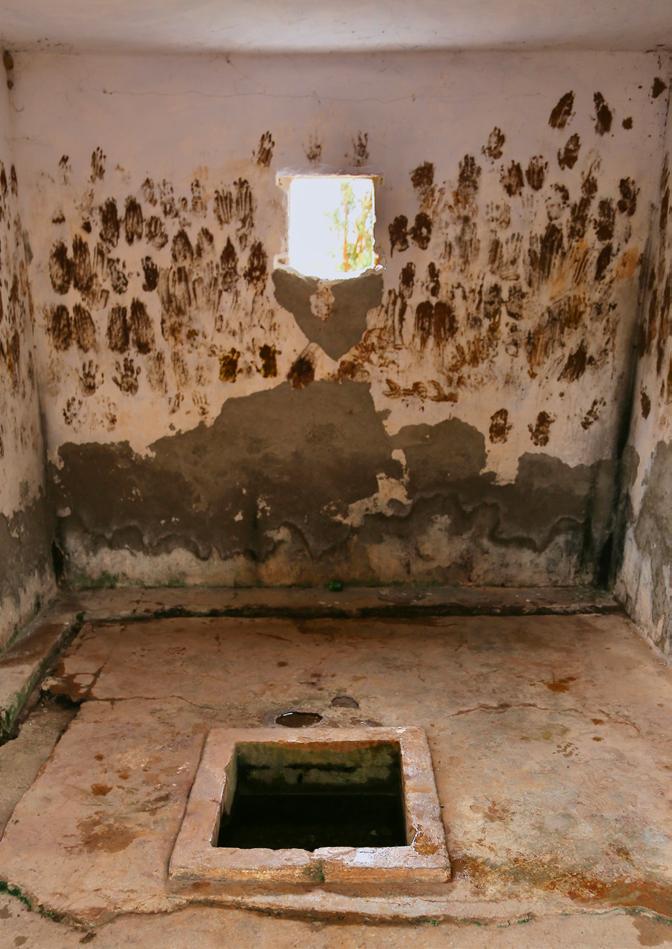
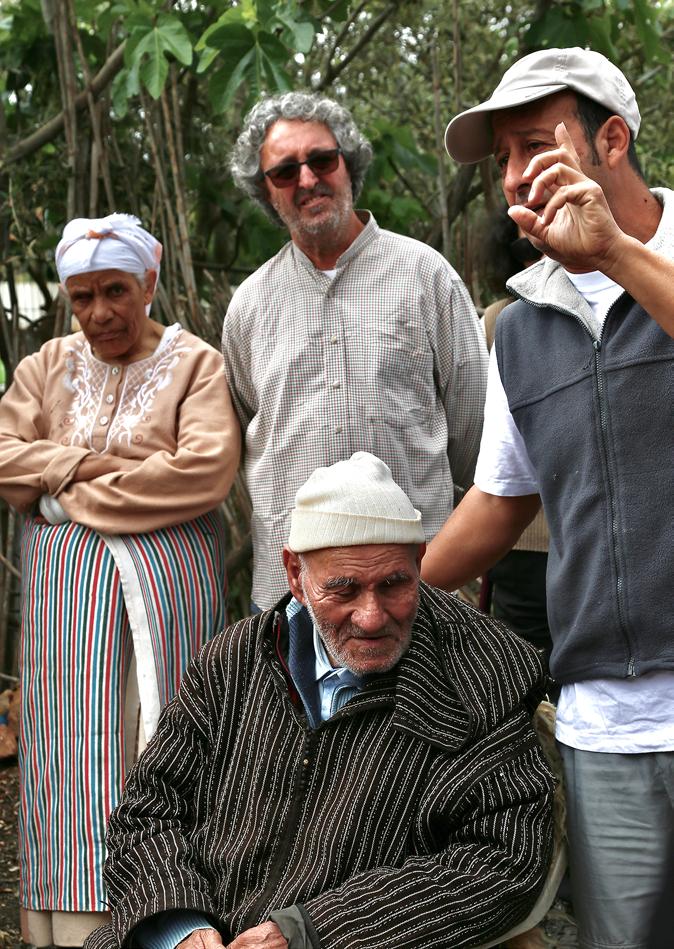

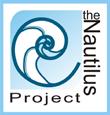
The Nautilus Project are really excited to announce that after the last four great successes, we will be hosting our 5th consecutive Gibraltar Sustainable Awards in collaboration with the GFSB.
The theme this year is One Planet, One Ocean, One Climate, One Future #Together with a view of showcasing the different ways in which the diverse representation of Gibraltar’s community is mitigating its plastic and carbon footprint and how the Climate Crisis is at the global forefront.
We are on the lookout for local businesses, organisations, charities and clubs that have implemented the highest number of green initiatives including minimising their carbon and plastic footprints. No sustainable transition is too small!
The following categories will apply:
• Flora and Fauna.
• Energy Conservation.
• Water Conservation.
• Waste Management.
• Environment.
• Pollution and Climate Change. Examples may include (but are not limited to):
• Awarded the most TNP certificates since accreditations began.
• Implementation of Energy Saving practices.
• Recycling within the workplace.
• Cutback on single use plastics.
• Plastic Free Events.
• Reduction in CO2 emissions.
• Sustainability within the workplace.
• Positive impact on Gibraltar’s coastline.
Power Point presentation entries are to be submitted to info@thenautilusproject.co by no later than Monday 18th September 2023 (end of the working day) Contact Melanie Soiza-Stagnetto for any further information on +350 54002262
Prizegiving ceremony is set for World Energy Efficiency Day observed on October 4th 2023.
Entries are to be sent via power point presentations to info@thenautilusproject.co on or before the above date.

Last month, we visited Khoo Teck Puat Hospital, though thankfully not as a patient! We came to understand how integrating nature into a hospital setting could reduce stress, the need for pain medications, and lead to a greater sense of community.
Hospitals are meant to put patients first, but with countries reducing their healthcare budgets, staff are overworked. You know how the old adage goes, one cannot pour from an empty cup. Today we look at research out of Italy on applying the benefits of nature-based design in hospitals and how that supports staff.
It should surprise no one that hospitals are expensive to run between the specialized equipment and constant demand from an aging population. However, data shows if we can increase staff well-being with living walls, better lighting systems, and lots of views to nature, healthcare costs drop. They are more present at work, so clerical errors, productivity and organizational capabilities improve and reduce superfluous expenditures. They can think critically to accurately diagnose the patient, reducing unnecessary tests. Finally, biophilic design can reduce sick leave and boost the immune system, mitigating the fall out of being short-staffed.
To say nature-based design is a smart investment is an understatement!
Next month, we’ll learn about how natural design in healthcare can influence the local community. In the meantime, follow Science & Nature for weekly research bites and to connect with our author.
Totaforti, Simona. "Applying the benefits of biophilic theory to hospital design."City, Territory and Architecture 5 (2018): 1-9.

La curación está a una rama de distancia. Parte 2.
El mes pasado visitamos el hospital Khoo Teck Puat, aunque afortunadamente no como paciente. Llegamos a comprender cómo la integración de la naturaleza en un entorno hospitalario podría reducir el estrés y la necesidad de analgésicos, y dar lugar a un mayor sentido de comunidad.
Los hospitales deben dar prioridad a los pacientes, pero con la reducción de los presupuestos sanitarios, el personal está sobrecargado de trabajo. Como dice el viejo refrán, no se puede servir de una taza vacía. Hoy nos ocupamos de una investigación italiana sobre los beneficios del diseño basado en la naturaleza en los hospitales y cómo ayuda al personal.
No debería sorprender a nadie que el funcionamiento de los hospitales sea caro, entre el equipamiento especializado y la demanda constante de una población que envejece. Sin embargo, los datos demuestran que si podemos aumentar el bienestar del personal con paredes vivas, mejores sistemas de iluminación y muchas vistas a la naturaleza, los costes sanitarios disminuyen. Están más presentes en el trabajo, por lo que mejoran los errores administrativos, la productividad y la capacidad de organización y se reducen los gastos superfluos. Pueden pensar de forma crítica para diagnosticar con precisión al paciente, lo que reduce las pruebas innecesarias. Por último, el diseño biofílico puede reducir las bajas por enfermedad y reforzar el sistema inmunitario, mitigando las consecuencias de la escasez de personal.
Decir que el diseño basado en la naturaleza es una inversión inteligente es quedarse corto.
El mes que viene veremos cómo el diseño natural en la sanidad puede influir en la comunidad local. Mientras tanto, siga Ciencia y Naturaleza para conocer los avances semanales de la investigación y ponerse en contacto con nuestro autor.
Totaforti, Simona. «Aplicando los beneficios de la teoría biofílica al diseño de hospitales». Ciudad, territorio y arquitectura 5 (2018): 1-9.
Mediterranean climates are mild and rather than strongly seasonal like continental climates, they are characterised by dry and wet periods. Although the majority of Mediterranean plants flower during the spring, but there are many that flower during the autumn, which has similar temperatures to the spring and receives the first rains. The Southern or Autumn Colchicum is one such plant, a member of a group of plants that are distributed from Europe to the Cape in South Africa. In Gibraltar they are sometimes mistaken for Autumn Crocuses, but in spite of a resemblance, they are not closely related. The species flowers during September and October, and it is one of the first plants to bring colour back to our Mediterranean environment after the very long summer drought. It is native to northwestern Africa and southwestern Europe, from Portugal to Italy. Locally, it is widespread and quite common throughout large parts of the Gibraltar Nature Reserve, particularly on the Upper Rock, where it can be seen in open areas including roadsides. It also grows in the Gibraltar Botanic Gardens. Most Colchicum species flower close to the ground. Some species, particularly African ones, hug the ground very closely. These are adapted for pollination by ground-dwelling rodents such as mice.
Los climas mediterráneos son templados y, en lugar de ser fuertemente estacionales como los continentales, se caracterizan por periodos secos y húmedos. Aunque la mayoría de las plantas mediterráneas florecen durante la primavera, hay muchas que lo hacen durante el otoño, que tiene temperaturas similares a las de la primavera y recibe las primeras lluvias. El Colchicum meridional u otoñal es una de estas plantas, miembro de un grupo de plantas que se distribuyen desde Europa hasta el Cabo, en Sudáfrica. En Gibraltar a veces se confunden con los crocus otoñales, pero a pesar del parecido, no están estrechamente relacionados. La especie florece durante septiembre y octubre, y es una de las primeras plantas en devolver el color a nuestro entorno mediterráneo tras la larguísima sequía estival. Es originaria del noroeste de África y del suroeste de Europa, de Portugal a Italia. Localmente, está muy extendida y es bastante común en amplias zonas de la Reserva Natural de Gibraltar, sobre todo en el Peñón Superior, donde puede verse en zonas abiertas, incluidos los bordes de las carreteras. También crece en el Jardín Botánico de Gibraltar. La mayoría de las especies de Colchicum florecen cerca del suelo. Algunas, sobre todo las africanas, florecen muy cerca del suelo. Están adaptadas a la polinización por roedores que viven en el suelo, como los ratones.
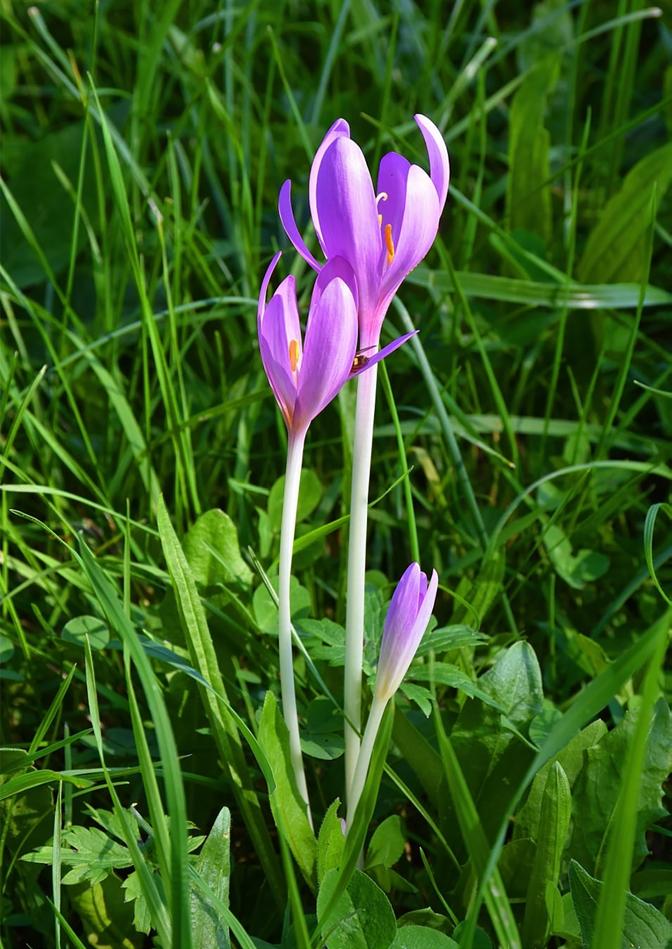
World Mental Health Day is celebrated annually on October 10th. This day provides an opportunity for individuals, organizations, and governments to highlight the current need for mental health services and to encourage key stakeholders and organisations to provide sufficient, recovery-oriented mental health care for everyone around the globe.
Year after year, people from all over the world join efforts to continue spreading awareness of mental health difficulties and advocate in support of good practices onmental health and working towards reducing the stigma and negative connotations attached to mental illness.
According to the US National Alliance of Mental Illness (NAMI), having a strong support network is essential to improving a Person’s Mental Health. It is in this aspect where organisations and services like Clubhouse are crucial safety nets for those who may be experiencing loneliness and isolation.
Studies show that people who struggle with loneliness can often experience depression symptoms like suicidal ideation, increases stress, changes in sleep and eating, etc.
Clubhouses aid their members to navigate their negative feelings and emotions by providing a supportive and collaborative environment through the work ordered day. Through the work at the different units, members connect with one another, increasing social interactions, offering a safe environment where their needs are understood, respected, and embraced. It also offers a purpose and prospective journey towards the goal of autonomy and independency, and the possibility to build skills and confidence in the career path desired.
This year, for World Mental Health Day, Clubhouse International is focusing on the community aspect of the Clubhouse Model, spreading awareness with their campaigns to inform the public that mental health is a Human Right that concerns everyone.

El Día Mundial de la Salud Mental se celebra anualmente el 10 de octubre. Este día brinda a particulares, organizaciones y gobiernos la oportunidad de poner de relieve la necesidad actual de servicios de salud mental y animar a las principales partes interesadas y organizaciones a proporcionar una atención de salud mental suficiente y orientada a la recuperación a todas las personas del mundo.
Año tras año, personas de todo el mundo aúnan esfuerzos para seguir difundiendo la concienciación sobre las dificultades de la salud mental y abogan por apoyar las buenas prácticas en materia de salud mental y trabajar para reducir el estigma y las connotaciones negativas asociadas a las enfermedades mentales.
Según la Alianza Nacional de Enfermedades Mentales (NAMI) de EE.UU., contar con una sólida red de apoyo es esencial para mejorar la salud mental de una persona. Es en este aspecto donde organizaciones y servicios como Clubhouse son redes de seguridad cruciales para quienes puedan estar experimentando soledad y aislamiento.
Los estudios demuestran que las personas que luchan contra la soledad pueden experimentar a menudo síntomas de depresión como ideación suicida, aumento del estrés, cambios en el sueño y la alimentación, etc.
Los Clubhouses ayudan a sus miembros a navegar por sus sentimientos y emociones negativas proporcionándoles un entorno de apoyo y colaboración a través de la jornada de trabajo ordenada. A través del trabajo en las diferentes unidades, los miembros conectan entre sí, aumentando las interacciones sociales, ofreciendo un entorno seguro donde sus necesidades son comprendidas, respetadas y abrazadas. También ofrece un propósito y un camino prospectivo hacia la meta de la autonomía y la independencia, y la posibilidad de desarrollar habilidades y confianza en la trayectoria profesional deseada. Este año, para el Día Mundial de la Salud Mental, Clubhouse International se centra en el aspecto comunitario del Modelo Clubhouse, difundiendo la concienciación con sus campañas para informar al público de que la salud mental es un Derecho Humano que concierne a todos.

Recyclable?
No.
How long does it take to decompose:
Up to 1000 years.
Alternatives:
Bowl on a plate.
Reusable silicone lids.
Tupperware.
Beeswax food wraps.
¿Reciclable?
No
¿Cuánto tiempo tardan en descomponerse?
Hasta 1.000 años.
Alternativas:
Usar un plato como tapadera.
Tapas de silicona.
Contenedores.
Envolturas de comida de cera de abejas.

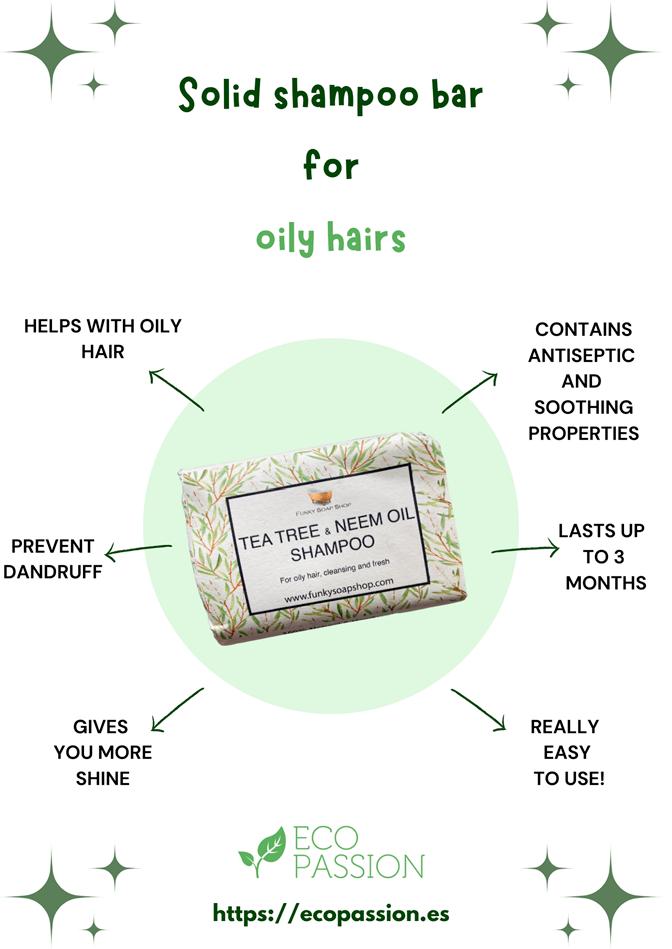
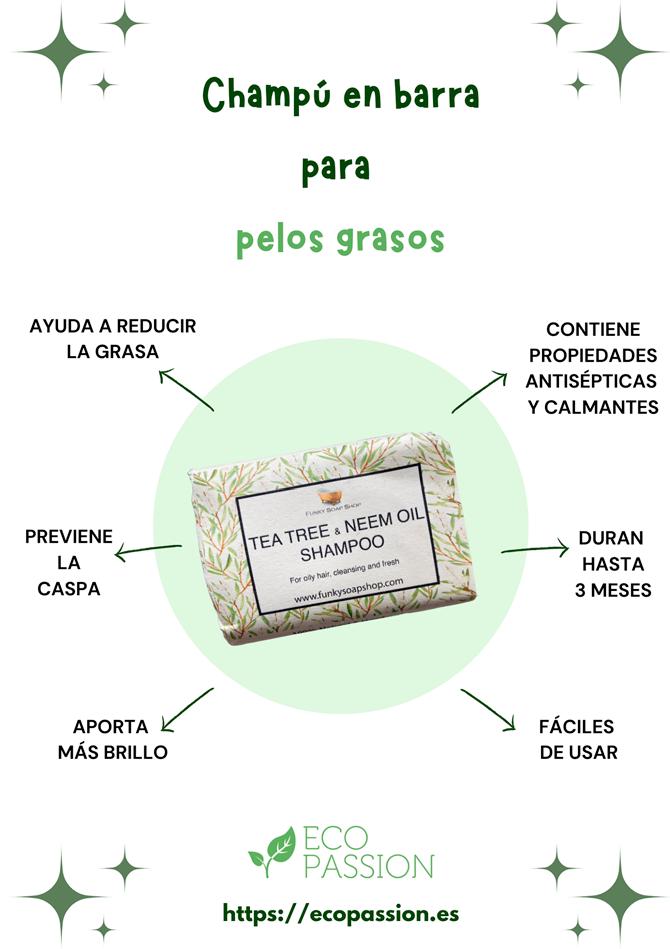
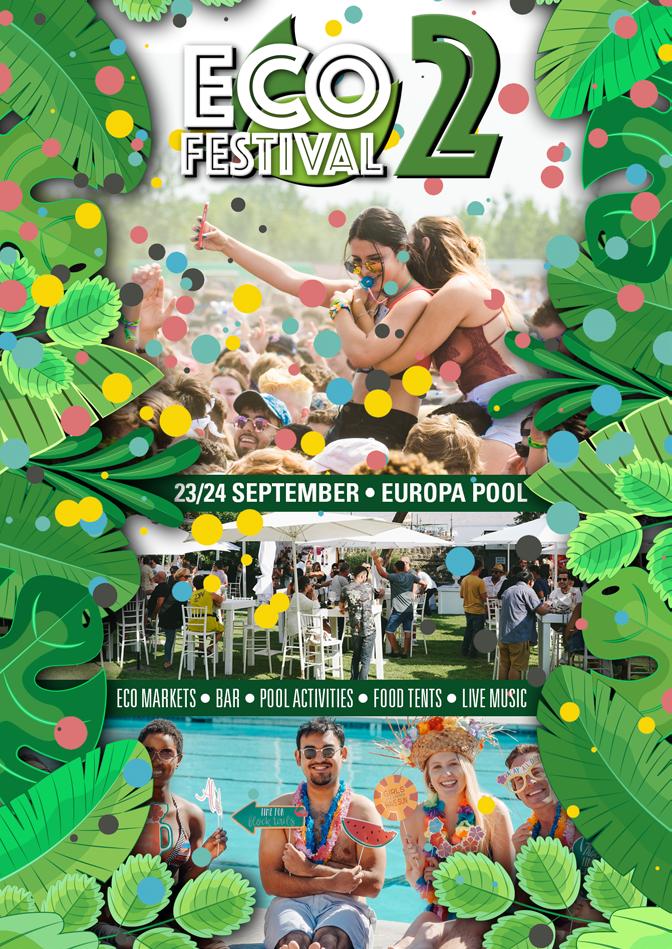

Organized by: OTWO Magazine
Tel. +350 54001271
info@otwomag.com
Transport available for groups. Check with us for your requirements. OTWO is a facilitator on these packages.
All activities are contracted directly between the respective centre operator and the client.
Prices are for the month of September, only please contact us for other dates.
Transporte disponible para grupos. Consultenos si estás interesado. OTWO es un mediador de estos paquetes. Todas las actividades se contratan directamente entre el operador y el cliente.
Precios válidos solo para el mes de septiembre, consulte para otras fechas.

Our adventure takes place in one of the most emblematic Natural Parks of Andalusia: Los Alcornocales Natural Park. Located in the municipality of Cortes de la Frontera. This canyon is known as the Cathedral of the Andalusian canyons.
The canyoning consists of the descent of a river, normally in its high section, where due to the erosion it models the river with very diverse forms where we will have to improvise handrails, jumps or rappels.
It is valued as a level 2 canyon, due to its duration, physical and technical hardness. This canyon is considered as the cathedral of the canyons of Andalusia due to its spectacular and verticality of its walls.
For the adventure, we will have all the necessary technical material: 5 mm wetsuits, harness, helmet, and collective technical material for the descent.
The Ravine
The Guadiario River as it passes through Cortes de la Frontera has excavated an impressive canyon known as "Las Buitreras". Its name is due to the high population of vultures that nest in its entrances. We start with a vertiginous downhill trail to the Puente de los Alemanes. The adventure is a constant climbing, rappelling, sliding, jumping...
It carries water even in summer and you have to swim for several stretches. During the tour, we will pass through areas so narrow and closed that we will go practically in the dark.
It is necessary to carry food in the watertight boats to replenish strength. With a final trail of 40 minutes will take us to the vehicles near the power plant of El Colmenar.
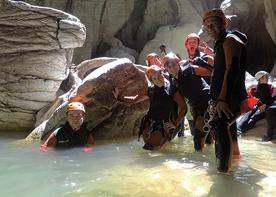
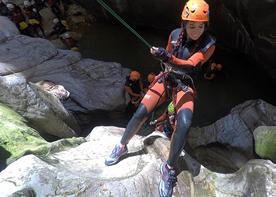
Duration Canyoning: 6 to 7 hours. Minimum/Maximum participants: 6/10 participants.
Recommended Dates:
Late spring, summer and early fall.
Services: Specialized monitors and equipment. All technical material. First aid kit. RC and accident insurance. Photographic and video coverage.
Prices Complete adventure..........55 €
Nuestra aventura se realiza en uno de los Parques Naturales más emblemáticos de Andalucía: Parque Natural de los Alcornocales. Situado en el municipio de Cortes de la Frontera. Este barranco es conocido como La Catedral delos barrancos de Andalucía.
El barranquismo consiste en el descenso de un río, normalmente en su tramo alto, donde debido a la erosión modela el río con formas muy diversas donde tendremos que improvisar pasamanos, saltos o ráppeles.
Está valorado como un barranco de nivel 2, debido a la duracíón, dureza física y técnica del mismo. Este cañón es considerado como la catedral de los ba-rrancos de Andalucía debido a su espec-tacularidad y verticalidad de sus paredes.
Para la aventura se dipondrá de todo el material técnico necesario: neoprenos 5 mm, arnés, casco, y material técnico colectivo para el descenso.
El Río Guadiario a su paso por Cortes de la Frontera ha excavado un cañón impresionante conocido como el de “Las Buitreras”. Su nombre se debe a la alta población de buitres que anidan en sus entrantes.
Comenzamos con un sendero vertiginoso de bajada hasta el Puente de los Alemanes. La aventura es un constante trepar, rapelar, toboganear, saltar… Lleva agua incluso en verano y hay que nadar durante varios tramos. Durante el recorrido pasaremos por zonas tan estrechas y cerradas que iremos prácticamente a oscuras.
Es necesario llevar comida en los botes estancos para reponer fuerzas. Con un sendero final de 40 minutos nos llevará a los vehículos cerca de la central eléctrica de El Colmenar.
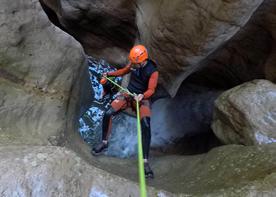
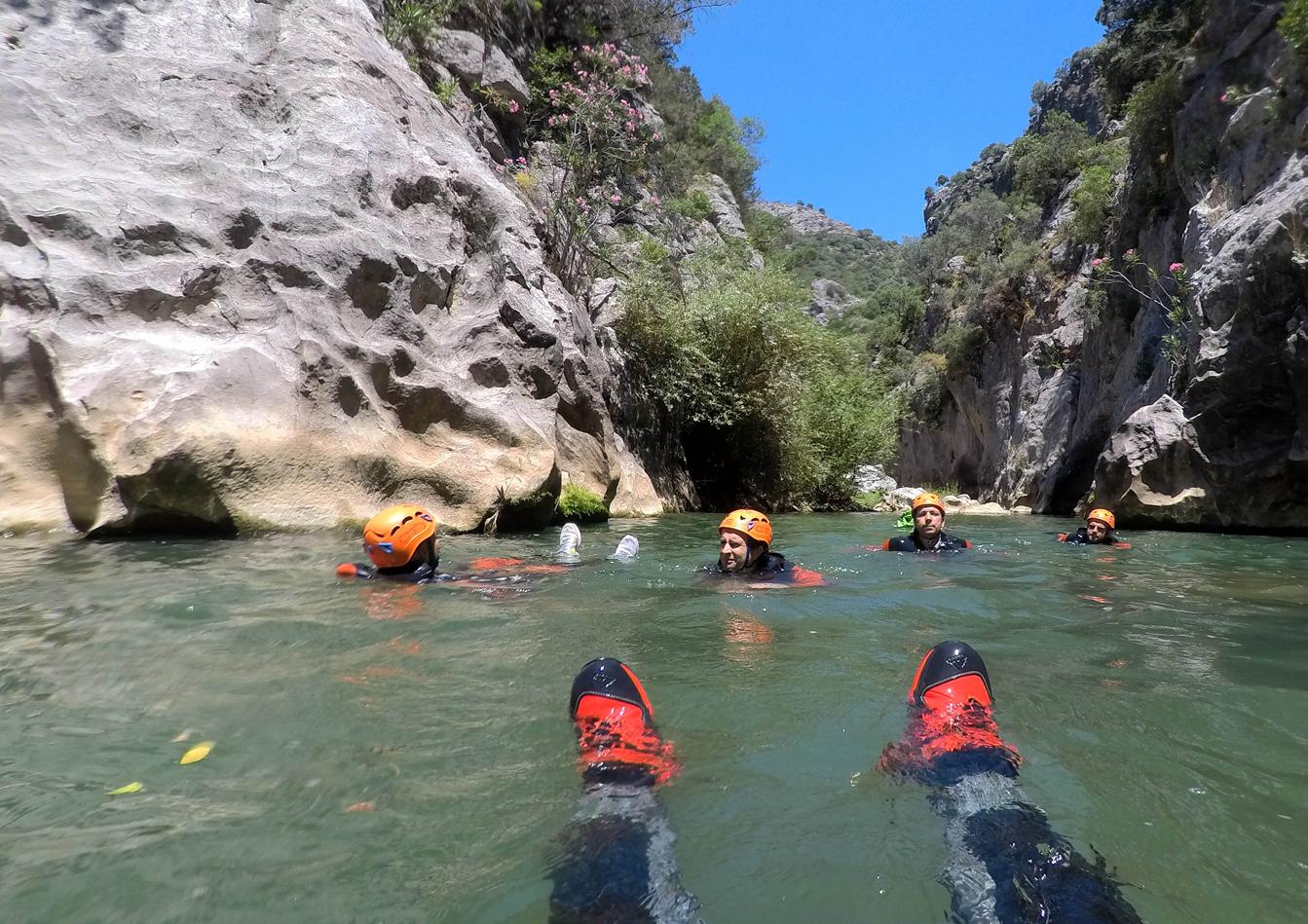
Duración Barranquismo: 6 a 7 horas Mínimo/Máximo de participantes: 6/10 participantes.
Fechas Recomendadas: Finales de final de primavera, verano y principios de otoño. Servicios: Monitores y equipos especializados. Todo el material técnico. Botiquín primeros auxilios. Seguros RC y Accidentes. Reportaje fotográfico.
Precios aventura completa……….55 €

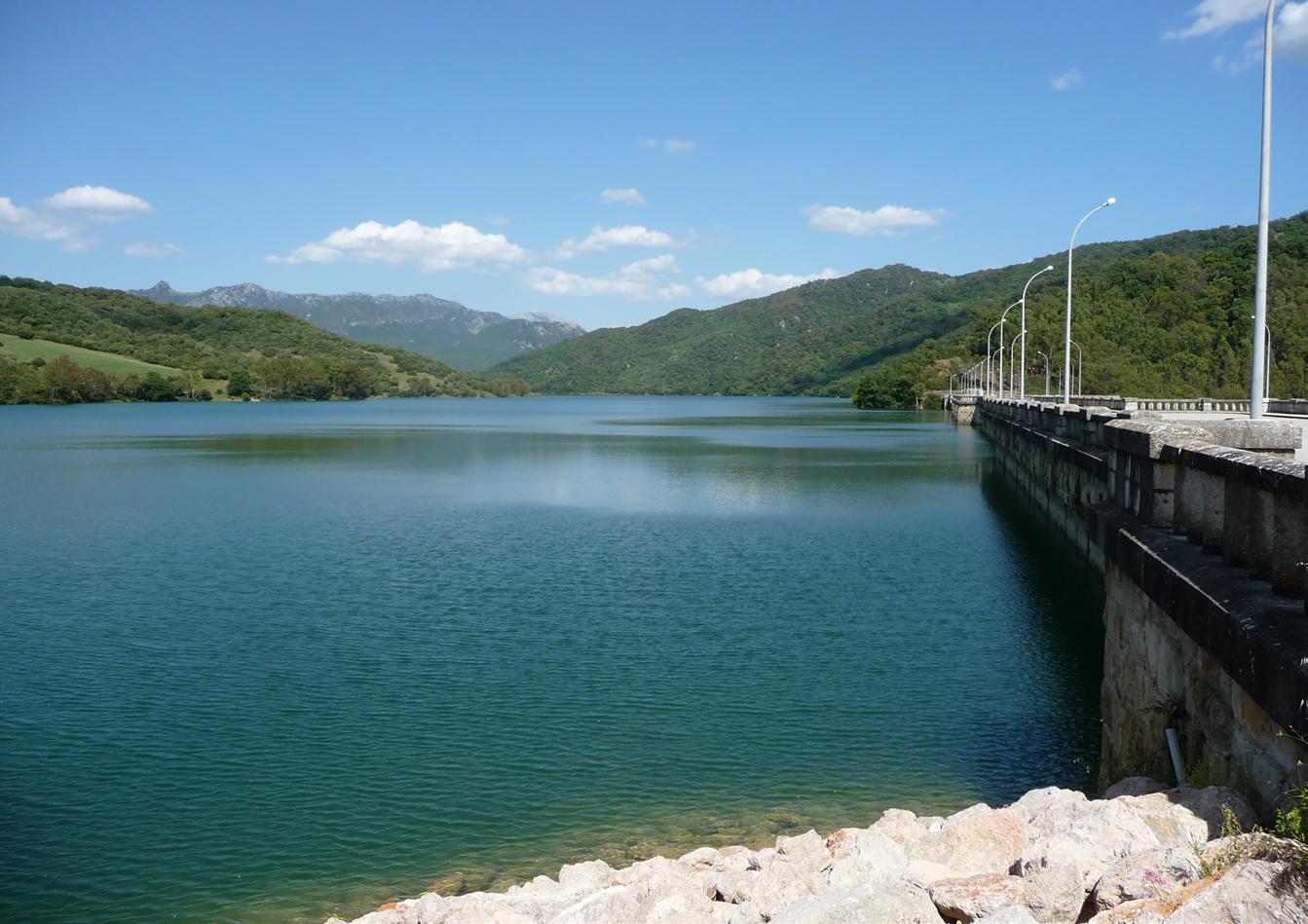
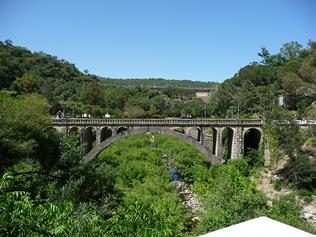
The reservoir and the village of Los Hurones was created in 1964, a hidden gem in the middle of nature, which supplies drinking water, electricity, and irrigation to the urban centers of the province of Cadiz. It might seem that we are in a Canadian place for the density of its forest or in a Galician village for its similarity in architecture, the houses that form this small village were used by employees and technicians who worked in the execution of this dam.
But we are in Cadiz, specifically the term of San Jose del Valle, near Algar and the towns of El Bosque and Ubrique.
We will make a route of about 10 kilometers with a low / medium difficulty, we will know the flora, fauna, and bathing place where it is impossible not to stop to take a picture because of its beauty, the Majaceite river can be seen in this area with a peculiar charm.
Arriving at the village we will also see the three institutions that are still preserved, hospital, school, and church dedicated to the Virgen del Pilar, we will cross the bridge, from which you can already see the impressive height of the dam, which collects almost 900 hectares with a capacity of 135 cubic hectometers that flows into the reservoir of Guadalcacín.
We will have lunch at Venta El Pantano, a place that persists over time thanks to the quality of its dishes and the attention of its employees, we can buy local products such as the famous village bread, molletes, sweets, olives and many more…
After lunch, we will go up to the dam to walk around it, see the grandeur of that territory and learn how it works.
From there and looking closely at the village it seems that the place resembles a traditional Christmas nativity scene because of the physiognomy of its houses and the environment.
You cannot miss the history behind this hidden paradise in the Natural Park Los Alcornocales.
El pantano y el poblado de Los Hurones se creó en el año 1964, una joya escondida en medio de la naturaleza, que abastece de agua potable, electricidad y riego a los núcleos urbanos de la provincia de Cádiz.
Podría parecer que nos encontramos en un paraje canadiense por la densidad de su bosque o en un pueblo gallego por su semejanza en la arquitectura, las casas que forman esta pequeña aldea fueron utilizadas por los empleados y técnicos que trabajaron en la ejecución de esta presa.
Pero estamos en Cádiz, concretamente el término de San José del Valle, próximo a Algar y a las poblaciones de El Bosque y Ubrique.
Realizaremos una ruta de unos 10 kilómetros con una dificultad baja/media, conoceremos la flora, fauna y lugar de baños donde es imposible no pararse a tomar una foto debido a su belleza, el rio Majaceite se deja ver en esta zona con un encanto peculiar.
Al llegar al poblado además veremos las tres instituciones que aún se conservan, hospital, colegio e iglesia dedicada a la Virgen del Pilar, cruzaremos el puente, desde el que ya se puede ver la impresionante altura de la presa, que recoge casi 900 hectáreas con una capacidad de 135 hectómetros cúbicos que desemboca en el embalse de Guadalcacín.
Haremos el almuerzo en la Venta El Pantano, un lugar que persiste en el tiempo gracias a la calidad de sus platos y la atención de sus empleados, podremos comprar productos de la tierra como el famoso pan de pueblo, molletes, dulces, aceitunas y un largo etc…
Tras la sobremesa, subiremos a la presa para pasear por ella, divisar la grandeza de aquel territorio y conocer el funcionamiento de esta.
Desde ahí y fijándote bien en el poblado pareciese que el lugar se asemeja por la fisionomía de sus casas y el entorno a un belén tradicional de Navidad No puedes perderte la historia que hay detrás de este paraíso escondido en pleno Parque Natural Los Alcornocales.
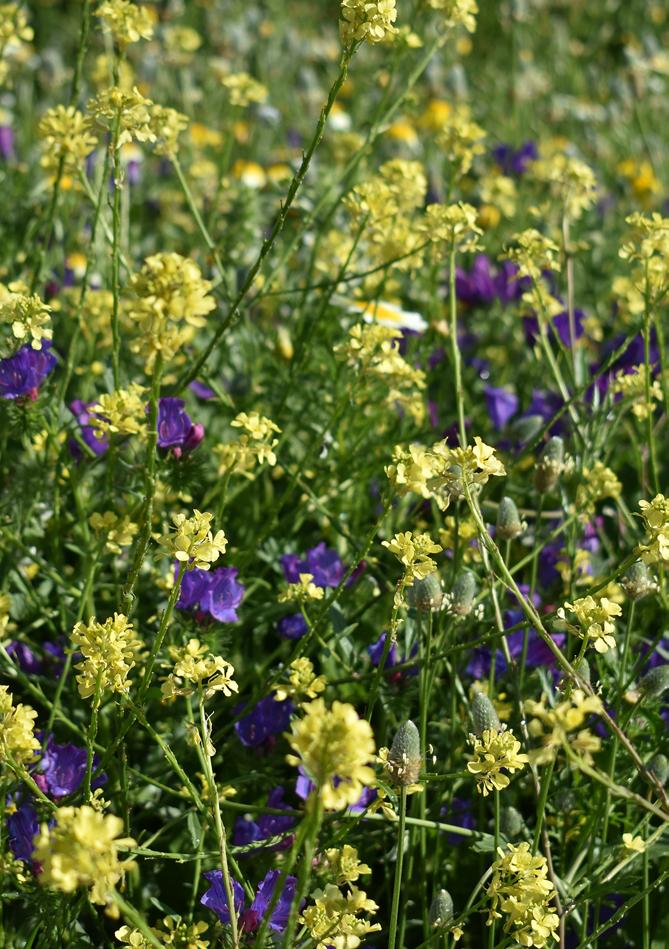
The Centennial Park, with an extension of 11 hectares has valuable elements of historical and cultural heritage of the city of Algeciras.
It is located within the boundaries of the "Intercontinental Biosphere Reserve of the Mediterranean Andalusia-Morocco" this reserve extends through some of the most emblematic territories of the provinces of Cadiz and Malaga in Spain and the provinces of Tangier, Tetuan, Larache and Chefchaouen in northern Morocco.
Of great importance, a part of the coastline is dominated by the flysch, a geological phenomenon created millions of years ago from the whims of an earth that decided to twist and play with the laws of physics in its own way, produced by the tectonic movements of the intercontinental plates.
A park where we can admire flora, wild olive, cork oak, Moorish gorse, jerguen, gall oak and its fauna, such as crustaceans Orchestia mediterranea and Tylos sardous, lizards, snake necklace, common bat, brown rat, sandpipers, terns and herons among others, as its location makes it an important place to observe the passage of migratory birds, as well as cetaceans, and a splendid view of the coast of the neighboring continent.
On the left side we are accompanied by the Chinarral which has fine sands and calm waters sheltered by a small inlet. The bottom of its waters is largely rocky highlighting several reefs a few meters
from the coast known as Las Hermanas, very dangerous for navigation, and to the right of the Getares inlet is the Getares beach whose sands, of fine thickness, come mainly from the contributions of the many seasonal streams that flow into the area and in particular the river Pícaro that formed in the past a marsh and a dune arrow.
For our route it is necessary to wear appropriate clothing for the terrain and the weather. We will start this trail by visiting the Interpretation Center of the Intercontinental Biosphere Reserve of the Mediterranean "Strait of Gibraltar" at the entrance of the park.
At the edge of the coast we will find four viewpoints where we will take some pictures of the spectacular views, a few meters away, in the rest area, we will observe the flysch and listen to the explanation of how they were formed.
If we are lucky we will be able to observe some dolphins dancing in the waters of the Bay of Algeciras and enjoy some of their jumps.
Moving forward, we will go back in time visiting historical sites of the park such as the 16th century watchtower, ruins of the fort of San Garcia, machine gun nests and bunker.
Before continuing we will climb the iron lookout tower from where we can have a 360º view of the city and its surroundings.
We will finish the trail at the entrance of the park, where we can enjoy a refreshment or coffee in its facilities.
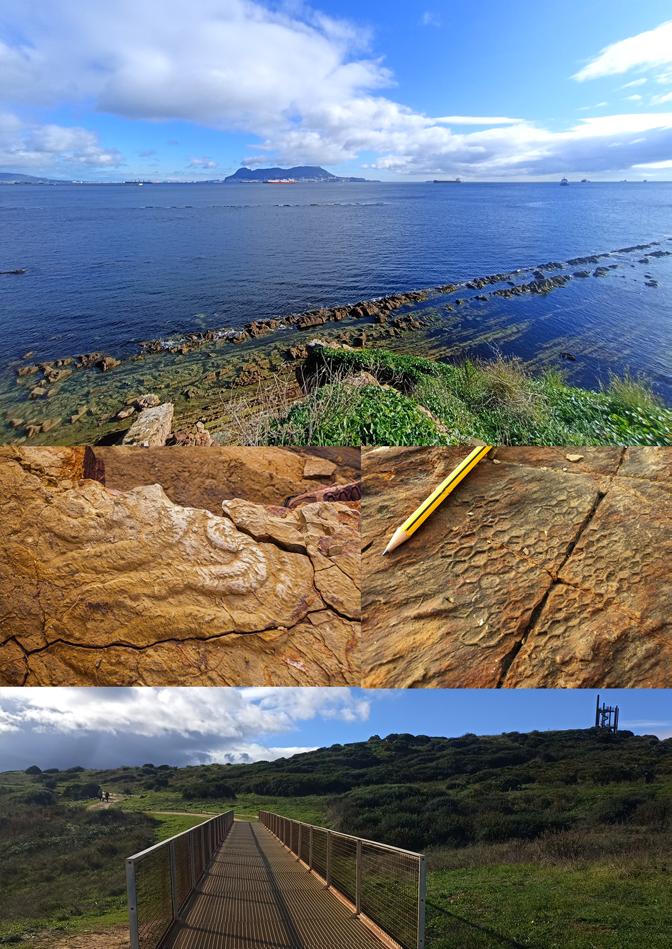

El parque del Centenario, con una extensión de 11 hectáreas cuenta con valiosos elementos del patrimonio histórico y cultural de la ciudad de Algeciras.
Se encuentra dentro de los límites de la «Reserva de la Biosfera Intercontinental del Mediterráneo Andalucía-Marruecos» esta reserva se extiende por algunos de los territorios más emblemáticos de las provincias de Cádiz y Málaga, en España y de las provincias de Tánger, Tetuán, Larache y Chefchaouen en el Norte de Marruecos.
De gran importancia, una parte de la costa la protagonizan los flysch, un fenómeno geológico creado hace millones de años a partir de los caprichos de una tierra que decidió retorcerse y jugar con las leyes de la física a su manera, producida por los movimientos tectónicos de las placas intercontinentales.
Un parque en el que podremos admirar flora, acebuche, alcornoque, aulaga morisca, jerguen, quejigo y su fauna, como crustáceos Orchestia mediterránea y Tylos sardous, lagartijas, culebra de collar, murciélago común, rata parda, correlimos, charranes y garzas entre otras, ya que su situación hace que sea un lugar importante para la observación del paso de las aves migratorias, así como de los cetáceos, y una espléndida visión de la costa del continente vecino. Al lado izquierdo nos acompaña el Chinarral que posee arenas finas y aguas tranquilas al abrigo de una pequeña ensenada. El fondo de sus aguas es en gran parte rocoso destacando varios arrecifes a unos metros de la costa conocidos como Las Hermanas, muy peligrosos para la navegación, y a la derecha
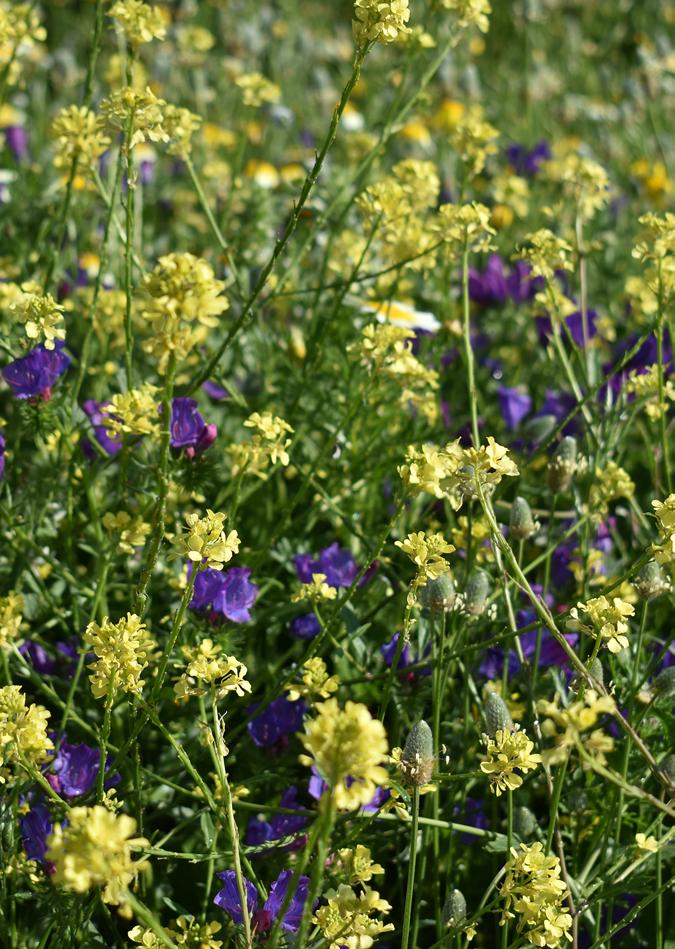
de la ensenada de Getares se encuentra la playa de Getares cuyas arenas, de fino grosor, proceden principalmente de las aportaciones de los numerosos arroyos estacionales que desembocan en la zona y en particular del río Pícaro que formó en el pasado una marisma y una flecha dunar.
Para nuestra ruta es necesario llevar ropa adecuada al terrero y a la climatología, iniciaremos este sendero visitando en la entrada del parque el Centro de Interpretación de la Reserva de la Biosfera Intercontinental del Mediterráneo «Estrecho de Gibraltar».
Al borde de la costa nos encontraremos con cuatros miradores donde tomaremos algunas fotos de las espectaculares vistas, a escasos metros, en el área de descanso, observaremos los flysch y escucharemos la explicación de cómo se formaron. Con suerte podremos observar algún delfín danzando en las aguas de la Bahía de Algeciras y obsequiarnos con algunas de sus saltos.
Adelantando nuestros pasos, retrocederemos en el tiempo visitando lugares históricos del parque como son la torre almenara del siglo XVI, ruinas del fuerte de San García, nidos de ametralladores y bunker.
Antes de continuar subiremos a la Torre mirador de hierro desde donde podremos tener una visión de 360º de la ciudad y su entorno.
Finalizaremos el sendero en la entrada del parque, donde podremos disfrutar de un refresco o café en sus instalaciones.

Gibraltar
Enjoy breath taking views across 3 countries and 2 continents, explore Gibraltar’s fascinating history and be introduced to our most famous inhabitants, the Barbary macaques – the only free roaming monkeys in Europe!
Price: £69 per person.
Highlights
Europa Point and Lighthouse. Upper Rock Nature Reserve.
Pillars of Hercules Monument.
Windsor Suspension Bridge. O’Hara’s Battery (top of Rock 424m). Skywalk.
Ape’s Den.
Great Siege Tunnels. Moorish Castle. …And many more.
What’s included?
Premium e-bike by Riese&Müller. Cycle helmet. Safety instructions.
Entrance fee into the Nature Reserve. An official tour guide. Bottled water.
DURATION:
3 hours. Suitable for everyone over 155 cm, over 12 years old and capable of riding a bicycle.
Gibraltar
Disfrute de las impresionantes vistas de 3 países y 2 continentes, explore la fascinante historia de Gibraltar y conozca a nuestros habitantes más famosos, los macacos de Berbería, ¡los únicos monos que se desplazan libremente en Europa!
Precio: £69 por persona.
Puntos destacados
Punta de Europa y el Faro
Reserva Natural Upper Rock (Parte superior del peñon)
Monumento de las Columnas de Hércules
Puente colgante de Windsor
Bateria de O’Hara (parte superior del peñon - 424m).
El Skywalk
Guarida de los monos
Gran túneles de asedio
Castillo Arabé. …y muchos más
¿Qué está incluido?
Alta calidad E-bike de Riese&Müller. Casco de bicicleta
Instrucciónes de seguridad
Entrada a la reserva natural Guía oficial Agua embotellada.
DURACIÓN:
3 horas. Adecuadas para todos los que midan más de 155 cm, tengan más de 12 años de edad y puedan montar en bicicleta.

The Hozgarganta River, one of the many charms of the town of Jimena de la Frontera, the Roman road, the viewpoint of the Asomadillas, the Royal Pump Factory ... these are places that will be present on this route, thus enjoying, in addition to the nature of a few moments of historical and cultural content.
We will be able to see a diversity of birds and highlight the presence of wild orchids on our way in addition to the rich diversity of flora in the area.
Location: Municipal district of Jimena de la Frontera.
Duration: 3 hours approximately.
Distance: 9 km approx.
Starting point: Parking lot of Los Alcornocales campsite.
Clothing and footwear: comfortable clothing and footwear.
Authorization: No.
Route: Circular.
Difficulty: Low (suitable for children from 6 years old)
Date: Spring, autumn and winter.
Price: 10£.
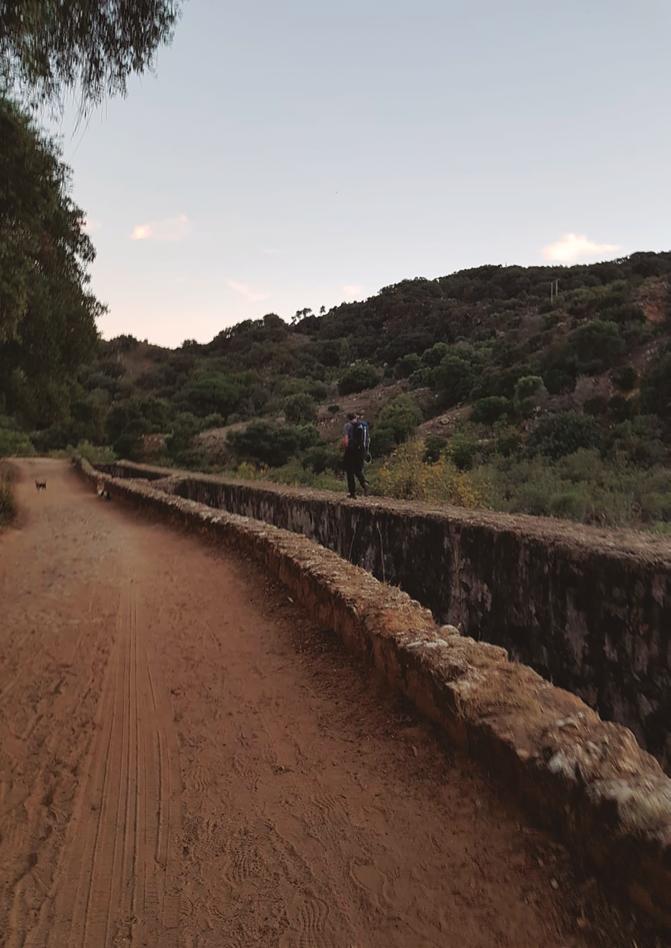
El Rio Hozgarganta, uno de los muchos encantos de la población de Jimena de la Frontera, la calzada romana, el mirador de las Asomadillas, la Real Fábrica de Bombas …son lugares que van a estar presentes en esta ruta, disfrutando así, además de la Naturaleza de unos momentos de contenido histórico y cultural.
Podremos avistar diversidad de aves y destacar la presencia de orquídeas silvestres en nuestro camino además de la rica diversidad de flora de la zona.
Localización: Término municipal de Jimena de la Frontera.
Duración: 3 horas aproximadas.
Distancia: 9 km aproximados.
Lugar de partida: Aparcamiento del camping Los Alcornocales.
Ropa y calzado: vestimenta y calzado de campo
Autorización: No.
Ruta: Circular.
Dificultad: Baja (apta para niños a partir de 6 años).
Fecha: primavera, otoño e invierno.
Precio: 10£.
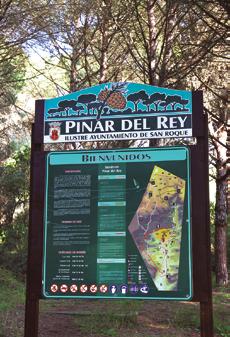
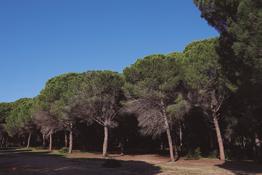
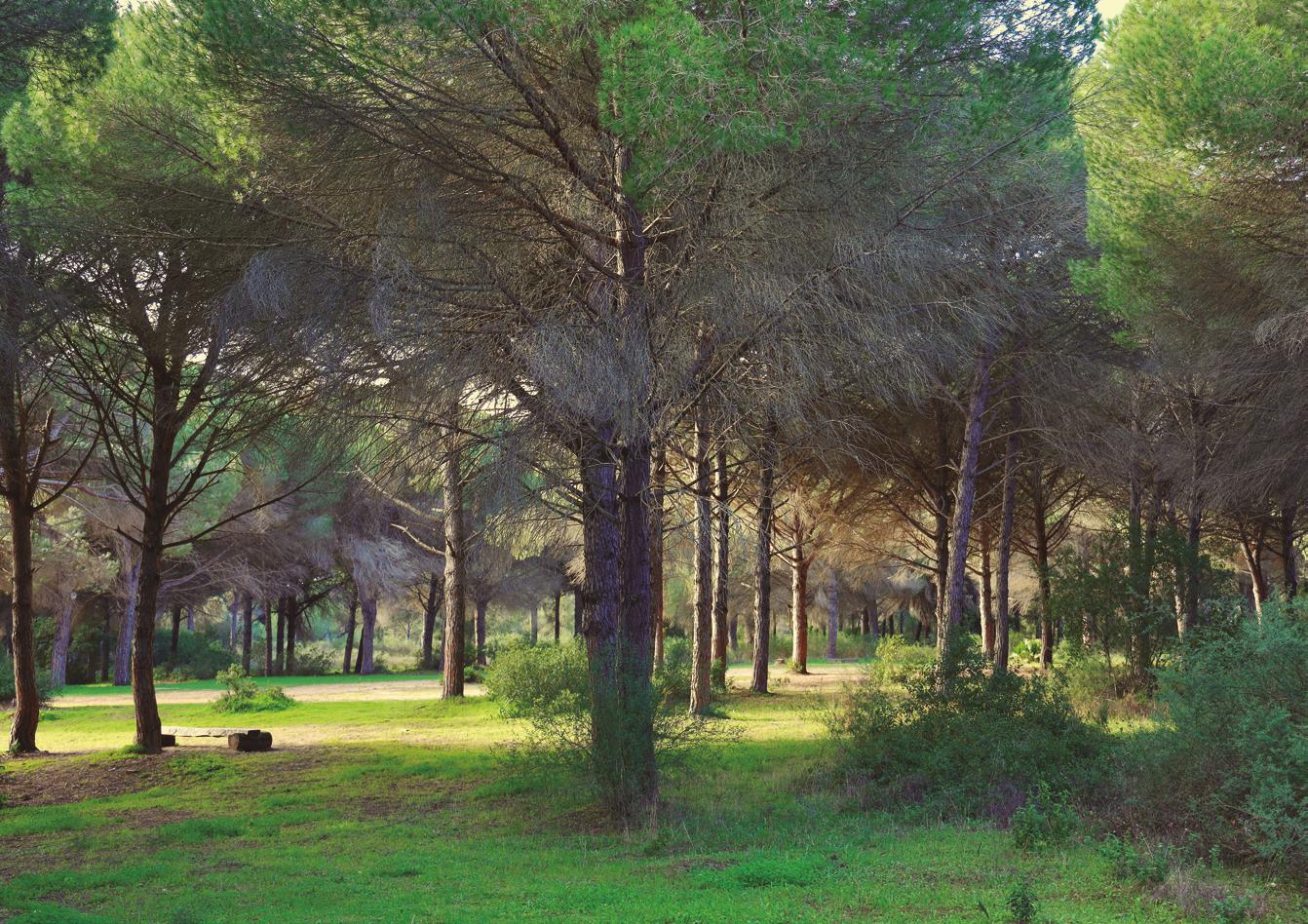
In the Natural Park Los Alcornocales, the Pinar del Rey is located between the municipalities of San Roque and Castellar de la Frontera, in Cadiz.
Its origin dates back to 1800, this place was chosen to plant pine trees (Pinus Pinea) brought from Vejer de la Frontera, and thus obtain wood for the construction of ships.
It currently consists of a recreational area with a picnic area and barbecues, the Alhaja stream, the Nature Classroom and a botanical garden. In addition, there are two trails: El Cerro del Águila and Tajo del Pajarraco.
A peculiar place, with a mild climate, and a migratory bird route. Its environmental conditions make it a paradise for flora. We can even see some plants that only occur in northern Spain and the Canary Islands. We will walk through a mixed forest, with cork oaks, gall oaks, poplars, alders and ash trees, with a wide variety of botanical species, some of them endangered. In addition, of course we will discover its rich and varied fauna.
In addition, the Pinar del Rey, was part of a sandy seabed settlement, so we can easily find shells and marine pieces.
Discover the cumulative effect that nature has, the nuances in you had never noticed, the calm that offers a place with so much magic.
To begin the activity we will leave the car at the end of the parking lot of the recreational area of Pinar del Rey (San Roque), it is important to bring water, sunscreen, (optional mat for floor and camera).
Duration: 2 to 3 hours.
Minimum and maximum number of participants: 5 to 15 people
Dates: Any season of the year. Maximum distance: 2 kilometers.
Important: Notify any food allergies.
Prices: 20£ /person. (RC and accident insurance included).
En el Parque Natural Los Alcornocales, se ubica el Pinar del Rey entre los términos municipales de San Roque y Castellar de la Frontera, en Cádiz.
Su origen se remonta a 1800, este lugar fue elegido para plantar ejemplares de pinos piñoneros (Pinus Pinea) traídos desde Vejer de la Frontera, y obtener así madera para la construcción de navíos.
Actualmente consta de un área recreativa con una zona de picnic y barbacoas, el arroyo de Alhaja, el Aula de Naturaleza y un jardín botánico. Además, existen dos senderos: El Cerro del Águila y el Tajo del Pajarraco.
Un lugar peculiar, de clima suave, y paso de ruta de aves migratorias. Sus condiciones ambientales lo convierten en un paraíso para la flora. Incluso podemos ver algunas plantas que únicamente se dan en el norte de España y en las Islas Canarias. Recorreremos un bosque mixto, con alcornoques, quejigos, álamos, alisos y fresnos, con una extensa variedad de especies botánicas, algunas de ellas amenazadas. Y por supuesto descubriremos su rica y variada fauna.
Además, el Pinar del Rey, formó parte de un asentamiento arenoso de fondos marinos, con lo cual podremos encontrar fácilmente conchas y piezas marinas.
Descubre el efecto acumulativo que tiene la naturaleza, los matices en los que nunca te habías fijado, la calma que ofrece un lugar con tanta magia.
Para comenzar la actividad dejaremos el coche al final del aparcamiento de la zona recreativa del Pinar del Rey (San Roque), es importante llevar agua, protección solar, (opcional esterilla para suelo y cámara de fotos).
Duración: 2 a 3 horas.
Mínimo y máximo de participantes:. 5 a 15 personas.
Fechas: Cualquier estación del año. Distancia máxima: 2 kilómetros.
Importante: Informar de alergias alimenticias .
Precios: 20£ /persona.
(Seguro RC y accidentes incluidos),
Photographs: Juan Luis González
The treatment, cure, and care provided to deal with some evil or disease was known to the Greeks as therapeia. Our word “treatment” is derived from this. It is normal for someone to wonder how they will administer the forest to them if we add it. Will it be in pills, syrups, or serum? It doesn’t harm, so don’t worry. Even with all the humor, individuals who read us need to understand that we lead the individual to a total immersion in Nature, in some type of natural habitat, preferably woods.
Using the forest as therapy means that we will use the benefits provided by Nature as a way to intervene in people’s health. Not only in their physical health, but also in their mental and social health; even, for those who so wish, in their spiritual health.
Each of these people has a specific need, or a specific health problem, or a personal difficulty. Taking into account these personal needs, we will try to find the most concise way to repair it, doing it in a structured way.
The approach of the Forest Baths is always therapeutic. The professionals who are dedicated to the Forest Baths are trained to be able to collaborate with guarantees with health professionals, making available to the general public, to the Institutions, all the set of interventions that we have.
What are we talking about then? We are talking about promoting healthy lifestyles, those that improve our quality of life. We are talking about relieving the day-to-day stress in which we live. We are also talking about preventing or dealing with burnout, that which is caused by work and production. Finally, we talk about more specific interventions on the health of any person, always under supervision.
Los griegos llamaban therapeia al remedio, al tratamiento, a los cuidados para hacer frente a algún mal, a alguna enfermedad. De ahí viene nuestra palabra terapia. Si le añadimos lo del bosque es normal que alguien pueda pensar, ¿cómo me van a dar el bosque?, ¿en pastillas, jarabes, lo tendrán en suero? No se preocupen, no duele. Bromas aparte, lo que tienen que saber los que nos lean es que llevamos a la persona a realizar una inmersión completa, mente y cuerpo, en la Naturaleza, en algún tipo de entorno natural, especialmente los bosques.
Usar el bosque como terapia significa que utilizaremos los beneficios que procuran la Naturaleza, como una forma de intervenir en la salud de las personas. No solo en su salud física, también en la mental y en la social; incluso, para los que así lo deseen, en la salud espiritual. Cada una de esas personas tiene una necesidad específica, o un problema de salud concreto, o alguna dificultad personal. Teniendo en cuenta estas necesidades personales trataremos de buscar la forma más concisa de repararlo, haciéndolo de manera estructurada.
El enfoque de los Baños de Bosque es siempre terapéutico. Los profesionales que nos dedicamos a los Baños de Bosque estamos formados para poder colaborar con garantías con los profesionales de salud, poniendo a disposición del público en general, de las Instituciones, todo el conjunto de intervenciones que tenemos.
¿De qué estamos hablando entonces? Hablamos de promover estilos de vida saludables, de eso que mejoran nuestra calidad de vida. Hablamos de aliviar el estrés del día a día en el que vivimos. Hablamos también de prevenir o hacer frente al burnout, ése que nos provoca el trabajo y la producción. Hablamos, por último, de intervenciones más específicas sobre la salud de cualquier persona siempre bajo supervisión.
